#but based on the fact that the family still operates the same in the film (after ana and her friends encounter them)
Text
the fact that maria's disappearance has remained a cold case for decades... once ana & her friends died looking for her, they became cold cases too... ana & maria's mom alone after losing both of her daughters, not knowing (for the better, maybe) what cruelty took them from her.
hurts thinking how the victims go looking for maria, what they end up enduring, just to find her long gone (presumably) at black nancy's... the guilt ana would feel for bringing them there, knowing they're going to meet the same fate, that their families won't know what happened.
and of course, how could ana have known? who could have ever thought such horrors awaited them as they set up their camp site in the thicket? as they put up their tent, lit a fire and sat around together, sharing stories about maria and thinking they're close to finding her alive.
#my copium hc is that the victims all live and fall in love and help each other heal after their encounter w the slaughters#buuut my more realistic hc is that they all end up dying looking for maria#i know its not confirmed that they all die and ana may actually live#but based on the fact that the family still operates the same in the film (after ana and her friends encounter them)#and the way marias tribute instagram is handled by a family member of ana and maria and mentions them going through anas old things#it makes me feel like they may all end up dead#who knows!! anyway this is where they all die#tcm#texas chainsaw massacre#texas chainsaw massacre game#leland mckinney#connie taylor#julie crawford#ana flores#maria flores
61 notes
·
View notes
Text

“The Zone of Interest”
“The Zone of Interest” 2023 War/Crime is not like other Holocaust films. Yet it is still rooted firmly in historical realities about the Holocaust and the minute details of how the Hösses lived comfortably alongside it, ignoring the mass suffering their father was orchestrating. The real Auschwitz commandant Rudolf Höss, and his wife, Hedwig, strive to build a dream life for their family in a house and garden next to the camp.
Directed by British filmmaker Jonathan Glazer, Glazer and his team did years of research before filming to capture the tonal disconnect of the moment, in perhaps cinematic distillation yet of German philosopher Hannah Arendt’s famous proclamation about “the banality of evil.” The film initially appears to follow an unexceptional German family in the 1940s and their idyllic lifestyle in a cute cottage near a river. A father (Christian Friedel), a mother (Sandra Hüller) and their five children host parties, go swimming, tend to their garden and read bedtime stories at night.
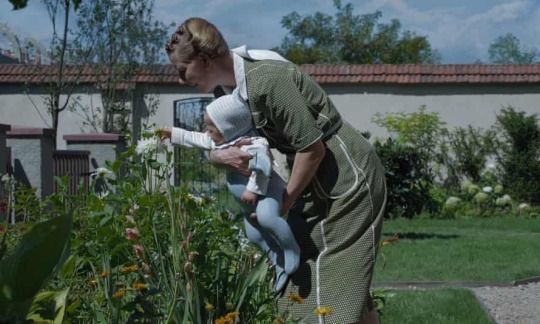
Sandra Hüller as Hedwig Höss: ‘I never planned to portray someone like her.’ Photograph: Courtesy of A24 / Mica Levi
Only gradually does the film reveal that this family’s seemingly idyllic home is located directly adjacent to the Auschwitz death camp — and that the patriarch is none other than Rudolf Höss, that camp’s real-life commandant, who directly oversaw the systematic murder of more than a million Jews, and perhaps many more.
Audiences never see these murders, but they hear the horrific evidence of the slaughter: screams, gunshots and the machinery of the gas chambers.

A scene from ''The Zone of Interest'' (credit: Courtesy of A24) A garden party in Jonathan Glazer's chilling film (A24 / YouTube)
Glazer, whose previous films include “Under the Skin,” “Sexy Beast” and “Birth,” adapted his script for “The Zone of Interest” based on the late British author Martin Amis’ 2014 novel of the same title. But the film differs considerably from the novel and has a greater basis in historical fact.
While Amis’ novel followed multiple plotlines, including a love triangle, set in and around Auschwitz, Glazer’s script stripped away everything except the Höss family at its centre. He also made his film about the real Höss family, whereas Amis (who died as the film was premiering at Cannes) had rendered fictional versions of them.
Glazer also went further, hiring researchers at the Auschwitz-Birkenau museum in Poland to look into details of the Höss family’s lifestyle.
The film was shot near the museum, in a formerly dilapidated house that the production crew transformed into a replica of the actual Höss home. He was also, inspired by sources like Timothy Snyder’s “Black Earth: The Holocaust As History And Warning,” and the writings of Gillian Rose.

Zone of Interest film clip –A Höss family garden party in The Zone of Interest. Photograph: A24 Films
Rudolf Höss was the Nazi commandant who oversaw the mass killing operations at Auschwitz-Birkenau, having been posted there from 1940 until nearly the end of the war. Before Auschwitz, Höss — born Catholic and a World War I veteran who became a committed Nazi from the beginning of Hitler’s rise to power — was posted at the Dachau and Sachsenhausen camps, where he learned the tricks of the trade of mass death.
Within the Nazi upper ranks, Rudolf Höss was considered, according to an SS report, a “true pioneer” for his mass-killing innovations at the camp, which became the deadliest site of the war under his watch. After the Final Solution began being implemented in 1941, Höss installed gas chambers and ovens at Auschwitz capable of killing thousands of people every hour and disposing of their bodies; from then on, the camp was a brutally efficient system of death. He was also the one who introduced the poisonous gas Zyklon B to the camps, impressing Adolf Eichmann.

As portrayed in the film, Rudolf Höss was briefly transferred to a more administrative role within the Nazi Party in 1943 — a move that the family gardener has testified angered Rudolf’s wife Hedwig (Sandra Hüller), because she believed the family had everything they needed at Auschwitz. (Glazer has said that his need to understand this argument between the two of them was the driving force behind the film.) However, he was reassigned to the camp the following year to oversee the mass extermination of Hungarian Jewry in an operation named after him.
He went into hiding after the war, but was tracked down by Hanns Alexander, a German Jewish Nazi hunter, and stood trial in Poland in 1947, where he was sentenced to death.
Höss admitted to his role in the genocide in a written statement in which he coldly describes the “improvements” his Auschwitz team made over similar extermination efforts at Treblinka — using the same dispassionate, removed cadence spoken by the film’s version of Höss.
Höss was hanged in Auschwitz at the age of 45, on gallows he himself had ordered constructed at the camp.
The bulk of “The Zone of Interest” focuses not on the mass extermination, but rather on the particulars of Höss’ family life and how this Nazi clan mentally separated the two. As in the film, the real Höss family lived in an impeccably maintained two-story house that bordered Auschwitz: They could see the prisoner blocks and crematoria from their upstairs window.

A scene from "The Zone of Interest" (photo credit: Courtesy of A24) A young girl plays the Yiddish song ‘Sunbeams,’ composed at Auschwitz in Jonathan Glazer’s of Interest.
Rudolf and his wife Hedwig saw themselves as, fulfilling the Nazi ideal. While Rudolf went to work at the camps every morning, Hedwig busied herself with her social life and proudly accepted the moniker of “Queen of Auschwitz.”
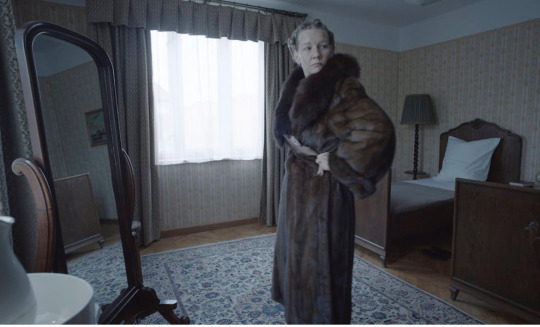
Sandra Hüller as Hedwig Höss in a scene from The Zone of Interest, directed by Jonathan Glazer. A24, via AAP
Historian Thomas Harding wrote about how they stocked their closets with clothes and jewellery seized from the Jews who were exterminated, and with the help of a large waitstaff, including some Auschwitz prisoners, they kept a garden, often entertained guests and swam and canoed on the nearby Sola River with their kids. (One scene in the film depicts Rudolf hurrying his kids away from the river once he realised it is full of human ash from the camps.)
After Rudolf was caught and hanged after the war, his family was free to go, but they were shunned by German society. One of Rudolf's daughters, Brigitte, would later move to the US, and her mother came to visit her frequently. She worked for decades at a Washington, DC fashion store owned by Jews who had fled the Nazis after Kristallnacht [the night of broken glass] .
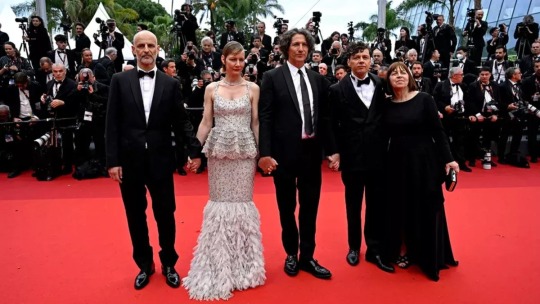
The Zone of Interest Soundtrack 2024 Credit: The Hollywood Reporter
“The Zone of Interest” competed for the Palme d’Or; It won the Grand Prix, at the Cannes Film Festival, the FIPRESCI Award -The International Federation of Film Critics (short for Fédération Internationale de la Presse Cinématographique) and the Soundtrack Award for Mica Levi’s score in 2023.
youtube
Jonathan Glazer's masterpiece film 'The Zone of Interest' won THREE BAFTA AWARDS for Film Not in The English Language, Sound and Outstanding British Film, the film never shows the inside of the camp’s operations.
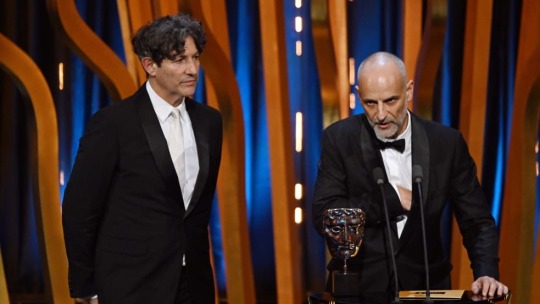
James Wilson, The Zone of Interest producer speaks, with director Jonathan Glazer alongside. Kate Green/BAFTA/Getty Images for BAFTA
Jonathan Glazer's “The Zone of Interest” has become the latest Holocaust movie nominated at the 96th Academy Awards. It has been nominated for five Oscars including - Best Picture, Best International Feature, Best Adapted Screenplay Best Sound and Best Director — for Jonathan Glazer, and is the only film to cross over into both categories this year.
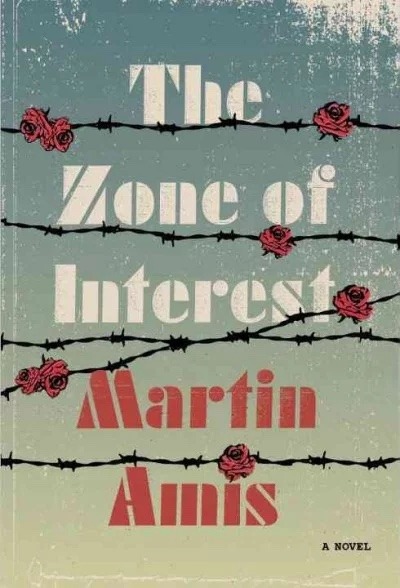
The Zone of Interest By Martin Amis 2014
#eebaftas # thezoneofinterest #a24 #film4 #JonathanGlazer #JamesWilson #MartinAmis #Palmed’Or #GrandPrix #CannesFilmFestival #FIPRESCI #BAFTA2024 #Auschwitz #WWII #Holocaust #ChristianFriedel #SandraHüller #AcademyAwards #ThomasHarding #historian #Gillian Rose #TimothySnyder #book
11 notes
·
View notes
Text
So how the heck do the Avengers pay for stuff, and how rich are they?
So, in the wake of “Falcon and the Winter Soldier” There’s a lot of debate about why Sam didn’t seem to get paid well for his work in the Avengers (at least in the MCU continuity), and this has got me thinking: we’ve got no evidence that the Avengers are, financially, anything but a hot mess. So lets break it down, Avenger by Avenger, using real-world pay scales for the ones who have jobs.
Tony: a billionaire, so clearly he’s a financial genius, right? Well….. his actions say otherwise. He’s shown to be wildly irresponsible with his money. He inherited a lot of wealth form his parents which was managed by the first Jarvis, Obadiah, and Pepper for him, he buys and then gives away not just woks of art, but entire collections by major 20th century artists on a whim, destroyed his own cars and home without concern, he tanks the value of his own company in the first Iron Man with a bad press interview, gets kicked of his own bord of directors, and ultimately, in Iron Man 2, gives control of his company to Pepper. He’s insanely rich, and insanely smart, but man, he’s not smart with his money. So all the cool stuff, his suits, the Avengers tower, the facility up-state: that’s all paid for by him, but Pepper is holding the purse-stings. So, does he pay the others? We have no evidence for most of them… but we do with Spidey. Peter Parker is in the Stark Internship Program a euphemism to hide the fact he’s training and mentoring him as a super-hero, but I find the wording interesting: he refers to Spidey, his surrogate son and chosen heir, as an intern. I.E., Unpaid. I’m guessing this is Howard’s influence over him, some sort of ‘make you own way in the world, son’ attitude, but if he’s not paying Spidey, is he paying anyone else? He certainly pays for stuff super heroes suits and things, equipment, fuel, the base, but does he pay anyone a wage? No one ever mentions it. You think it would come up.
So, if he’s not paying them a wage, where do Avengers (and thier allies) get their day-to-day money from, and are they rich? Using google and https://www.federalpay.org, lets find out.
Cap: Well, before Civil war, he’s a shield operative, and he presumably still holds his military rank: he’s a US Army captain, with (well) over 40 years service, so USD$88,142.40 per year, with $237.71 drill pay (pay per drill you have to do on weekends, on leave or outside of normal service) and $175.00 per month hazard pay (which I bet is interesting) on top of that. As a WW2 veteran, he’d be eligible for a war pension if he:
Was not discharged for dishonorable reasons; and,
Served 90 days of active military duty; and,
Served at least one day during wartime ("wartime" as determined by the VA); and,
Had countable family income below a certain yearly limit; and,
Is age 65 years or older; or
Regardless of age is permanently disabled, not due to wilful misconduct.
As he’s still receiving 90k per year, he’s ineligible for a pension as his countable yearly income is above the limit. So if shield pays him in accordance with his rank and years of service, about $90, 600 per year incuding hazard pay.
After civil war, he’s a fugitive on the run, so presumably flat broke. I’d asume he gets his pension returened to him after the snap.
He’s also just gone from the 40’s to the present day, so 70 years of inflation probably makes buying things very confusing for him: everything would seem insanely expensive at first. He’d also not know what the correct prices are for anything invented after 45. You might get used to how much more expensive food and coffee is, but how much is a smart-phone worth? $200? $2000 $20000? Who knows? I bet the others have to facepalm a lot when he either refuses to pay for what he sees as clear price-gouging, and at the same time regularly pays insane amounts of money for goods and services because he doesn’t know better. He also has no known assets other than his pay: he rents an apartment making him one of the few American males in his age-group who isn’t a home-owner
Thor: Does Asgard even have currency? It’s depicted like a “Crystal spires and toga” type utopia with no poverty: even working class Asgardian’s like Scourge seem to be pretty well-off and want for nothing, so he’s from a post-scarcity society where actual magic is a thing. His “Another” coffee cup smashing and the fact he doesn’t have a computer of phone in Ragnarök might indicate that, no, he just doesn’t have, need or understand money. Splitting a bar tab with him must be a nightmare. His breakdown post snap indicates he’s got some cash, but not a huge amount, and is probably skiving of Valkyrie and the other Asgardians.
Banner: Okay, so a PhD could make you a lot of money from patents… in pharmacology or engineering. Theoretical physics? Not so good. And if Banner did have any patents, they’ve probably been seized under eminent domain by the US military. At the start of The Hulk film, he’s working a entry-level factory job at a botteling plant in Brazil. The minimum wage in Brazil is 1069.62 Real per month, that’s 12,835.44 Real per year, or around $2437.79 US per year, before everything goes wrong for him! He then runs off to India, works for Tony for a bit and then gets shot into space. Spidey may actually make more in allowance than Banner does, and Banner is a gown ass man with bills to pay: I’d imagine he loses a lot in ripped clothing.
Natasha and Barton: Pre Civil-war, both are government spooks, so how well does that pay? The salaries of CIA Intelligence Analysts based in the US range from $25,838 to $685,701 , with a median salary of $125,340, so let’s assume that Shield pays in a similar range: $685,701 per year for Director Fury, around 125,000 for Natasha and Cliff, which explains Cliff’s nice, middle-class mid-western home. Post civil war, presumably not great: we know that Natasha spends a lot of her savings running and hiding all across the world, and Cliff takes a deal and presumably lives of his savings, pension and his wife’s income.
Rhodes: Full USAF colonel with over 10 years service? $105,562.80 per year, plus $293.23 drill pay per drill and $175 per month hazard pay, and because he’s team Stark and not Team Cap in Civil War, he’d not lose any of that. He presumably also gets an injury pay-out after his accident. After T’challa and Stark, he might be the best paid avenger.
Dr Strange: spends all his money he made as a surgeon on trying to cure his hands: spends literally his last dollars heading to Nepal to train. Wong even jokes with him about their lack of worldly money when asking for a tuna-melt. But, can use illusion to make people think he has money, and his home and clothes etc. come with the job, so in the same boat as Thor in that he has no money, but needs none AKA, he’s a bastard to try and split a restaurant bill with.
Wanda and Vision: No know source of income, just sort of live in Tony’s hose and eat his food, and on top of that Wanda goes on the run after civil war… yet they can stay in fancy hotels in Edinburgh, a relatively expensive city, and Vison apparently bought them a house to retire in, so one of them has some source of money. Maybe Tony gave Vision years of back-pay form when he was still Jarvis, or maybe the vison has a day job, which is, frankly, hilarious. Could you imagine him as a barista? I can, and it makes me very happy.
Scott Lang: I’d assumed he’d be super, super broke, but apparently the average pay for a private security consultant in the Bay area is $85,430 per year. Not bad. Pity he gets sucked into the quantum realm just as his business is taking off, so presumably, flat broke again.
Bucky: no known income, and I doubt Hydra paid him for being the Winter Soldier so he probably has no savings, but he should, technically, qualify for a military pension. As a single veteran, he’d be eligible for federal tax-free pension of up to $1732 per month, or $20,784 tax free per year. Not much for someone who lives in NYC. He may also be eligible for medical benefits over the loss of his arm. Whether or not he got to see any of that money given how confused his life has been over the past 10 years is unclear, but on paper he’s eligible.
T’challa: He is, quite possibly, richer than Stark, and as an absolute monarch pays no tax and has access to his Nation’s vast wealth in vibanium. It’s good to be the king!
Captain Marvel: USAF captain, and a test pilot; the test pilot school only accepts applicants with a service length of less than 9 years 6 months (10 years six moths of helicopters) as they don’t want older applicants. With 8 years service, $79,538.40, plus drill pay and hazard. However, no know (human) pay since 1990. Flat broke.
Guardians of the Galaxy: no data, but I’m assuming “Cowboy Bebop” levels of perpetual never-ending poverty given the way they choose to live. I’d also assume Rocket has taken all their cash into some sort of Ponzi scheme of his own creation, because just look at him, of course he has.
Spidey: he’s got about $10 of his aunts’ money at any given time, so he can buy lunch… which may in fact be more than Banner or Lang, and we know it’s more that Strange or Thor.
So, here the big one: how rich or how broke is Sam?
Sam Wilson: annoyingly, we’re not directly told what rank Sam held in any MCU film. USAF pararescue “Maroon berets” are generally NCO’s (but there’ are officer-ranked pararescue) , and he’s seen working on his wings at one point, where as officers don’t generally work on or maintain airframes. He’s shown wearing a Nation Air guard grey while jogging at one point to confuse the matter further. The general consensus on redit is he’s a former USAF tech sergeant (E-6). But how long was he in the air force? With six years service (the minimum sensible time he could have served to work in pararescue based on his age), that would be $41,464.80 per year, plus drill pay and hazard. As Anthony Mackie, the actor that plays him, was 36 as of Civil War, and assuming the character is the same age, and assuming he retired from the air force that year, and he joined the USAF at 17, the youngest you can join, he’d have served 19 years, giving him a pay of $51,566.40, the maximum pay you can get at this rank before promotion to Master Sergent, but meaning he left just before he’d qualify for the 50% final salary pension you’d qualify for after 20 years. Which seems weird.
So let’s assume the character is one year older than the actor that plays him and served 20 years (ages 17-37), that means Sam has a military pension of $25,783.20 per year (20,784 of it tax-free), plus any injury benefits. He councils other veterans, but doesn’t get paid for that. He also chooses Team Cap in Civil War, so would become a wanted criminal, and so lose his income between 2016 and 2018, and then gets snapped and has no income for 5 years, which would destroy his credit rating. Like the rest of Team Cap, he presumably gets his post snap pardon, and goes to work for the US government at his former pay and rank. However, given how Captain John Walker treats him as an equal, it’s possible he’s been promoted to a captain when the hired back, giving him a pay of between $54,176.40 to $88,142.40 (with 20 years experience, depending on if they take into account his prior service or not, and how much prior service he has), but either way, he’s just starting this as a new job after being legally dead for 5 years: no savings, and no credit.
Commercial fishing vessels cost about 10% of their total value per year in maintenance alone. I can’t identify what sort of boat the Wilson’s have, but some quick googling indicates that the cheapest 15m long wooden in-shore shrimp trawler costs around $140,000, so that’s $14,000 per year in maintenance costs alone, minimum. And that’s a lower estimate, assuming the rest of the business is sound, which we know it isn’t.
So, in concussion, yes, Sam is in some serious financial trouble until he can re-build his savings and credit, but the scary bit is he’s not alone in that: he’s probably better off than Lang, Banner, Danvers, Strange, Thor, Bucky, Wanda and Parker. Only Clint (if he gets a full pardon and gets his full pension), Rhodes, Stark and T’challa aren’t in some sort of potential financial problems. That asshole bank teller was right: despite the fact it seems to pay well on paper, with a few exceptions, the Avengers financials are probibaly a mess.
EDIT: Rocket is running the Ponzi scheme, if that’s not clear from context. The others know they have money somewhere, but not where it’s gone. And It’s been pointed out to me that as he’s technically a POW while he’s the Winter Soldier, Bucky is owed over 70 years back-pay, equal to over 3 million dollars, details in the notes.
#MCU#sam wilson#falcon#captin marvel#captin america#tony stark#iron man#war machine#winter solider#bucky barnes#guardians of the galaxy#rocket raccoon#dr strange#hulk#wanda#vison#wandavision#the avengers#fan theory#working out how rich or poor mcu people are#what the heck do Tony Starks tax returns look like?#black panther#black widow#hawkeye#ant man#thor#rich list#peter parker#spiderman#federal pay scales
176 notes
·
View notes
Text
I saw a tweet that was like "Gay people see endless stories about straight people but are still gay, but conservatives are afraid that if their sons read one story about a gay person they'll ask Brad to prom" and I almost shared it but I didn't, because I think it misses an important point (and thereby misrepresents the discourse).
The plain fact is that representation *does* matter -- in other words, there are some people who would see themselves as straight for much longer if they hadn't had early exposure to gay representation. So in some sense, these conservatives aren't wrong about the cause and effect here.
The typical response is "oh but these kids who grow up to be gay were actually always gay" which may or may not be true, but is ultimately irrelevant IMO. Lots of things operate the same way (and are subject to the same restrictions) but almost definitely don't have a biological basis -- latex fetishes, for instance.
This also relates to 'tolerance' discourse: we should 'tolerate' differences that are based in biology because they can't be changed. But this 'tolerance' discourse assumes that differences & diversity are bad by default -- that we should change them if we can, & that we should just accept the ones that can't be changed.
I reject this! We shouldn't need to naturalize things or claim that they're immutable in order to argue that they ought to be allowed to remain to exist. Variations of any kind (including all forms of preference) should be accepted by default and only subjected to discussions about 'tolerance' if we've proven that they're harmful (and specifically, harmful to things that are useful/valuable).
Representation is powerful in part because it opens people up to parts of the preference landscape that they might enjoy. Sometimes this is life-changing (ex., some people learn late in life that homosexual relationships or gender transition is possible, after years of suffering from longings they don't have a framework to understand), and sometimes it's a less intense improvement in quality of life.
The position of "keep gays out of our kids films" serves to protect the privileged position of a certain kind of family-form (the patriarchal atomic family, with a dominant male head-of-family, a submissive wife, and children, which many people have good reason to try to escape & so is highly vulnerable to the awareness of *any* alternative) by sacrificing the future happiness of the people who are the component parts of that family-form.
In other words: it's counterproductive to pretend that gay representation will have little to no effect; actually, it has an enormous positive effect on everybody *except* the men who use notions of compulsory monogamous heterosexuality to justify abusive behavior (and they deserve to lose).
20 notes
·
View notes
Text
Bayverse: Treating These Movies with More Dignity than They Deserve or Contain, Because I’m a Goddamned Professional - Part One
TRANSFORMERS (2007) - UNCOMFORTABLE SEXUAL TENSION BETWEEN TEENAGERS THAT I DIDN’T NEED TO SEE
So.
This is a little different than what I usually do.
Clearly.
God, how did we even get here?
Oh, I remember.
The date was September 17th, 2020, and I was in a stream with nine or ten other people watching the first Bayverse Transformers movie. Why we were watching it doesn’t particularly matter- sometimes you just gotta watch garbage so you can refresh your palate for the good stuff, I suppose. Also, a couple of folks wanted to make goo-goo eyes at Blackout’s rotors.
...It’s not my thing, but I’m glad they’ve got something to make the journey worth taking.
I made some sort of comment about only using my brain for this blog’s content, and someone (you know who you are :)) suggested that I take a proper look at the film. Being who I am, I immediately latched onto this idea, despite it being technically outside of what I write about.
And then I quintuple-downed, because winners don’t quit.
Good to know that my BA in Film Production wasn’t a complete waste of time.
Fun fact, I broke my television trying to watch Transformers for this. I think the universe was trying to stop me, by making me perform surgery on electronics, and also aggravating my carpal tunnel.
This movie came out when I was 13, and it was the first Transformers thing I saw after Cybertron. Yes, the anime one. No, not the one that’s objectively terrible.
Anyway.
How did I feel about Transformers when I saw it the first time? Well… it was okay. I liked the robots. I thought Mikaela was pretty, not that I knew what that meant back then. I watched it a few times, if only because my oldest younger brother kept renting it at Blockbuster. It was fun.
Now I’m older, and wiser, and know feminist theory, so my opinion is less “this exists” and more “blind, murderous rage”.
Our film opens up with some claptrap about the Cube™, a MacGuffin of ultimate power that allows the Transformers to create worlds in their image and populate them. Which means this is how they reproduce.
It always comes back to baby-making, doesn’t it?
The narration goes on about how the Cube™ is very powerful, and some folks wanted it for good, and others for evil. The criteria for being “good” and “evil” isn’t established, and I’m not exactly sure how one would define such a thing, when all the Cube™ does is create life, but, well, we’ve only just begun. Maybe we’ll get some answers later on.
Haha, I doubt it.
So, the Cube™ is the catalyst for our 4 million year war this continuity, and that sucker was lost in the shuffle a while back. This is a problem, because, again, the Cube™ is how the Transformers reproduce. Now everyone’s in a mad scramble to find the thing so their species doesn’t die out.
Three guesses as to where it ended up, and the first two don’t count.
Smashcut to the shit nobody cares about- the humans. We see an Osprey fly over the Qatar desert, carrying a buttload of American soldiers. We get a taste of some good old-fashioned xenophobia, as several soldiers mock a guy for not speaking English and loving his mother’s cooking, going full “funny haha gibberish language” on him. We’re two and a half minutes into the film, and I already want to stab something.
Ed Sheeran breaks into the conversation, I guess because he was feeling left out, revealing that he is the New Yorker stereotype of the film, for some reason. The fellas ask their captain, Lennox, what he’s looking forward to most about getting home from their tour, and he reveals himself to be a family man. While he’s been away, his wife had a baby, who he hasn’t so much as held yet. His men respond by mocking him.
For loving his child.
We’re three minutes into the film, and the toxic masculinity might actually make me have an aneurysm.
The Ospreys land, the lads disembark, and we get a snapshot of what downtime during deployment looks like to Bay. There are a lot of kiddie swimming pools involved. Two men play basketball. We watch multiple men take outdoor showers. A young Qatari boy brings Lennox a camelback water pack with a smile on his face. This lets me know that he’s a prop and not a character in this film. I can’t wait to see how many horrors he’ll be put through to simulate pathos.
We get a shot of a helicopter flying over the desert, one that the US military doesn’t recognize as their own. They send a couple of planes to check it out, and said planes get their shop wrecked. The helicopter is revealed to be the same ‘copter that was shot down several months prior. That’s… not good. Ghost helicopter?
No. Not at all, actually.
Lennox gets on a video chat with his wife and daughter, who is wearing one of the most ridiculous baby outfits I’ve seen in a hot minute. And I used to work in childcare, so I’ve seen a good amount of those. The writing implies that normal bodily functions are unladylike and therefore undesirable… in an infant… and that’s when all hell breaks loose, thankfully saving me from more of Bay trying to make me give a shit about these characters.
The helicopter lands, we get a shot of the mustachioed pilot, who glitches (gasp), and the line “have your crew step out or we will kill you” is uttered.
Not even trying to hide the nationalism, are you?
This film hit theaters in 2007, when the xenophobia from 9/11 was still heavy in the air of the general populace, so things like this were more tolerated, and in fact approved of. Of course, it’s not like America has really improved on that subject, or ever really had a point where we weren’t terrible about it, since we live in a world where the military-entertainment complex exists.
See, the Department of Defense and a good chunk of American entertainment industries have a little deal going, and have for the last few decades, and it goes like this: The DoD will allow the use of their vehicles, personnel, and bases, or the likenesses of such, for free, in exchange for their operations being shown in a positive/morally justified light. This is why you never see the armed forces portrayed in a way that makes them out as anything less than heroes- nobody would be able to afford the sets/likenesses without the DoD’s aid. This is also why you see straight-up advertisements for the military branches on televison, in cinemas, and online, and why both the Army and Navy have flirted with having Twitch channels.
It’s all a ploy to get you to join the military, kids. It’s propaganda.
But enough about that, it’s time for our first transformation sequence!
We get a lot of moving parts with this, since it’s realistic CGI in a live-action movie, and it still holds up. It’s hard to tell what’s actually happening, but it, if nothing else, feels alien, surreal, and horrific to behold. They even included the original sound effect in the cacophony, which is nice.
Our ghost helicopter reveals itself to be a Transformer, not that we get that terminology at any point in this film. This specifically is Blackout, a Decepticon. The soldiers start firing on him the moment he starts transforming, then are surprised when the thing they started shooting with several guns retaliates. This is the point where everything ever in this military base explodes, brilliantly and repeatedly, because it wouldn’t be a Bay film without it. There’s a lot of shouting and bright lights, and I’m positively certain that a great deal of people died during this fight.
It’s just a shame that I don’t care.
Blackout rips the top off of a building like it’s a tin of anchovies, and then snags all the hard drives he can, downloading everything. This is a problem, but it seems like nobody was prepared for a giant alien robot hack-attack, because in order to shut down the power to the servers, you need to be able to unlock the breaker box, and no one seems to have the key. They solve the problem with a fire ax.
Lennox is leading the Qatari boy through the base towards safety. I should mention that it’s night now, and several hours seem to have passed since the Ospreys landed, so I don’t know why this kid is still here. He’s got, like, a house and family to go home to.
We get some more tank-throwing action, Sergeant Epps almost gets flattened under Blackout’s foot, then the movie decides it’s going to try to make things more interesting by having each shot cut flash, for whatever reason.
Someone shoots Blackout with a rocket launcher, I think, and this is the point where he throws his tiny little man off his back to go do his job. Yes, Blackout’s got a baby, and that baby is Scorponok, his symbiotic pal who likes to dig into the ground and be a sneaky little bastard.
Blackout blows up a ton more military equipment and personnel, and then it’s time for another smashcut.
Now we’re in high school, just like all those dreams I’ve had where I’ve forgotten my homework. This is where we meet Sam Witwicky, our main character, and also the stand-in for our target demographic. He’s insufferable, and I don’t like him. Mikaela Banes, our love interest, is also present in this scene, but we don’t get to know about her character for, like, another 20 minutes, because who gives a shit about women, right? They’re just props, right?
Right???
RIGHT??????????
RIGH-
Sam is presenting on his great-great-grandfather, Archibald Witwicky, for his family genealogy report, in front of a class containing maybe three actors who are age appropriate.
I know child labor laws are a good thing, and that hiring adults to play teenagers is just the lay of the land, but I swear some of these students look like they’re old enough to be on their second mortgage and third kid.
Anyway.
Archibald Witwicky was an explorer, one of the first to traverse the Arctic circle, and apparently his crew was made up of folks from 2007, because I swear the clothing for a few of these dudes isn’t period-appropriate. We get a seamen joke, because of course we do, and a sextant joke, because of course we do. Sam is also hawking all this crap he’s brought in for the presentation, because he is a little bastard who has no idea what his peers would want to buy, or really how to relate to them at all. He’s selling these “priceless” artifacts so he can get a car. Mikaela finds this charming, for some fucking reason. Also, her boyfriend is weirdly stroking her shoulder blade with his knuckles the whole time this is happening, and I hate it.
Archibald Witwicky went mad after his expedition, talking about an “ice man” so often that his family ended up locking him in a mental asylum, likely to be forgotten about. Which is sad. But we won’t be getting into the medical mistreatment of the mentally ill in Bayverse, now will we? That’s just Too Deep™.
Sam’s teacher didn’t very much appreciate having his class be turned into an episode of Antiques Roadshow, but still gives Sam an “A” on the project, despite it being a very poor report that lasted all of two minutes. I suspect the teacher has tenure, and therefore no longer gives a shit about academic integrity. This “A” means that Sam’s father will buy him a car.
Which is nice, I suppose, if I gave a damn.
Sam’s father, Ron, picks up his son in a car he probably bought at the crux of his midlife crisis, in a green that reminds me of a school gymnasium floor, then plays a prank on his child by pretending to pull into the Porsche dealership. Sam isn’t getting a Porsche, which is good, because he doesn’t deserve one. As Sam gripes to his father, a yellow Camaro drives by oh so conspicuously. Wonder what’s up with that.
Instead of the Porshe dealership, they head over to the used car lot, which is being run by Bobby Bolivia, who spends his time yelling at his employees and wanting to murder his mother. Sam is incredibly ungrateful about the fact that his dad is helping him get a car, even though it’s his FIRST car, and nobody gets a nice one the first go around. Or, at least, they shouldn’t, given the statistics about accidents with young drivers.
“No sacrifice, no victory” is uttered by Ron, which is the family motto, or so he claims. Archibald Witwicky said the same thing when he had multiple people dying trying to get to the Arctic Circle, so there’s precedence for the phrase, but we’ll see how it holds up throughout the film.
Bobby Bolivia shows Sam and Ron the cars he has for sale, and Sam is immediately drawn to the yellow Camaro in the lot, though there’s a small problem- it’s too expensive for what he and his father agreed to. Also, nobody knows where the hell it came from, so paperwork might be an issue. When Bobby tries to show Sam the yellow Beetle they have right down the line, everything explodes, because this is a Bay film, and fuck the original material this movie was based on. Bobby lets them have the Camaro for a lower price, suddenly fearful of whatever strange powers have just visited his place of business. “The car picks the driver” is suddenly more than a bullshit line to spout off in order to sell cars, and I’m certain that’s shaken the poor man.
Over in Washington, D.C., the Secretary of Defense prepares to address just what the hell happened in Qatar, lamenting on how young the audience he’s going to be speaking to is. In particular, he’s referring to the two dweebs and the hot chick sitting in one of the rows. All the women in this movie who aren’t someone’s mom are made up to be very pretty. And not even in a realistic way.
But we’ll get to that in a bit.
So, the military network was hacked. That’s bad. Nobody knows who did it. That’s also bad. The only lead the US has is a soundbite, which is the signal that hacked the network.
Everyone here at the briefing is going to be helping to figure this mess out. This is great, if you like looking at Rachael Taylor for a few seconds at a time, and can compartmentalize hard enough to make that worth the effort of watching this godforsaken film.
Back at the Witwicky household, we meet Mojo, a chihuahua with a cast that doesn’t seem like it’s actually doing anything. I wish he was the main character instead of Sam.
Sam arrives home from the dealership, and says “alright, Mojo, I’ve got the car. Now I need the girl.”
As if ownership of a person is something to aspire to.
As if women are property to be owned.
As if women aren’t people, but rather commodities.
We’re 17.5 minutes into this film.
We’re introduced to Judy, Sam’s mother. She’s shrill, and annoying. This is by design, because none of the women in this film are actually people, but rather archetypes to bounce off of the male characters.
Sam and his father have a moment of what some might consider banter, then Sam gets huffy with his mom over gender roles for the dog. I, for one, think Mojo looks positively dashing in his bedazzled collar, and to hell with whatever Sam says to the contrary.
Sam drives off to go be a misogynist, with the promise to be back by 11PM.
Over in Qatar, the soldiers and that little boy are running from the attack on their base, as Lennox’s wife watches a public announcement on the matter back at home. The Secretary of Defense lets us know that we’re at DEFCON Delta at this point. Lennox Jr. cries, and all I can think about is how they probably pinched that baby to make that happen. They pinched a baby for Transformers (2007).
The soldiers in Qatar talk about shit they have no idea about, Sergeant Epps going on about somehow having been able to see a forcefield around Blackout through his super special binoculars. I don’t know how, or why, he knows this. I don’t know anything anymore.
Ed Sheeran has his doubts about this whole thing, and Lennox is also present in the scene, because I guess he’s important. Through a bit of dramatic irony, Fig- the guy everyone was making fun of for being bilingual at the start of the film- says that this probably isn’t over, as the shape of Scorponok shifts through the sand just beyond them.
Epps is having a minor crisis over the fact that Blackout saw him, but we don’t have time for that, because we’ve got to get to cover. The lads decide to head to the little Qatari boy’s house. Again, I wonder why he was at the base at all, considering that it seems like they’ve been traveling for a good portion of the day.
Back with Sam, he’s picked up his friend Miles, and together they’re going to a lake party. Are they invited to this party? Yes, but also no. It’s public property though, so it should be fine. As they park, Sam notices that Mikaela is here, which is great for him.
Mikaela’s boyfriend, Trent- whose name I had to look up- is a massive tool, and starts pestering the two boys for daring to exist in his airspace. Miles climbs a tree. I’m glad he’s having fun, at least. Sam makes a joke at the expense of people with brain injuries, and this for some reason? Warrants a shot of Mikaela making the blank “pretty girl” face? In response?
Mikaela saves Sam from becoming a wet stain on the grass, which is very kind of her, and more than Sam really deserves. Trent, his boys, and Mikaela start to head off for another party, to get away from Sam and his tree-loving friend. Mikaela offers to drive, and Trent says that she can’t handle his truck, because she’s a ~girl~. This causes Mikaela to ditch him, and start walking home.
The script knows enough about misogyny to know that this would be a nice “take that”. Michael Bay, however, likely fails to see why everything he did with said script involving this character is a goddamned problem.
Because Mikaela, bless her heart, has a lot of problems.
Let’s start with the outfit: a croptop, a jean skirt that BARELY covers her ass, and a pair of wedge heels that are at least four inches tall. On a character that is, at oldest, freshly 18.
Look, I’m all about self-expression and the freedom to choose how you dress for yourself and yourself alone, but this clearly isn’t that. This is a character, not a person, whose wardrobe was designed for the straight male gaze. She’s wearing fucking STRAP HEELS to the lake. This is about oogling. This is about reducing a whole-ass person to the same status as a piece of meat. In fact, who was on wardrobe for this? I’d like to have a few words with-

A woman? Okay, well, what else has she worked on?


You can’t be fucking serious.
ANYWAY.
Miles just called Mikaela an “evil jock concubine.” I don’t like Miles anymore.
As Mikaela walks down the road, strutting hard enough that I’ve got sympathy pains in my hips, the radio in the Camaro turns on, playing “Drive” by the Cars, and giving Sam a hell of an idea; he’s gonna drive Mikaela home, so she doesn’t have to walk the 10 miles to her house. Why he knows how far she lives from the lake isn’t addressed.
Sam kicks Miles out of the car and goes to give Mikaela a ride, which she accepts after a bit of self-deliberation, and also him making an ass of himself. The shot here is framed with Sam like he’s a normal-ass person, and Mikaela from her breasts to the top of her waist. Because of COURSE it is.
She hops in the car and then goes off about her taste in hot guys. Which is weird, and out of left field. Sam is about as confused as I am, then continues to make a fool of himself. This is his nature as a person. Mikaela has no idea who Sam is, even though they’ve gone to the same school for the last 10 years and have multiple classes together. And the fact that she was staring him down all through his genealogy presentation. And at the lake.
This movie isn’t very well thought out, I feel.
It’s at this point the the Camaro turns the key on itself and starts to sputter out and die, as “Sexual Healing” by Marvin Gaye pops on the radio.
I don’t like how this car is trying to get Sam laid.
I don’t like how this car is trying to get Sam laid with a girl who didn’t even know his name five minutes ago.
I don’t like how this car knows what sex is.
The Camaro breaks down on a cliff, and Mikaela hops out to work on the engine, and also to get the hell away from Sam’s sputtering.
As Mikaela admires the sweet engine in this Camaro, showing off her knowledge of cars, we get several shots of her from her breasts to her thighs, while Sam is treated like an actual person. Don’t bother trying to play it off as an artistic choice, Bay, this is blatant horndogging. This adds to NOTHING, other than my ire.
Sam says more stupid shit, and Mikaela, who must be the nicest fucking person in the world, just tells him to fire up the engine so she can try to sort out the problem. Then he asks why she goes for jackasses like Trent, and she decides that she’s hit her limit for today, opting to walk the rest of the way home. Good on you, Mikaela. Don’t take Sam’s bullshit.
Sam, realizing that he’s put his foot in his mouth for the 80th time today, pleads with his Camaro to do him a solid and work, and this actually works out for him. Great. Sam, victorious, once again offers Mikaela a ride, which she, once again, takes.
He drops her off without further incident, and she thanks him for listening. Even though they didn’t really talk that much. I dunno, maybe they had a super deep conversation offscreen. Mikaela asks Sam if he thinks she’s shallow, because clearly all women need approval from the men around them, and Sam says that there’s more to her than meets the eye.
Which made me groan aloud.
Anyway, she gets inside without a problem, and Sam professes his love for his new Camaro for allowing him to talk to a girl. Or at least talk at her.
Back in Washington, D.C., at the Pentagon National Military Command Center, we’re making weirdly racist calls on who hacked the military.
Up with Air Force One, a conspicuous boombox transforms into a robot, and then runs off to hack shit. The President of the United States requests some snack cakes. A flight attendant goes down to storage to retrieve said snack cakes, and finds that boombox in the elevator with her. Considering this is Air Force One, you’d perhaps expect her to immediately be suspicious of such a thing, but this is Bayverse, and we don’t think here.
The flight attendant brings the boombox down with her and places it on the counter as she goes to get the presidential snack cakes. The boombox immediately disappears. Now, you’d perhaps expect her to immediately be suspicious of such a thing, but this is Bayverse-
The flight attendant opens up the snack cake package, for some reason, and drops the cake on the floor. She then proceeds to eat it, and then act shocked when it tastes like floor. There’s a robot in her fucking line of sight, and you’d perhaps expect her to immediately be suspicious of such a thing-
She leaves to go feed the President floor cakes, and our little robot friend gets to work stealing government secrets. He, if nothing else, looks pretty cool doing it. He’s a very pointy lad.
Back at the Pentagon, Maddie- Rachael Taylor’s character- can hear the hacking. This sends everyone into a panic, because, well, that shouldn’t be happening. The hacking noise is a direct match to the one from Qatar, so that’s obviously a problem.
Back on Air Force One, our little robot friend is looking for “Project Iceman”, which he very quickly finds, and downloads everything they’ve got on it, and also plants a virus. The process seems to be… doing things to him. It’s weird. This movie is weird.
The Pentagon cuts all the system hardlines, stopping the process, but it’s too late- he got what he wanted, just about. Two security personnel come into the room, and the robot kills them both with some spinning blade disc nonsense. Air Force One is forced to land for the safety of everyone on-board. More security detail comes in to deal with the little bastard, but he transforms into a boombox and sits on a shelf to avoid suspicion. Now, you’d perhaps expect-
With the plane grounded, our robot is able to walk his little ass over to a cop car. And when I say walk, I do mean walk; this fucker is in multiple folks’ line of sight and nobody notices a thing. When he enters the car, he’s greeted by the mustachioed driver- the same driver who was operating the helicopter at the beginning of the film. This mustache man is a holographic avatar, one that’s being used by all the Decepticons.
We get our first real taste of Cybertronian language, as our robot- it’s Frenzy, his name is Frenzy- lets everyone know that he’s found a clue to the location of the AllSpark, and, through the power of the internet, knows where to find the guy who’s gonna give them what they need.
Three guesses to who it is, and the first two don’t count.
Back at the Witwicky household, Sam’s car does a runner in the middle of the night. Sam, horrified that his property is being stolen, pursues on a bike, screaming at his dad to call the cops. Sam also calls the cops, as he tears through the neighborhood.
The Camaro breaks into an abandoned building, Sam follows, and we finally get a shot of our audience appeal character. Sam watches in disbelief as a giant yellow space robot shines a beacon into the sky, then makes a video on his flip phone recording the experience. He apologizes to his parents for owning pornographic magazines, and goes to face his probable demise.
However, death does not come from above, instead manifesting itself as two of the strongest junkyard dogs in the known universe, who break their brick-inlaid chains to get at this little dip of a man. Sam is chased through the yard, climbing on top of a couple precarious oil drums, even though there’s a ladder, like, right there. The Camaro rolls in, scaring off the dogs, and Sam bolts, throwing the keys to his ride at his ride. When he gets outside, the cops have arrived, and immediately arrest him.
Back with the US government, the Secretary of State is having a conversation about all the bullshit that just went down with Air Force One. He and his fellow cishet old white men discuss their options, until Maddie comes in to set them straight on some of the facts. They act all indignant about it, because women can’t be smart, right?
Right???
RIGHT??????????
RIGH-
Anyway, we get a weird little deflection of Maddie’s role in everything, because a woman is nothing without the men around her, then she brings up the point that the bullshit that happened on Air Force One went down in just a few seconds, which isn’t something that anyone can actually do. She brings up quantum mechanics, which everyone blows off as nonsense- not that I wouldn’t as well- and theorizes on a DNA-based computer, which is technically a thing, if not trapped in the realm of speculation. It’s at this point that the Secretary of Defense tells her to come back when she can back these wild claims up, and isn’t just clearly spitballing.
And then he snaps his fingers at her, and any point he might have had leaves my brain so I have more room for being enraged.
Back with Sam, we’re at the police station talking to the cops. His dad is here, and Sam is trying to explain that his car is a dude. Even though he took at a video (one that was likely crap, given how quickly he spun his phone around to show off what he was seeing) the cops, understandably, don’t believe him. Then one of them, not so understandably, starts… threatening Sam? With his sidearm? And daring him to try something? This isn’t any sort of statement on the corruption of American law enforcement, it’s just bizarre.
Back in Qatar, our soldier buddies have found a telephone line, and are going to try to use it to get in contact with the rest of the world. It’s just too bad that Scorponok’s decided to make an entrance, and knock said telephone line the hell down. Ed Sheeran has next to no reaction to this, despite it happening maybe ten feet behind him. Fig speaks Spanish, and Ed Sheeran makes a point to be an asshole about it.
Scorponok is about to stab Lennox with his very pointy tail, when Epps notices- finally, someone with peripheral vision- and starts shooting. Then everyone starts shooting, kicking up enough sand to blind themselves, as Scorponok scuttles away, buries himself, then reappears behind Ed Sheeran.
Ed Sheeran does not survive this experience.
The others bolt, not wanting the same to happen to them, and for the fourth time I wonder just why the hell this young boy was at the base in the first place.
Off in the distance, the community of a nearby town wonders just what the shit is going on out in the desert. Our soldiers run into the town, and everyone gets their guns and start firing on Scorponok, who retaliates, because why the hell wouldn’t he?
Lennox demands that the young boy take him to his father, and proceeds to borrow his phone. As shit goes down outside, we have a sort-of gag where Lennox is trying to contact the Pentagon, while a telemarketer tries to get him to buy a phone package. In order for this call to go through, he’s going to need a credit card. This is where the well-known “pocket” scene comes from, as Lennox searches Epps’ pants for his wallet as he fires on Scorponok. It’s probably the best-written thing in this whole film.
With the credit card acquired, Lennox finally gets through to the Pentagon, and tosses Epps the phone so he can talk. Maybe he’s got anxiety about speaking on the phone, I dunno.
Scorponok shows off his disregard for historical architecture, blowing up several buildings, and the US government just watches this all go down. One of the actors in this scene looks like my dad, and it trips me up every time he’s on screen. Anyway, now the Pentagon knows about the giant space robots running around in Qatar. They send over some air support about it. All this manages to do is piss Scorponok off.
So they try it again.
This time it works, sort of.
At the very least, he’s left now.
Tail fell off, though.
Also, Fig’s been grievously wounded. The others, for once, don’t make fun of his native language while they help him hold his blood inside his body.
Back at the Pentagon, Maddie’s looking to prove that the bullshit that’s been going on is of the sci-fi variety, and in order to do that, she’s going to need a little outside help. She takes the information from the Pentagon, slaps it into an SD card, hides that shit in her blush compact, and then runs out the door to Glenn Whitmann’s house. Or, rather, his grandma’s house.
Glenn is a hacker, and shouldn’t be seeing anything that Maddie’s brought him, but everyone knows that confidentiality is for nerds, so whatever.
Back at the Pentagon, Maddie’s immediately been caught. It’s almost like slapping the military network onto an SD card maybe wasn’t such a hot idea.
But what do I know?
Glenn takes a look at the soundbite and figures out that there’s a code embedded in the thing in about two seconds. Good to know our tax dollars are being well-spent on the US military, that some dude in his jammies can figure this shit out faster than a whole team of analysts. They figure out that “Project Iceman” is involved with this somehow, and also the existence of Sector Seven.
It’s at this point that the FBI busts in. Good. I kind of want Maddie to go to jail for this, because she was about as stupid as she could be handling the situation.
Glenn’s cousin goes through a closed glass door- don’t worry, it’s tempered- and there’s a weird cut before that exact same shot continues, and he’s tackled into the pool. There was no reason for that to have happened, but here we are.
Back with Sam, we’re treated to him in his boxers, shooting basketballs in his room. He goes into the kitchen, where Mojo is standing on a stool. It’s a very tall stool, the sort you sit on, and he’s just… there. I don’t know how he got there. There’s no one else in the room besides Sam, and I know he didn’t put him there.
Clearly this must mean Mojo is God, and being on that stool is his divine will. I will be approaching the rest of the franchise with this in mind, because it’s clearly the only answer.
Our merciful Lord Mojo jumps up on the kitchen counter and begins growling at something through the window. Sam looks out… the opposite window… to find that his Camaro has returned to him, and is less than thrilled about it, to put it lightly. He drops a jug of milk- luckily it was mostly empty, given the sound it makes when it hits the floor- and gives his buddy Miles a call. You remember Miles, don’t you? If you don’t, it’s fine, because he reestablishes his quirkiness with a single shot, as he sits in a swimsuit and bathes his huge-ass dog in a kiddie pool, and answers the phone with a headset he just happened to be wearing. He must get a lot of calls during Dog Washing Hours.
After giving us one of the most intense voice cracks I’ve ever heard, Sam books it out of his house, hopping on a bike to escape his murderous Camaro. He’s not seen the thing commit any murders, mind you, but he seems pretty convinced that it would do the job, given half a chance. Also, this isn’t the bike he rode the night before; that one is likely being chewed on by those strong-ass junkyard dogs. No, for some reason, the Witwickys have a pastel pink girl’s bike, with the fun little handle tassels and the basket and everything. As far as I can tell, Sam is an only child, and if you think Bay’s going to allow for a teenage boy to have the vulnerability to own a pink bike, you’ve not been paying attention for the last 48.5 minutes.
The Camaro gives chase, rolling after Sam on his bike at a brisk 7 MPH down the friggin’ sidewalk, one of the only scenes in this travesty of a film to actually get me to crack a smile. Sam races through town until city planning puts a stop to him, through the magic of using chunks of cement to decorate the mulch around their trees. He crashes his bike, faceplants into the concrete in front of Mikaela, and promptly dies, thus ending the film.
No, he doesn’t die. I just told a fib. I’m sorry.
Instead, he does a flip and lands on his back, likely receiving a concussion, in front of Mikaela and her friends. Her friends laugh, because everyone hates Sam, as they should, and Mikaela says that what he just did was “really awesome.” Don’t try to be nice, Mikaela, this is Sam we’re talking about; you could stick the dude in the freezer overnight and he still wouldn’t be even remotely cool.
Sam gets back to the whole “running away from a car” deal, and Mikaela decides that this is the sort of thing she’d like to do with her day, so she ditches her friends in the middle of their scheduled Burger King™ time to go see what the hell Sam’s on about.
As Sam is chased by the Camaro who is being chased by Mikaela on her motorized scooter, a cop becomes involved, tearing through the streets to join this ridiculous game of tag. Now, we’ve seen two different flavor of cop so far- the mustachioed avatar cop car that picked up Frenzy from the airport, and the dude who threatened a teenage boy with a gun after accusing him of being under the influence of drugs. Either way, I don’t think this is going to turn out well for Sam.
Sam’s cornered himself under one of those really wide bridges where people can park their cars, which wasn’t terribly smart, but it’s Sam, so this is about par for the course. The Camaro manages to miss him, but the cop car does not. Sam is actually pretty cool with the cops being here, as if they could do anything about “Satan’s Camaro.” I guess he didn’t see the decal on the side of this car that says “to punish and enslave…”
Sam attempts to approach the car for help, and gets clotheslined by a car door for his troubles. He hits his head on the pavement, certainly exasperating the brain injury he received not ten minutes ago. Still, he continues to try to talk to the holographic avatar through the windshield, revealing that the bike he’s been riding is his mother’s. Mystery solved, I suppose.
The cop car doesn’t much appreciate being slapped on the hood, and begins to rev violently at Sam, threatening to run him over several times. Then it explodes into being a robot. Sam, who’s seen a lot of really weird shit in the last 24 hours, nopes out of the situation. It’s at this point that I realize he’s wearing a shirt for the band the Strokes. I don’t know why that stuck out to me, but it did. Guess my brain needed something to latch onto during all this.
Sam is running as fast as his little legs allow, as our newest robot friend takes up a leisurely jog to keep pace. Then he kicks Sam. He kicks Sam’s body like the football. This, of course, instantly turns Sam into a bag of jelly and kills him, thus ending the film.
No, he doesn’t die. I just told another fib. I’m sorry.
Sam somehow survives being punted by a giant metal leg and lands in the windshield of a car that doesn’t turn into a robot. Then he gets yelled at by the cop car. This is Barricade, a member of the Decepticons, and Sam’s got something he wants. Or, should I say “LadiesMan217” has something he wants.
LadiesMan217 is Sam’s Ebay username. This is both stupid because no teenage boy existing beyond the year 1985 would have ever called himself that, and also because it’s just stupid.
Barricade wants the glasses Sam presented for his genealogy report, and he wants them NOW. Seeing as the thing he wants is for sale, and nobody had been bidding on it, one would wonder why Barricade and his associates didn’t just try to purchase them like upstanding citizens. Perhaps Decepticons don’t understand the concept of money, or perhaps they don’t have a stable address to have the glasses shipped to. Or perhaps nobody considered that angle when the script was being put together. Who can say?
Sam gets back to running away from Barricade, we see where Mikaela got to, and the two of them collide. Sam rips Mikaela off of her scooter, and they both fall to the ground. Mikaela, who did not buckle the clasp on her helmet, asks Sam what his fucking problem is. Then his problem shows up, and they take a very long time to get up so they can run. So long, in fact, that the Camaro has to swing in to save them. After much pleading from Sam, Mikaela gets inside Satan’s Camaro, and the two of them are whisked away to safety. Barricade pursues, and then the butt rock starts.
There’s a lot of screaming and yelling, the Camaro busts through a window and several shelves in an abandoned building, there’s some drifting, and then suddenly it’s nighttime. Barricade somehow got in front of the Camaro, and is circling like a shark. The Camaro locks the two teenagers inside itself, though I suppose they could climb out through the still-open windows if they really wanted to. The Camaro cuts the engine off, then cuts it back on and bolts for the exit, and this somehow tricks Barricade long enough for them to get past.
The Camaro dumps Mikaela and Sam out one of the doors and then transforms into that yellow space robot we saw a bit ago. It’s Bumblebee! Nearly an hour in, and we finally get a proper look at the little bastard. I guess that’s what happens when you spend the first 20-something minutes on being xenophobic and appealing to the focus groups that think it’s fine sexualize high schoolers.
Bumblebee- no, he’s not introduced himself yet, but I just can’t keep calling him “the Camaro” anymore- comes out of his transformation ready to square the fuck up. Barricade throws himself at Bumblebee, they roll around on the ground for a bit, then things start sparking and exploding, because this is a Michael Bay film. Frenzy jumps out and starts chasing down Mikaela and Sam, while Bumblebee and Barricade murder death punch each other. Frenzy manages to grab Sam by the ankles, drag him to the ground, and rip his pants off. Not sure how that happened, considering he’s still got his shoes on.
While Sam’s busy being chased by a sentient pile of safety pins, Mikaela’s taken it upon herself to be proactive about her survival, and is raiding a nearby building for power tools. She sprints out holding an electric jig saw and saves Sam by decapitating Frenzy. If you know anything about Transformers, then you know this doesn’t actually kill Frenzy, but good on her for being a badass. Why couldn’t Mikaela be our main character again? Oh, right, because she’s a ~girl~.
Sam punts Frenzy’s head, like, 50 yards, which seems like something he shouldn’t be able to do, given that he’s a massive weenie, but there you are. With that out of the way, Sam takes Mikaela’s hand and they run off to go watch the giant robot fight. The bottom of Frenzy’s head turns into a spider and he crawls his way over to Mikaela’s purse. He’s gonna steal her gum, the fiend!
Mikaela and Sam have, unfortunately, missed the giant robot fight, which means that we, as the audience, have also missed the giant robot fight. Which is unbelievably stupid, seeing as everyone who has ever watched this movie came for the GIANT GODDAMN ROBOTS.
Mikaela asks just who the hell the yellow robot is, I guess because she’s finally had a second to process what the hell’s going on. Sam claims that he’s a super-advanced robot, “probably from Japan.” Whether or not this is a reference to the Japanese origins of the original toy line isn’t clear, though somehow I think it’s more xenophobia. Sam also makes the claim that if Bumblebee had intended to hurt them, he would have done it by now. This is quite the jump from a few hours ago, when he was calling the poor guy “Satan’s Camaro.”
Sam finally, finally asks Bumblebee what his deal is, and we get our first taste of the Bayverse Bumblebee Gimmick. The Gimmick here is that, due to an injury to his vocal processing, Bumblebee cannot communicate through traditional means, i.e. speech. Because of this, he instead strings together sentences by flicking through the radio frequencies and choosing key words. This can lead to some interesting audio design, like describing his fellow Autobots to “rain down like visitors form heaven, Hallelujah!” because a radio sermon fit what he was trying to say best.
This gimmick is one that has been used in other pieces of Transformers media, at least in part. Bumblebee is unable to speak traditionally in Transformers: Prime, and instead communicates in beeps and clicks that his teammates can understand, but not so much the humans, save for Raf. In Bumblebee (2018), the idea was used whole-cloth, with the injury resulting in his inability to speak happening on-camera within the first 10 minutes of the movie, and the idea of “expressing oneself through music” being introduced by his human companion Charlie Watson.
All in all, I rather like the idea going on here; it’s an interesting part of his character that opens up for a lot of interesting and creative moments.
It’s just too bad it was introduced in fucking Bayverse.
But yeah, anyway, the other Autobots are coming to Earth. Shit’s gonna be lit.
Bumblebee turns back into a Camaro, and Sam uses the power of FOMO to get Mikaela to go in the car with him. We get a shot of Barricade fucking dying on the side of the road. Frenzy murders Mikaela’s phone, and then steals its identity, including the little bejeweled heart stickers. Good thing Mikaela remembered to go get her purse, otherwise he probably would have felt very silly doing that.
Mikaela refuses to sit in the driver’s seat, seeing as she now knows Sam’s car is sentient, and sort of feels weird about this whole thing. Sam suggests that she sit in his lap instead, as the camera angles to give us a peek at the cup of Mikaela’s bra. When asked why the hell she should do such a thing, Sam says it’s a concern about her safety, given that the middle console of the car does not have a seatbelt. Sam either fails to recognize that seatbelts going over two layered bodies won’t save either of them in the event of a crash, or he’s just trying to make an excuse to have a pretty girl in his lap.
Given what movie this is, I’m going to guess it’s the latter.
Mikaela has a similar line of thought, but scoots over anyway, saying that the seatbelt line was a “smooth move”. It wasn’t, but if I picked apart every single bad line Sam had in this film, I’d be here all day.
Mikaela questions Bumblebee’s taste in alt-mode, which offends him to the point of dumping both her and Sam out in the street and driving away. He returns, moments later, as a sleek new Camaro, that I’m sure some car aficionados would call “sexy.”
Bumblebee’s alt-mode is a 2009 Chevrolet Camaro, of which there were none during the time of filming. It was put together for this movie in roughly five weeks. Sam is blown away by the fact that he now owns a car that does not currently exist in his universe. Mikaela is impressed, or at least she would be, if women were allowed to show that emotion in a non-horny way in a Bay film.
Judy doesn’t count.
As Bumblebee breaks into yet another restricted area, we get a shot of the Earth from orbit, as several objects rocket towards the planet. Sam and Mikaela watch the Autobots burn up in the atmosphere, and Mikaela tries to hold Sam’s hand as they do, and it’s at this point that I have to address how much I hate these two’s dynamic.
I don’t give a single solitary shit about this romance, because A) it’s poorly written, B) Mikaela could do infinitely better than Sam, C) I dislike Sam so very much, D) Mikaela, who is a way more interesting character, got placed on friggin’ love interest duty because ~girl~, and E) it’s useless padding to try and make me care about what’s happening here, and I just DON’T. I do NOT care about whether these two get together or not.
We see the Autobots crash-land, three out of four of them causing massive amounts of property damage and possibly killing at least one person. Their stasis pods crack open, and they each climb out, completely naked and in desperate need of clothing to hide their shame. With a quick scan of nearby vehicles, they’re once again decent to be seen in public.
Bumblebee drives the kids out to what I can only assume is the warehouse district he sent that beacon out in, as our collection of good guys finally come together at long last. A massive Peterbilt semi-truck stops directly in front of Mikaela and Sam.
We’re over an hour into this film, and we’re just now getting to the quintessential Transformer, Optimus Prime himself.
In the original cartoon, Optimus’s alt-mode was what’s known as a cabover truck, one where the cab- where the driver sits- is seated directly over the engine. These were popular during the days when maximum truck-lengths were much shorter than they are currently. This is why when you look at height charts for Optimus over various continuities, his G1 cartoon counterpart much shorter than his other iterations.
Modern trucks are longer, and don’t need the cab to sit on top of the engine to save on space. The designers chose to use a Peterbilt to make sure that Optimus would have an imposing stature when compared to his fellow Autobots.
Because heaven forbid we not have heightism come into play in this film.
Our Autobots transform, and say what you will about these bastards being visually incomprehensible, the transformations themselves are cool as hell. My personal favorite is Jazz’s, where he does a cool windmill into his root mode.
Optimus crouches like he’s looking at a cool bug on the sidewalk and addresses Sam by name. He doesn’t even acknowledge Mikaela, which I find to be a bit rude, but whatever. He then introduces himself as the leader of the Autobots.
Peter Cullen is back as the voice for Optimus Prime, sounding wonderful as always. He almost wasn’t brought on for this project, because Michael Bay didn’t want him. If the fans hadn’t thrown a hissyfit, who knows who we would have gotten to be our space dad for the next hour and a half?
This is actually an issue that’s recurred several times in the last few years, and not just with Cullen; Frank Welker, the voice of Megatron, as well as many other Transformers, has been refused roles within Transformers properties. In general, this is because both Cullen and Welker are union actors, and Hasbro would prefer to hire sound-alikes than pay more money for the originals. This isn’t to shame the non-union actors, goodness no, just to merely point out less-than-fantastic business practices.
I realize there have been a lot of tangents, but you have to understand that I am suffering as I do this.
Optimus then introduces his team- there’s Jazz, whose first line is “What’s crackin’ little bitches?”, Ironhide, who incorrectly quotes Dirty Harry, and Ratchet, who calls out just how obnoxiously horny Sam’s character is. We also finally get Bumblebee’s name.
Mikaela asks the very good question of why the fuck the Autobots are here on Earth. Optimus explains that the AllSpark is here, and they’ve got to get to it before Megatron does. He then goes on to explain who Megatron is, stating that he “betrayed” the Cybertronian empire.
No, how exactly he did that isn’t addressed. We’ll just have to take Optimus’s word, I suppose.
If you’ve sussed out by this point the the AllSpark and the Cube™ are the same thing, congrats! You win. Megatron followed the AllSpark to Earth, where he promptly was neutralized by the cold of the Arctic circle. This was 110 years prior to the events of this film, and where Archibald Witwicky came in to the story.
When the expedition was happening, Archibald fell through the ice during a collapse, and ended up finding Megatron’s frozen body in an ice cave. He went poking around on this strange metal giant, and ended up activating Megatron’s navigation systems, which imprinted the coordinates of the AllSpark onto Archibald’s glasses.
Don’t ask how that works, it just does.
So, the Autobots need the glasses, so they can find the AllSpark before the Decepticons do, so those guys don’t use it to build an army out of Earth’s machines, which will destroy humanity.
Sounds simple enough, let’s go get that vision correction device!
Back with the military dudes, everyone’s taking a gander at the tail that Scorponok left behind. They theorize that the metal that makes up these giant murder-robots reacts to extreme heat, but elaboration on that point will have to wait, because the tail has begun to flail. They quickly strap it down, then call the military to let them know to strap anti-tank guns onto anything that’s going to be approaching any giant robots.
Meanwhile, in an interrogation room, Maddie and Glen have been left to sweat a bit. Glen takes to stress-eating, while framing it as a psychological tactic to subconsciously prove his innocence to the FBI.
This is a fat joke, with the added nasty layer of Glen being a black man about to be interrogated by one of the most intimidating white cops I’ve seen in a hot minute.
Glen immediately folds, pinning all the blame on Maddie, and claiming that he’s been a perfect angel his whole life. We get some weird purity culture out of him, before Maddie lets the FBI know that she needs to talk to the Secretary of Defense, NOW.
Over at the Witwicky household, Sam’s parents are watching the news, trying to find out what all those loud crashes were about. Optimus Prime drives down their residential street, the rest of the gang in tow, then they all park to wait for Sam to go get the glasses.
For about 20 seconds.
Sam has to physically hold the door shut to prevent his father from coming out and seeing several very tall robots from outer space tip-toeing around his freshly-landscaped yard, I guess because they got antsy. Optimus plods around on the grass and breaks a fountain, and our benevolent god Mojo comes out of the house, assuredly to smite the leader of the Autobots.
Mikaela runs onto the scene, and Sam chastises her for not controlling the robots who didn’t even acknowledge her existence, outside of pointing out Sam was sexually attracted to her.
Mojo pees on Ironhide’s foot, which prompts Ironhide to threaten to shoot the creature. This is why Ironhide isn’t getting into heaven. Sam, one of Mojo’s chosen few, claims that the mortal shell of his god is seen as a beloved pet by many humans. Sam runs into the house, before Mojo can incur his divine wrath on the Autobots.
While Sam goes to get the glasses, the Autobots decide to do a little peeping on the house, watching his parents watch TV. Sam tears his room apart trying to find the glasses, and Optimus thinks that it would be helpful if he brought Mikaela up to help look. It’s at this point that I realize that Sam has an utterly bizarre fish tank.

I mean, legitimately, what the fuck is this? No filter, no plants, might not even have any rocks on the bottom. Is this a comically oversized bong Sam threw a couple fish into? What the fuck.
Mikaela starts looking for the glasses, running into what is likely a box of porn mags, then they both look out the window to find that the Autobots have decided to hide in plain sight by transforming... in the middle of Sam’s backyard. Amazing work, gentlemen.
Sam finally convinces the Autobots to go sit in the alley and wait, only for Ratchet to run into a power line and trip into a greenhouse. The resulting impact is interpreted as an earthquake. Judy does not have the reaction one might expect from someone who’s lived in California for at least ten years.
Ratchet’s fine, by the way.
The power cuts out, and Ron goes up to check on his son, because he’s at least a halfway-decent father. Ratchet’s shining a light to aid in the search for the glasses. Sam’s parents notice this bright light, and bang on Sam’s door to see what’s up.
Sam quickly hides Mikaela and then attempts to salvage the situation, answering the door and trying to control the narrative. Unfortunately, Ron is far too inquisitive for Sam to do this, and then Judy asks if Sam was masturbating.
Judy, is privacy just not a thing to you? Because if not, it really ought to be.
She keeps going with it too, trying to come up with code words, until another one of the Autobots trips and causes Ron to panic again, climbing into Sam’s ancient claw-foot bathtub to protect himself. He looks out the window to check on his beloved yard, lamenting that the earthquake tore it up.
Ironhide is strongly considering killing Sam’s parents. Optimus tells him that they don’t harm humans, and also begins to wonder if he made a mistake bringing this guy along.
Back in Sam’s room, it’s becoming increasingly obvious that Sam is an absolutely terrible liar, and Mikaela reveals herself, if only to prevent Judy from trying to talk about self-pleasure again. Of course, now she gets to be subjected to both of Sam’s parents objectifying her, so this might be a lose-lose situation.
Sam is reminded that his backpack is in the kitchen, just in time for the government to show up at his house. Mikaela makes a comment about Judy being nice. I suppose on a surface level, yes, being told that you’re gorgeous by someone’s mom is nice. I do have to question the context that compliment took place in, however.
Sam’s about to hand the glasses over to the Autobots, when someone rings the doorbell. It’s Sector Seven, and they’re here to talk to Sam about his stolen car being part of an issue involving national security. Ron and Judy are more concerned about their yard being torn up, Judy yelling that they “need to get their hands off [her] bush.”
We still have another hour of this movie.
The agent leading this mission asks Sam to come with him for questioning, which his parents are very much against. Mojo also voices his displeasure, but it would seem that Agent Simmons is not a follower of the Tenets of Mojo. Sam gets geigered, and his readings are high enough for Sector Seven to take him and everyone in this house into custody.
As Sam and Mikaela are riding in the back of the car, Simmons brings up Sam’s Ebay account, and also the phone video he took of Bumblebee earlier in the week. Mikaela is rather unimpressed with Sam at the moment, probably because he’s gotten her arrested. She still tries to help him out though, because she really is just the nicest fucking person on the planet.
Alas, the combined efforts of these two teenagers isn’t enough to fool the long arm of the law, especially when it’s a branch of said law that deals with extraterrestrial activity. Simmons threatens to lock up these literal children for life if they don’t start talking. Mikaela isn’t taking the bait, so he goes after her father’s parole hearing instead.
Yep! As it turns out, Mikaela and her father stole cars to get by, and she’s got the record to back that claim up. Simmons calls her a criminal, then says that criminals are hot. Mikaela looks like she’s about to cry, and I don’t blame her in the slightest.
Optimus, I suppose because his dad senses were tingling, takes the opportunity to place his leg in the road for the car to run into, then grabs said car like an unruly cat and lifts it until the roof rips off due to stress. The agents in the other cars pile out and point their guns at the giant space robot. The rest of the Autobots quickly relieve them of their weapons.
Optimus notes that Simmons doesn’t seem surprised that a bunch of giant robots just took all his guys’ guns, and demands that he exit the vehicle, posthaste. Simmons obliges, after a bit more prodding. Mikaela undoes Sam’s handcuffs, and he gets fucking pissy about it, as if this girl he’s had a grand total of three (awkward) conversations with should have told him something as personal as “hey, so my dad’s in jail and I’ve been to juvenile detention.”
Luckily, she doesn’t let him get away with it, calling him out as the spoiled, self-centered, privileged little shithead that he is.
Of course, we don’t get any sort of real acknowledgement from Sam, having to move on with the plot. Perhaps, if we hadn’t spent the last hour and 20 minutes faffing about on drivel, we could have had Sam get an actual moment of self-reflection, and potentially even character growth. However, this is Bayverse, and everyone knows that personal accountability is for fucking sissies.
Mikaela and Sam ask several questions, but get no answers from Agent Simmons. And then Bumblebee pees on him.
I hate that I had to write that. I hate it very much.
Anyway, I don’t know why that had to happen, but it did, and I’m nothing if not thorough.
Optimus tells Bumblebee to cut it out, and with that the Sector Seven agents are cuffs and left on the side of the road. Mikaela orders Simmons to strip, as punishment for threatening her father, then cuffs him to a street lamp.
...Yes, that does sound like a bizarre sexual fantasy, doesn’t it?
Unfortunately for our teen heroes, they forgot to confiscate everyone’s phones, and Sector Seven knows what’s up, thanks to the power of speakerphone. More cars and a couple of helicopters show up basically immediately, and the Autobots decide it’s time to dip.
But not before Ironhide fires off a pulsewave into the ground that causes a five-car pileup.
Optimus, I suppose because he knows he chose a ridiculously flashy alt-mode that is in no way practical, just picks the kids up in and places them on his shoulder like a couple of parakeets, then takes up a leisurely jog to get away from the eyes in the sky. He runs through the city, racking up what is likely millions in property damage, as the helicopters pursue. He passes by a “Legalize LA” billboard, which feels odd to see, given what movie this is.
The ‘copters somehow manage to lose Optimus, despite him being relatively slow, and having a notable radiation level that they’ve been using to track him. He hides inside the scaffolding of a bridge, only for Mikaela and Sam to slip off of his polished body to their deaths, thus ending the film.
No, they don’t die. I just told another fib. I’m sorry.
Bumblebee snatches them up just before they hit the ground, the impact of his metal body catching them at 75 mph, killing them instantly and ending the film.
Nope, that doesn’t happen either.
Mikaela and Sam are fine, some-fucking-how, but Sam’s dropped the MacGuffin glasses. The helicopters swing back around, having noticed the sound of a car crashing into the ground and the screams of two whole adolescents. They break out a fucking harpoon gun and fire on our kid appeal character.
Repeatedly.
They wrap up Bumblebee in a series of cables, as he screams like a moose. Mikaela and Sam are held at gunpoint by what is honestly far too many dudes, and are then arrested for the second time in ten minutes. Bumblebee is smoked... because he’s a bee? Sam, not liking this one bit, finds the strength in his weenie body to push a cop off of himself, run at one of the dudes with the smoke guns, throw him to the ground, and then start smoking him. He’s immediately tackled, but points for trying.
Sam and Mikaela are placed back into custody, and the rest of the Autobots regroup with Optimus to see what the plan is. Optimus says that they can’t save Bumblebee without hurting humans, so I guess Bumblebee is just a POW now. Well, at least they got the glasses. That’s cool.
Back at the Pentagon, things are getting dicey, as the other world powers are starting to suspect that something’s up. The Secretary of Defense is approached by a man with a mustache and a briefcase. He’s from Sector Seven, but the Secretary gives not a fuck about mysterious organizations. All the computers in the room suddenly go down, the virus from earlier working its magic- only this time, the blackout is global.
Mr. Mustache opens his briefcase, while explaining that Sector Seven is something known as a “special access” sector of the government, which is why nobody’s ever heard of it; it’s beyond top secret. Commissioned by President Herbert Hoover 80 years prior, it deals with alien life.
When the Beagle 2 spacecraft was lost on the way to Mars in 2003, the mission was declared a failure. This was a lie. The Beagle 2 recorded several seconds of Mars before being crushed to death by a Transformer. This tidbit is pretty funny, given that the Beagle 2 was rediscovered on Mars in 2014, seven years after this film released. Not a terribly mysterious death anymore, is it?
Comparing the footage from Mars to the footage from Qatar has Sector Seven thinking that these are the same species. Which they are. God, it’d be so fucked up if there were two species of giant robots in this film.
Mr. Mustache theorizes that because the Transformers now know that they can be harmed by human weaponry, they’re being proactive about their safety and shutting down all forms of communication technology with that virus that keeps popping up. It’s only a matter of time before the shit hits the fan for humanity.
Mr. Secretary tells his guys to try going analog with comms, breaking out the short-wave radios, to tell their ships to return home.
Over at an Air Force base, Lennox and the gang have landed, only to be scooped up by a bunch of dudes in suits.
Back with Maddie and Glen, the two of them have fallen asleep in the interrogation room, Maddie still wearing her friggin’ four inch pumps as her legs are propped up on the table, crossed in a way that seems rather uncomfortable. Glen gets to sleep like a normal human being, with his head resting on his forearms. Why this place doesn’t have a holding cell for these situations is beyond me.
Mr. Secretary comes in to bring Maddie on as his advisor. Glen can come too, I guess, considering he’s the one who actually figured out the sound file virus.
We get a little military glorification, and then it’s revealed that Mikaela and Sam, as well as Maddie and Glen, are aboard this helicopter. Their paths cross at last. Our heroes are transported to the Hoover Dam, where Bumblebee is also. They are still smoking him.
Meanwhile, the Autobots are figuring out where to go, with the power of Archibald’s glasses. Ratchet, who I guess is omnipotent, senses that the Decepticons have also figured out the location, and that this is going to be a race against the clock. And I mean, he’s right, but the phrasing is a bit odd.
Jazz wants to know when they’re going to save Bumblebee. Optimus says that they aren’t, and that Bumblebee’s sacrifice is noble, and that he would want the Autobots to leave him and complete the mission. As this is said, we get another shot of Bumblebee getting smoked and trapped in a lab. Yep, this is totally what he would want. He absolutely signed up for this, giving himself up to the government and not at all fighting like mad to not be captured.
I don’t think Bayverse Optimus actually knows what martyrdom is, which is bizarre, given that it’s a major trait in a lot of other iterations of the character.
Ironhide isn’t even sure why they’re bothering to save humanity, given that humans are violent and awful, his point being hammered home as Bumblebee is tortured for scientific reasons. Ironhide seems to have forgotten that Cybertron has been at war for literally millions of years. Optimus has faith in humanity, however, stating that we’re “young”.
And then he says that he’s going to end his own race, by destroying the Cube™, which is how they reproduce, because that’s the only way to end the war.
Which is arguably one of the most hardcore fictional applications of eugenics ever conceived.
Being advocated for by Optimus Goddamn Prime.
We still have another 50 minutes of this movie.
Optimus then proves that he does, in fact, know what self-sacrifice is, stating that, if all else fails, he’ll shove the AllSpark into his spark, which will destroy them both. He’s pretty chill about it, too.
Up on top of the Hoover Dam, Frenzy has fallen out of Mikaela’s bag.
Mr. Secretary is also at the Hoover Dam now, as is Lennox’s team. Oh, and Agent Simmons, who is thankfully wearing pants. He offers to buy Sam a coffee, as repartitions for threatening his family, arresting him, and being a complete creep to a teenage girl. Sam gives not a fuck about caramel macchiatos with extra foam and chocolate drizzle, however. He only cares about his car.
Mr. Mustache, who is also here, needs Sam to spill the beans on all these friggin’ giant robots that are running around. This is where Sam realizes he has the upper hand for once, and he starts making demands. One such demand is having Mikaela’s record scrubbed clean, which is an actually very nice thing for him to have done for her. We’ll see if his intent comes to fruition. For now, it’s time to talk about Bumblebee.
We get a shot of all these folks heading into the secret base hidden inside the Hoover Dam, and it’s at this point that I notice that Maddie’s shirt is basically see-through.
Inside the Dam, we see that Sector Seven′s been keeping Megatron this entire time, keeping him neutralized with cryo-stasis since 1935. Cryopreservation was invented in the 50′s. This isn’t a nitpick, I just thought it was a neat little fact.
Megatron being on Earth has resulted in most modern technology. This sort of plot point always bothers me, because it takes away agency from the entire human race. We didn’t use our own ingenuity and work ethic to advance society, we plagiarized from a more advanced species. I dunno, it just rubs me the wrong way.
We get the part of the movie where info is hashed out, so that everyone is on the same page, Sam spouting off Autobot propaganda. We can forgive him for this,considering he’s 16, and no one is immune to propaganda, especially when they have zero way of doing their own research to form their own opinion with.
Sector Seven also has the AllSpark, kept in the room next to Megatron’s, like the chumps they will soon find themselves to be. It’s about ten stories tall and the reason the Hoover Dam exists. With so much concrete suppressing its alien energies, surely no one will ever find it!
Except for Frenzy, who came in through a mouse hole. Whoopsie-doodle!
The AllSpark zaps the nasty little man, restoring his body with its weird MacGuffin powers. Frenzy tells all his coworkers that he found what they were looking for, and everyone starts heading over.
Maddie asks Mr. Mustache what exactly he means by “energies”, perhaps worried that this whole thing has been some elaborate ploy to get her to invest in magic healing stones. Mr. Mustache brings everyone into a testing chamber, since the best way to explain how the AllSpark works is through a demonstration.
There’s a big fish tank in the middle of this testing chamber, in which Agent Simmons places a donated device from the crowd- Glen’s Nokia phone, specifically. Simmons makes a geologically-confused comment. When this is pointed out by Maddie, Mr. Secretary hushes her, simply saying that Simmons is a strange man. The tank is locked down, and then the show starts.
Cube™ energies are shot into the tank, and the phone explodes into life, transforming into a gorilla-shaped gremlin creature. Happy birthday, little dude!
Little dude starts shooting at the tank walls, cracking the glass until Simmons pulls the trigger and ends it. Happy deathday, little dude!
The Decepticons are making tracks towards the Hoover Dam, but Starscream- yeah, he’s in this now, don’t worry about it- arrives first, because he is a very fast jet. He transforms, showing off his ridiculous Dorito body, and fires on the base’s generators. The resulting explosions can be heard all the way down in the testing chamber, and Mr. Mustache calls upstairs to see what’s up. Looks like Megatron may be getting warmed up, seeing as his ice bath has been cut off. Lennox asks if there’s an arms room in Sector Seven, which sort of feels like asking a bakery if they have any flour.
Frenzy has entered the room that houses the controls for the cryo-stasis and set that whole system to “no, thank you”.
Mr. Mustache runs through the base, screaming for everyone to get to the Megatron chamber. Off in the distance, the Autobots approach. Could probably used some fliers on your team, huh Optimus?
Back with Frenzy, he’s decided to just straight-up raise Megatron’s core temperature directly. Hope he doesn’t do it too fast; rewarming hypothermia victims recklessly can do some serious damage.
Outside of the base, Lennox and the boys are loading up with weaponry, along with what’s the entirety of Sector Seven′s cannon-fodder department. Oh, and all the main cast. Yep, just got a couple of teenagers chillin’ in the munitions room.
Sam wants Simmons to take him to his car- he hasn’t used Bumblebee’s name in a hot minute, not sure what’s up with that- even though Simmons is currently busy loading a very large gun. Simmons doesn’t want to do that, because he’s got no idea if what Sam mentioned earlier is even true, and he doesn’t want to pin the fate of humanity on a single Camaro. Lennox takes this opportunity to tackle Simmons, despite likely not knowing that Bumblebee is one of the “good guys”. A Sector Seven guy very much doesn’t like that, and points a gun at Lennox, which prompts all of his guys to also start threatening folks with guns.
Mr. Mustache walks in on the scene, but doesn’t do anything, since he isn’t armed and knows better than to tangle with someone who’s packing. Simmons tries to intimidate Lennox, because he must have missed the day of boot camp where they tell you that guns kill people. Lennox is fully committed to shooting this dude in the lungs before Mr. Secretary suggests he give the people what they want, before things get ugly.
Simmons takes everyone to the robot torture department of Sector Seven, where they are still smoking Bumblebee. Geez, you’d think they’d have something in place for if they ever came across another giant robot after Megatron, but I guess not. The gang gets everyone to stop smoking Bumblebee, which allows him to stop moose-screaming and strongly consider murdering everyone involved with his forced captivity. Unfortunately, revenge with have to wait, as we’ve still got to deal with the AllSpark, and the fact that the Decepticons are here.
They take Bumblebee to the AllSpark, where he makes direct contact the thing, causing the AllSpark to transform, compacting itself down into a far more reasonable size that Bumblebee can carry in one hand. It doesn’t seem to weigh more than a grown adult, if his body language is saying anything. I’d make a joke about the conservation of mass being ignored, but since this is Transformers, I can’t really say much. Conservation of mass doesn’t exist for this franchise.
Bumblebee would really like to get this show on the road, and Lennox agrees, quickly formulating a plan to get away from Megatron and taking the AllSpark to Mission City, which is relatively close to their current location, so that they can hide it there.
Lennox, I know this plan is a first draft, and we don’t have a ton of time for revisions, but the whole point of building a whole-ass dam around the Cube™ was because it was very difficult to hide, given its magical MacGuffin powers. Regardless of this flaw, Mr. Secretary agrees. Lennox also asks that the Air Force be involved in this, I guess because the U.S. military wanted more screentime.
Of course, that whole “global blackout” thing is still going on, so we’re going to have to get creative with how we’re going to contact the Air Force. Mr. Secretary and Simmons make a break for the WWII-era radio Sector Seven has, while Lennox and the boys head out to shoot things, and Mikaela and Sam hop into Bumblebee with the Cube™.
This is about the point that Megatron wakes up. The first thing he does is introduce himself, which I thought was very polite of him. Then he breaks out his flail and starts bashing shit around. Not so polite, that.
Over with Bumblebee, we’re shown that the AllSpark, all-powerful object that can create life and is the whole reason this conflict is even happening, is just chillin’ in the back seat by itself. It’s not even buckled up.
Megatron escapes the base, and it’s actually super easy. He just transforms, goes through the tunnel, and he’s free. I feel like we could have at least attempted some security measures for in case the cryo-stasis failed, given that we’ve had this dude in containment for the last 70-something years, but okay.
Starscream comes over to say hi to his boss, not that Megatron gives a shit. He just wants to know where that fucking Cube™ is. When Starscream tells him that the humans have it, Megatron makes a comment about how Starscream has failed him yet again. This is their first interaction in this movie, and Starscream’s been in the story for a grand total of five minutes at this point. I know that this is a reference to their dynamic in just about every installment of the franchise up to this point, but it doesn’t feel earned in the slightest. Even if it’s going to be expanded upon in future sequels, this is a shit-tier way to set their (awful) relationship up.
Not that anyone should ever bank on getting a sequel anyway, but that’s a discussion for another time.
Megatron tells Starscream to retrieve the AllSpark, and then we cut over to the radio plotline. The radio, which is so cobweb-covered I feel like Sector Seven needs to have a serious discussion with their custodial staff, has its nobs and buttons fiddled with by Simmons until it crackles to life. But where are the microphones? Everyone starts looking for the mics, as Simmons pushes Glen into the seat, I guess because hacking modern computers and using Depression-era radio tech are similar enough.
Maddie asks Glen if he can hotwire a 90′s-era computer to transmit a tone through the radio, so that they can send a Morse code message to the Air Force. Which sounds ridiculous to me, but I don’t know enough about radios or computers to know if that sort of thing would be possible. Maybe it’s fine. Or maybe it’s Hollywood bullshit. Who knows?
Back over with Bumblebee, we get a bunch of car commercial shots, of both him and the other Autobots. Aww, the gang’s back together again! Nobody tell Bumblebee that Optimus was completely cool with leaving him to his fate.
Optimus and the gang whip around to join the convoy, and everyone makes their way towards Mission City.
Back at the radio subplot, someone’s bangin’ on the door, trying to get in. The others try to block the intruder, while Glen does his hacking stuff. Mr. Secretary breaks a case and pulls out a gun that’s about as old as he is.
Glen gets the computer working, and Mr. Secretary gives him the Super Secret Military Codewords™ to use to talk to the Air Force. While he does that, Simmons finds a flamethrower and starts burning Frenzy as he attempts to enter the room. The Air Force receives the message for an air strike. Oh, goody.
Over with the convoy, it appears that the Autobots and Lennox’s boys are being pursued by the Decepticons. It’s difficult to tell, seeing as the cameras have gone full Bay-mode, but I’m guessing that’s what’s up. One of the Decepticons flips over a minivan, likely killing a family of five. another causes a multi-car pileup.
Bonecrusher transforms, then Optimus transforms. Bonecrusher iceskates across the highway, slamming into a bus so hard it just straight-up explodes. He is on fire. He tackles Optimus, and they proceed to fall off the side of the raised highway they’re on. Then they beat the shit out of each other, until Optimus decapitates Bonecrusher with his arm-sword.
Yeah, space dad is a little intense in the Bayverse.
Back at Sector Seven, Frenzy’s decided to leave the door alone, and instead is crawling through the ventilation shaft. Mr. Secretary and Simmons fire off shots into the duct above them, as if bullets would do anything against this nasty little pile of needles.
Frenzy bursts through the bottom of the duct and crash-lands into a glass case, taking cover behind a pillar and fires on the humans on the other side of the room. While this shootout is happening, Glen receives a response from the Air Force, just in time for Frenzy to accidentally decapitate himself with one of his own spinning blades of death. This time, he does not survive losing his head.
The Air Force will be sending fighter planes to Mission City, and to establish this, we get several shots of what some might call “military porn.”
Over in the city, the convoy has arrived. Lennox hands several short-wave radios over to Epps, telling him to use them to direct the Air Force when they arrive, so they can take the AllSpark... somewhere, I guess. Above, an F-22 zooms across the sky. It is not one of the Air Force’s F-22s.
Ironhide recognizes Starscream, and gets ready to throw down. Bumblebee grabs a nearby Furby truck and hoists it up to use as a shield. This marginally works, as the missile that hits the truck doesn’t immediately kill him, though it probably did all those Furbies inside.
The resulting explosion throws all the humans around, Mikaela getting weird heaven lighting as she lies unconscious on the pavement. Sam gets it too, though, so I suppose I can’t complain too much about this particular shot. They touch hands. I really wish that I could take this moment of vulnerability as being anything other than an attempt to set up a romance between these two teens who have known each other for maybe half a week. This movie has so starved me of genuine human interaction I'm jumping at the smallest of scraps.
Bumblebee actually didn’t get out of that missile-strike unscathed, his legs having been blown off. All those Furbies died for nothing. Tragic. Sam asks Bumblebee if he’s alright, and immediately tells him to get up. Sam then remembers that Bumblebee’s legs are off, so he yells for Ratchet.
Over with Lennox and Epps, they’ve realized that the plane they saw wasn’t one of theirs. Which, you know, has already been established, but points for getting caught up, fellas. Sam is crying and still telling Bumblebee to get up. Bumblebee is dragging himself across the pavement and whimpering. It’s awful. Where the fuck is Ratchet? This is basically the only reason he’s in this film, and he’s nowhere to be found.
The actual Air Force calls on the radio, asking for their location. Brawl, who is a tank, starts firing on Lennox’s gang. Jazz and Ratchet race through the city streets. How they were separated from the rest of the team is anyone’s guess.
Sam takes a little sit on the pavement to be with Bumblebee, while Mikaela decides to problem-solve and heads for a nearby tow truck. Bumblebee hands Sam the Cube™ because, as the designated protagonist, it’s his job to handle it in the climax of the film.
Ironhide is shot at several times by Brawl, narrowly avoiding being hit each time. This, of course, means that the people he drives by in this shot are almost assuredly dead, since they’re right next to the explosions. He transforms and does a flip, as the film goes slow-mo on a shot of a woman in a low-cut dress watching him flip. She screams. Ironhide screams. I scream, though probably for a different reason.
Jazz jumps on Brawl, managing to kick off a couple pieces of kibble before Brawl grabs him and throws him into the side of a building. Ironhide, Optimus, and Ratchet descend on Brawl, and so does Lennox’s team, Brawl losing a hand and getting thrown into his own building as a result.
Mikaela breaks into the tow truck and starts to hotwire that shit. Wow, a relevant back story that culminates in her being able to save the day, thus completing her arc and staying on-theme for her character. Why isn’t Mikaela the protagonist again?
Oh, right, because ~girl~.
Megatron lands in a nearby alleyway, and Ratchet, knowing this dude is bad news, tells everyone to head for the hills. Jazz isn’t fast enough, however, and gets shot for his troubles.
Mikaela drives the truck over to Sam, who is still sitting there with the Cube™, and tells him to get his ass in gear.
Jazz gets taken to the top of a nearby building and is ripped in two by Megatron, who acts like a bird of prey the whole sequence. Down on the ground, Brawl is starting to get back up from his smackdown. Blackout appears on a nearby skyscraper. Things are looking grim for humanity.
Mikaela and Sam hook Bumblebee up to the tow line as Lennox approaches them. Sam has left the AllSpark out of his line of sight, like a fool. Despite seeing this, Lennox still gives him the flare to let the military know where to pick up the AllSpark. Doesn’t even acknowledge Mikaela. He tells Sam to head for the white building with statues on top of it and set the flare on top of the roof. Lennox can’t leave his men, because he’s the head of his operation. Why he can’t send literally anyone else who isn’t a 16 year-old boy isn’t made clear.
Sam really doesn’t want to do this, probably because he’s a child, but Lennox has recruited him to the military against his will, so he must. Lennox then attempts to make Mikaela leave for her own good, but she tells him to fuck off, because she’s gonna save Bumblebee. Clearly, this is a win for feminism.
Epps radios the choppers coming from the Air Force to let them know they’ll be picking up a package from a teenager, thus locking Sam into the job. Ironhide and Ratchet vow to protect Sam from the Decepticons on his way to the pickup point. Not one single person has pointed out how fucked up this is.
Sam starts to run off, when Mikaela stops him to let him know that she’s glad she got in the car with him roughly an hour ago. They don’t kiss goodbye, which, honestly? Good. This fucking movie hasn’t earned that. Sam for sure hasn’t earned that, even if he did clear her juvie record. No word on that having actually been done, by the way. Sam never got confirmation, and I feel like he’s not really the type to follow up on things.
Brawl fires off some shots and makes things explode. Ratchet and Ironhide provide cover fire as Sam sprints down the road. Yep, they’re making this idiot WALK to the pickup point. Sure hope the elevators are working today, otherwise this is going to take forever.
Sam carries the AllSpark like a football, and in a better movie, this would have been foreshadowed by Sam having actually been a football player prior to the events of the film, perhaps removed from the team for some character flaw he’s since grown from/accepted. However, this is Bayverse, and well, men don’t have to justify their existence in the story with things like themes and having even an ounce of thought put into their character.
Back with Mikaela, Lennox has refused to learn her name, calling her “girl” as he screams at her to get Bumblebee hooked up to the tow truck. Which she was already doing when he got here. Lennox, dude, you’ve got a daughter now, you’re super extra not allowed to treat women like this.
Optimus Prime pulls through an alleyway and crashes into a pile of garbage. I can forgive him being late, seeing as he is a big rig, and probably had to take the long way into town so he didn’t get stuck in too-low tunnels. Don’t worry about how we briefly saw him during the Brawl take-down. This is his for real entrance into the climax.
He whips around and transforms, ready to throw the fuck down. Megatron spots him from his perch and descends.
Y’know.
Like a vast, predatory bird.
Megatron shoots at Optimus in his alt-mode, and Optimus catches him like a frisbee. Unfortunately for Optimus, it would appear that the horsepower on a Cybertronian flightcraft is hella intense, and he’s carried away. The two of them crash through an office building, then roll around in the streets punching each other in the face, debating the worth of humanity as they do so. Wish I actually gave a shit about either of these people, but alas! The film spent most of its runtime objectifying women and insulting minorities. I know nothing about Optimus, and even less about Megatron.
Megatron transforms his arms into a laser gun, and Optimus does the same. They shoot at each other. Optimus gets thrown into a building, then lands on the sidewalk below, definitely crushing a dude underneath him, but I guess we didn’t check that the shot was clear for where the CGI was gonna go, so he’s fine.
Sam’s still running through the streets, while Blackout murders, like, so many people behind him. Starscream lands in front of Sam, running into roughly 30 cars as he skids to a halt. Ratchet and Ironhide fire on him, as Sam takes a breather behind a car. Starscream transforms and blasts off. He was here for about 15 seconds. Sam begins running again.
Megatron is now following Sam, because he wants that Cube™. Sam is hit by a car- not an evil one, just a regular car- and trips. The impact makes the AllSpark activate, which grants several machines in the vicinity the gift of life, including the car full of bitchy women that just hit Sam, who are upset that hitting a human being might have scratched the paint.
I get it, you hate women, can we PLEASE stop beating this dead horse?
Sam finally gets to the pickup building, which turns out to be abandoned and fenced off. Good thing the gate was open, otherwise things could get really complicated. He heads inside, Megatron crashing through a floor-to-ceiling window shortly behind him. Megatron makes the claim that he can smell where Sam is. I’m going to choose to believe that he isn’t lying here, since Ratchet did something similar earlier.
Sam finds the stairs, and Megatron calls him a slur.
He doesn’t, really, but the voice modulation certainly makes it sound that way.
While this is happening, Mikaela is driving the tow truck down an alley, dragging Bumblebee behind her with the tow cable. She stops for a moment to have a short breakdown, seeing as she is a teenager in what is currently a warzone.
Sam is still running up the stairs. Outside, the military shoots at one of the Decepticons. It is, of course, doing absolutely nothing to the giant metal space robot. Mikaela concludes her moment, looking back at Bumblebee, who gives her the okay to keep going with dragging his ass across the pavement. She whips the truck around and tells Bumblebee “I’ll drive, you shoot.”
Mikaela then proceeds to speed down a main road of this sizable city backwards, running into cars and more or less shoving Bumblebee along to his destination.
The military has finally realized that their efforts have been pointless, but it’s okay because Bumblebee is here with his superior firepower. Bumblebee proceeds to shoot Brawl in the chest, which kills him. After this, he tries to act cute, lifting up his battle mask in a very “did I do that?” way, as if he’s not the same guy who ripped Barricade apart earlier.
Sam, meanwhile, has finally reached the top of this dilapidated building. Helicopters are approaching his location, but will they make it to him before Megatron does? Honestly, I’d be more worried about Starscream on the building just due East.
Sam is just about to hand the AllSpark over, when Starscream fires at the ‘copter, causing it to crash and nearly chop Sam to pieces. Optimus Prime runs towards the scene, on a roof that I refuse to believe could actually support him. Megatron punches thought the roof from the bottom and asks Sam some philosophical questions. Sam can’t answer, given that he’s hiding on the edge of this building, his flimsy grip on one of the angel statues being the only thing keeping him from falling.
Megatron tells him to give him the AllSpark, and in exchange he might not kill him immediately. Sam tells him to fuck off, and Megatron flails the chunk of building he was hanging on to, causing Sam to fall to his death, thus ending the film.
I’m lying to you. Michael Bay is making me into a liar.
No, Sam is, instead, caught by Optimus, very likely breaking several ribs on impact. This is the point where I realize that they’ve given Optimus fingernails. Sam clings to him like a baby koala, as Optimus parkours down the sides of two buildings, Megatron in pursuit. Megatron actually lands on Optimus 2/3rds of the way down, causing the both of them to fall onto the pavement below. How Sam survives this is a mystery.
Megatron recovers from the fall first, flicking a human away from him for having the audacity to exist in his space. The flicked person hits a car, and is almost assuredly dead. At least, I sure hope so, given that this is the director cameo by the Bayman himself.
Feminist icon Megatron?
Feminist icon Megatron.
Optimus comments on the fact that Sam almost fucking died to get the AllSpark out of dodge, and we get the return of “No Sacrifice, No Victory”. Which, I mean, I guess he’s allowed to say that, since he’s actually had to do something that warranted it. His dad doesn’t get to, though.
Optimus then tells this teenage boy, who has already had a hell of a day, to kill him by shoving the AllSpark into his robot-soul-heart, should he be unable to defeat Megatron.
I dunno, I just feel like it’s a bit of an ask.
Sam climbs off of Optimus so the Prime and Megatron can rumble. He runs through the ruined infrastructure of the city, so he’s less likely to be crushed. Optimus tells Megatron to square the fuck up, stating that “one shall stand, one shall fall.”
Then he gets ragdolled around a bunch, so maybe he should have saved the talk for later in the game.
The military is running around some more, stopping in an alley to see Blackout transform to root mode. Yes, the goo-goo eyes were indeed made by several members of the watch party that started this whole thing. People went wild for Rotor-Cape Johnson.
The fighter jets from the US military are arriving in a minute. Epps warns them to aim for the robots that aren’t evil. Lennox and the gang spread out, reminding each other to aim for the underboob, since Transformers’ armor is weak there. Epps marks Blackout with a little green light, which Blackout almost immediately notices. Blackout fires on the military.
Lennox has stolen a motorcycle and is driving through the streets to circle back around and jump off of the bike, sliding on his back to shoot Blackout directly in his underboob. Wonder what his uniform is rated for for road rash.
Sam is watching as Optimus gets his ass handed to him. Up in the sky, Starscream commits identity theft, and then attacks the Air Force. The Air Force can multitask however, and light Megatron the fuck up. Sam has, for some reason, come out of hiding, and Megatron uses this to his advantage, trying to take the AllSpark from him.
Optimus tells Sam to put the AllSpark in his chest, but Sam has a better idea. He shoves it into Megatron’s chest, which has been basically shot open at this point. Megatron makes a Space Invader noise, convulses a bit, then falls over dead.
Congrats on your first murder, Sam.
Optimus tells Megatron’s corpse that he got what was coming to him, then implies that they’re brothers. What flavor of brother isn’t established, but neither was basically anything between the two main faces of the franchise in this film, so it’s fine.
Ironhide walks up holding the two halves of Jazz. Optimus informs Sam that he now has a life-debt to this child. Whether or not Sam is absorbing any information at this point is up in the air. Mikaela shows up, with Bumblebee in tow.
In tow.
In tow-
Sam stares at her blankly. Mikaela stares back, making the pretty girl face. Man, what a great dynamic these two have.
Jazz is dead. That sucks. Optimus is handed his corpse to hold, while he thanks his new friends for helping out.
Then Bumblebee talks and he’s fucKING BRITISH.
Sam is obviously shocked by the fact that Bumblebee is British able to talk now, since not talking has been his whole thing up to this point. Optimus doesn’t let it phase him. Neither does Ratchet, despite having been working on Bumblebee’s throat injury for centuries at this point.
Bumblebee wants to stay on Earth with Sam. Optimus is just like whatever. Sam agrees to have a sweet Camaro from outer space.
Optimus pulls what is left of the AllSpark out of Megatron’s chest. I’m sure that’s not a setup for potential conflicts, not in the slightest.
Over in Washington, D.C., the US President has ordered Sector Seven be terminated, and all the Transformer corpses be disposed of. And by “disposed of” they mean “thrown into the ocean.” Dang, sure hope Earth signed some sort of agreement with the Transformers so that they never come to Earth again. You know, just be proactive about our galactic safety.
The Linkin Park kicks on, as Optimus gives us our bookend narration, telling us what the Autobots plan to do now that their race is at a genological dead end. As he does, we see Lennox reunite with his wife and child, who I had genuinely forgotten were in this movie.
Optimus is pretty chill with Cybertron dying out, because now they know about Earth. We get a shot of Sam and Mikaela making out, a shot that becomes more and more horrifying the further they zoom out, because they’re making out on top of Bumblebee. Who they KNOW is a sentient creature at this point.
And then it gets even worse, because the shot changes, and oh hey! Turns out that the rest of the Autobots were just chillin’ off to the side while this went down. Optimus continues his monologue, just walking around in his root mode as he tells all of Makeout Point how they’re “robots in disguise” now.
The monologue is actually a transmission he’s sending out into space, inviting any of his leftover pals to come kick it on Earth with them, because Earth is pretty cool.
And that’s where they leave us.

IT TOOK THREE PEOPLE TO WRITE THIS SCHLOCK.
So. Bayverse 1. A film showcasing xenophobia, misogyny, and toxic nationalism. It’s rough. Is it the worst film I’ve ever seen? Not even close, but it’s bad, and it was a huge deal at the time of release. Everyone was seeing it, everyone knew the actors and robots, everyone had a scene that they liked. Everyone was exposed to Bayverse, and as a result, a lot of people entered the Transformers franchise thinking that it was all like this.
And really, how far off would they have been in 2007?
When a franchise refuses to introduce female characters until years after being established, when all those female characters have the exact same body type, when a franchise hires misogynists to write stories, when it allows shit like “Prime’s Rib!” to be published- no wonder Michael Bay was approached to direct.
What a mess.
--------------------------
COMING SOON:
TRANSFORMERS: REVENGE OF THE FALLEN (2009) - MEGAN FOX I AM SO FUCKING SORRY
TRANSFORMERS: DARK OF THE MOON (2011) - WILL YOU JUST STAY DEAD
TRANSFORMERS: AGE OF EXTINCTION (2014) - SHUT UP ABOUT THE LAW SHUT UP ABOUT THE LAW
TRANSFORMERS: THE LAST KNIGHT (2017) - ACTUALLY, FUCK CONTINUITY
#transformers#bayverse#part one#maccadam#Hannzreads#Hannzwatches#text post#long post#film analysis#off topic
205 notes
·
View notes
Note
Hello! Can I get MCU, The Hobbit, and The Man From U.N.C.L.E. ship? 💚
Appearance: She/her. 179,5cm tall, rectangle body shape. Fair skin complexion with quite a few birthmarks. Dyed brown with honey-red highlights, shoulder-length, straight hair with bangs. The left eye is a mix of two colors – a smaller portion of (darker) greyish-blue and a larger portion of hazel; while the right eye is just a (lighter) greyish-blue. Heptagon face shape with two dimples on the left cheek and one on the right cheek (only visible while smiling). A gap between the upper front teeth.
Personality (good and bad traits): Ever since I was a kid, I was always quite mature for my age – I identify myself as an old soul. I come off as polite and well-mannered to strangers, yet I tend to keep it to myself by being reserved. But, that’s because I have social anxiety and I’m nervous and shy when meeting/talking to people. The only people I’m comfortable with being with my inner circle – closest friends and family. I am usually more “open” with my friends than with my family. With my friends I can be my “truest-self” – I smile more, I laugh more, I feel more accepted and understood. I am the mom and the fashionista of the group. Don’t get me wrong, I am fiercely protective of my family, especially of my mother and younger sister. But, lately, I’ve been feeling like the “black sheep” of the family, Cinderella who’s been taken advantage of. I express my affection for the people I care about in little, but practical, ways. I can be a little stiff when it comes to open, gushy displays of affection. Others turn to me for help and advice. I’m kind-hearted and generous, always ready to help a person in need. Always have been motherly towards children. Very awkward at keeping small talk (usually with people that I’m not that close with). Absolutely, hate speaking in front of a public, and if I do, because of my nervousness, I tend to mess up my words and/or I practice whatever I’m about to say in my head at first. I appreciate the simplicity and am often most comfortable when I’m not getting too much attention from the world. I am sensitive – both to criticism and to others’ feelings (I sponge up the feelings and moods of people and the environment around me). Have a hard time saying no or expressing my true thoughts, feelings. I get influenced by other people’s opinions/thoughts quite hard (I take everything to the heart), that is why I tend to keep a lot to myself (may come off as a little bit tense, secretive, mysterious). I avoid the harsh reality by daydreaming (almost every day) – imagining myself in situations far from my current circumstances. Sort of like a self-escape. I worry a lot and overthink almost everything. I am easily distracted and my attention span can be quite short. I have an internal struggle between my needs and wants. I can lack focus and be indecisive as a result – when I decide on one route, I am pulled in another direction at the same time (“But what if…”, “on the other hand...”). That is why I’m having a bit of a struggle with deciding what I want to do in the future (career-wise). I am easily overwhelmed by pressure and stress. There is a self-destructive side to me (self-critical, lack of self-confidence) that I’m working on by confronting my fears (coming out of my shell). Don’t like taking pictures, or other people taking pictures of me. I feel most content when I’ve straightened out all the details of everyday life. I have a routine, that I follow by mostly every day, and if something small changes in that routine, I start to have a small internal anxiety attack. Also, I like to do things my own way, like, when it comes to cleaning the house or organizing stuff, etc. I get triggered even if people don’t do the laundry the way I do. I guess you could describe me as a perfectionist, clean/control freak. In triggering situations I can be impulsive, spontaneous, quick to act. Quick flare-ups of anger/annoyance when being provoked on my patience. Even when I’m feeling low, I manage to find humor in life and have fun with whatever I do have. Although I tend to bottle things up, I am an emotional person and my emotions are genuine – I love and care deeply and passionately and wish no ill will upon anyone, yet it hards for me to imagine someone falling in love with me or just liking me.
Hobbies, likes: My hobbies are cleaning, writing (re-writing song lyrics, making small notes, writing stories), listening to any type of music, catching up on my favorite films and TV shows, hanging out with friends, going to the cinema, or the club, being out in nature, reading, traveling. I like history, cooking, fashion magazines (or fashion in general), road trips, spirituality, mythology, books, orange juice, previous decades, cottage-core, dark academia.
Overall: Hufflepuff. INFP-T. Bi-sexual. Pisces-Aries cusp sign. “Looks like could kill you, but is actually a cinnamon roll.” A feminist, support LGBTQ+ community. That’s it, thank you!
hey @pataim ! thanks so much for sending in your request, and thank you so much for your honesty about yourself. like it takes a lot to air yourself out like that, and I admire your strength for it. but also fINALLY a 'Man from U.N.C.L.E' ship! I love that movie and attempt Illya's accent all the time, so this will be fun :)
For the MCU/Marvel - I ship you with Steve Rogers/Captain America !
no one can tell me that Steve doesn’t have a set routine honestly, so let me just get that out there
he seems intimidating at first, esp as a public figure and Avenger, but Steve is nothing but passionate about what he does. so it may clash w your lack of direction, but I could honestly see him envying that a lil bit, like it’s not that you don’t have direction, it’s the fact that you still have a choice in the matter.
your love of history put you in a museum, here you bumped into Steve in a horrible disguise. he struck up the conversation first, and once you got past the whole “holy crap that’s Captain America”, you could actually engage with him in the material and boi was he smitten
he would love to join you when your rewatched your fave things, bc not only is he catching up on more media he missed out on, he’s also getting to know your interests in a way that’s comfortable with you. it avoids all the small talk, but leaves room for discussion after the film/show !
since you tend to sponge up a lot of what other people believe, it’s totally Steve who actually tries to question what you think and what you feel about things. he’s someone who encourages you to have your own opinions and to stay true to those thoughts. so while with him, you can rely on him to learn about yourself, you also gain skills for independence
overall, Steve is super patient, and despite his chaotic job as Cap, he takes comfort in his routine, and would find comfort incorporating a partner’s routine into his life. and as you grow in a relationship with him, he’s patient about teaching you how to be your own person, and helping you learn more about yourself. and while it’s uncomfortable, you grow stronger throughout being with him :)
For The Hobbit - I ship you with Bilbo Baggins !
Bilbo is the definition of introvert, and you're right there with him
not that introversion is ever a bad thing, bc it isn't. but Bilbo is quite content to sit in his little hobbit hole and vibe. like Gandalf had to come find him, ya know. dude disappeared from his own bday.
but anyways. it's not that Bilbo lacks purpose, it's just that he's more content with a quieter life. and it seems like his quiet life would balance you out well! like the Shire is so so chill, and there doesn't really seem to be a lot of pressure on the hobbits to pick a profession. like they just genuinely do what needs to get done.
similarly, Bilbo is the type who seems a little bothered by mushy displays of affection. exhibit a: disappearing from his own bday. like he's much more the type to refill your tea when y'all are reading by the fireplace, which he would totally do w you
it will probs take you a little while to warm up to each, given just how introverted you both are. but when he explains that he has set ways of doing things, then if they're compatible w your ways of doing things, then it doesn't take you long to open up to him
like it'll be a little jarring, but he takes comfort in his routines too. and it'll be an event trying to incorporate both of your ways of life together, but he's willing to do it
overall, yours is a very quaint partnership, built on deep respect for one another. neither of you are going to push the other to do things you aren't into. and y'all just live your best lives together tbh :)
For The Man From U.N.C.L.E - I ship you with Illya Kuryakin !
I love my big Russian spy so much, so this is fun for me
so Illya is the epitome of reserved and generally quiet, so it might take a while to really break down his walls and talk to him. and he's not quite sure what to do with you once you join the team
but, he's playing his game of chess alone, and when you sit down and ask to play with him, he opens up a little more after that
if you're one who get sent out on mission with the team, get ready, bc sometimes those missions require a lot of improvising. but you'd probably be at whatever 'base' was, helping run operations from a more secure place. but Illya and Napoleon improvise a lot, leading to a lot of headaches for you and Waverly
Illya has small bursts of anger, but similar to Gaby, most times, you can intervene and he doesn't get violent. or when he does, he tries to make sure it isn't in front of you. but bc you care so deeply for him, you're there for him in the aftermath. and that's how you show your love for him.
by patching him up if he gets cut, by talking him down when he's angry. and just generally trying to take care of him. and he totally does the same for you, especially if you get sent out into the field
and much to Illya's dismay, Solo doesn't refrain form making jokes about you. but if you can take them in stride, then Solo welcomes you into the team just as well :)
#steve rogers#steve rogers ship#steve rogers x reader#captain america#captain america ship#illya kuryakin ship#illya kuryakin#illya kuryakin x reader#bilbo baggins#bilbo baggins x reader#bilbo baggins ship#mcu#marvel#marvel ships#marvel ship requests#the hobbit#the hobbit ship#the hobbit ship requests#the man from uncle#the man from uncle ship#the man from uncle ship request#x reader requests#ship requests#writing#writers of tumblr
25 notes
·
View notes
Text
Valley of the Dolls and Hollywood's Desire to Self-Protect

Poster from imdb.com
Valley of the Dolls (1967) tells the story of three young women working in show business in the 1960s. Originally adapted from Jacqueline Susann’s 1966 book by the same name, the screenplay was written by two women, Helen Deutsch and Dorothy Kingsley. The director for the film, though, was a man, named Mark Robson. The plot centers around three protagonists, Anne Welles, Neely O’Hara, and Jennifer North. Their stories connect and separate several times as they each navigate Hollywood, growing in stardom and fading into oblivion. All three storylines follow two themes, the role of women in the 1960s and the abuse of drugs by these women to deal with the pressures of their culture. The film largely stays true to the novel, but alters some important aspects in order to soften the critique that Susann originally proposed. Valley of the Dolls is an attempted commentary on societal demands on women in the 1960s, but is unsuccessful in its criticism due to continuing to perpetuate several misogynistic standards and Hollywood trying to alleviate itself of guilt.
Valley of the Dolls is one of few movies from its era that centers on multiple female leads without allowing for any male characters to come in and dominate the narrative. The story goes further than to just portray women, and even passes commentary on the harmful expectations put on them by society. There are messages about the workforce, body image, and marriage roles all present. Still, while the film may seem to have a feminist message for most of the plot, it falls short in its final moments. The two women, Neely and Jennifer, who are outwardly ambitious and more sexually promiscuous, are punished for their behavior, while the virginally pure and soft spoken Anne is the one who gets a happy ending, though not in the traditional sense.
The first woman to look at is Neely O’Hara (Patty Duke). Neely, the youngest of the three, is also the most talented and the most ambitious. While her two co-protagonists experience minor stardom, Neely becomes a full-fledged celebrity. As Neely begins her rise to the top, she is forced to work out, despite already being nearly rail thin. During her work-out montage, she even asks her trainer, “you call this acting?” This moment serves to show that for women, being an actor was not strictly about their talent, but also the way they looked. Working out is a part of the job for Neely because if she gains weight, people will no longer want to look at her and thus she won’t be able to be on stage or screen.
The affect of her ambition on her womanhood is also seen through the depiction of her first marriage to her hometown sweetheart, Mel (Martin Milner). When Neely gets her big break, she asks Mel to marry her, flipping the tradition of a man asking a woman. This is the first evidence of the gender role reversal that will be present later. In one scene, after Neely has made it and begun earning more money, the audience sees that Mel is now in charge of keeping house, a job typically meant for the wife at this time. The two get into an argument and Mel, sick of being bossed around by Neely, states, “I am not the butler,” to which Neely retorts, “you’re not the bread winner either.” The two get divorced shortly after. In the beginning of the movie, as Neely is about to be cut out of the broadway show, Mel gives her advice on how to handle the situation in a way that is both best for her career and best for earning money. Mel is more than happy to support Neely’s ambition when she is starting out and he is controlling her success. When Neely grows beyond his grasp, begins to overshadow him, and no longer needs him, the turmoil of their relationship begins. Mel’s male ego cannot handle having a wife who not only is not reliant on him, but who he is reliant on.
In contrast, Jennifer’s fatal flaw is not her ambition but her body. The audience is introduced to Jennifer (Sharon Tate) as she is scantily clad in a leotard with a giant showgirl headpiece on. Her first line is concern that she cannot walk, “I feel a little top heavy,” to which her director replies, “Dear, you are top heavy.” This is met by a chorus of laughter from the men in the room and clear distress from Jennifer’s face. Jennifer’s sin is simply her breasts and her beauty; she is punished for merely existing in her natural form. On the phone with her mother, she states, “I know I don’t have any talent, and I know all I have is my body.” She recognizes that she has no marketable skills, but with the way that society has commodified the female figure, she can use her natural assets to get ahead.
Jennifer’s plot line introduces the character of Miriam (Lee Grant), the sister of Jennifer’s husband, Tony (Tony Scotti). Miriam also manages Tony. This is interesting because all the other women in the film are controlled by men, but Miriam is not only not controlled by a man, but controls one herself. Jennifer, who seems not to have a manager, but operates as an independent, eventually is taken on by Miriam, emphasizing the way that Miriam acts as a male figure, controlling and dominating her world like men normally do. Miriam eventually sells Jennifer into porn. When Jennifer tries to protest, Miriam insists, “Tony wouldn’t know the difference.” Jennifer’s plea of “well, I would,” falls on deaf ears. Miriam views the world like a man, thinking only a husband should be offended by his wife’s immodesty, not recognizing that the woman is also a person with feelings about the exposure of her own body.
Jennifer’s whole life and career is based on her body. When she is diagnosed with breast cancer and must get a mastectomy, she states, “all I ever had was a body. All I know how to do is take off my clothes.” She is realizing that without her breasts, she will have no way of earning a living or supporting herself, as she has done her whole life. This drives her to suicide, deciding she would rather die than lose her body. The message of this scene is clear; despite the fact that society has deemed her figure the only thing that gives her value, her exploitation of it still must be punished by death. Women are supposed to surrender to the forces of the patriarchy, not use them to their own advantage.
The third protagonist, the redeemable protagonist, is Anne Welles (Barbara Parkins). Anne is introduced at the very beginning of the film through her own narration as she tells the listener that her family’s home has been around since the revolution, showing that she represents American tradition. The story of George Washington drinking from their well symbolizes that people like Anne are what give America life. This American idealization is what protects Anne throughout her career. As she enters the office for the first time to the slut shaming of a pregnant cat, the audience immediately knows that this place will not be very friendly to women. This is fortified when her boss tells her she is “too good looking” for her job and talks about getting her “broken in”. This is exemplifying the idea that beautiful women aren’t meant for work while also objectifying them by talking about women like they’re shoes.
Her romantic interest, Lyon (Paul Burke), who is also her boss, calls Anne, “barely pink” when he first meets her, admiring how young she is. He later tells her that jewelry is not for her, and that she should only be gifted flowers, specifically white ones. These are both attempts to preserve Anne’s delicacy, or “pinkness”. Diamonds and gold are too flashy for a soft spoken woman like Anne, and the white flowers clearly symbolize purity. Constantly throughout the entire film, the audience is reminded of Anne being special and unlike other “bad” women such as Neely or Jennifer. At one point Lyon tells Anne that no other girls compare to her because they can’t “stand up to her image”. Not her actual person or personality, but her image. Anne does not have actual personhood in the eyes of Lyon, but exists only as the idealized woman.
This is further exemplified when she becomes the Gillian Girl. The man who hires her says he wants someone known with Gillian exclusively. The idea here is they want her to be only an image of beauty and innocence; if she works with other brands or as an actress she becomes more than one-dimensional and people can discover that she may have flaws. Anne’s ability to maintain her image of perfection and purity throughout the entire film is why she gets to live happily ever after at the end, unlike her two counterparts. She returns to her hometown and lives out the rest of her life as the embodiment of American tradition.
This movie gets its title from the nickname that Neely gives the pills that she and the other two protagonists all become addicted to. The name, “dolls”, calls to mind a picture of girlhood and female adolescence, highlighting how young Neely is (only 17) when the story begins. Many movies of the 1960s, such as Dennis Hopper’s Easy Rider (1969) were depicting taking psychedelic drugs and having crazy trips. Valley of the Dolls shows a different type of drug use, the abuse of painkillers. Though the main characters are movie stars and models, their drug habit was likely more relatable to the suburban movie-going audience than that of Hopper’s characters. It was all too common for housewives to be prescribed “mother’s little helpers” to deal with what was condescendingly written off as “hysteria”. Another difference between these two movies is that psychedelic trips were portrayed as freeing, eye-opening experiences. In contrast, the painkillers are entrapping for the women and ultimately ruin their careers and end their lives.
The character who has the least interaction with the “dolls” is Anne. This is done to keep the idea of Anne as the “pure”, “good” character. The way she begins to take the drugs is interesting, though; she first picks up the bottle when she realizes that her long-term boyfriend, Lyon, is having an affair with her best friend, Neely. This serves two purposes. This first is that it shows that the pills are not used for pleasure, like psychedelics would be, but for numbing purposes. This also displays the corruptive force of Hollywood; it is not until the plot moves from New York to Hollywood that these women turn sour. Because of this city, Neely betrays her best friend and sweet, innocent Anne is driven to drug use.
Jennifer is seen taking the pills two times, twice as often as Anne is. The first time she takes them is when she learns about Tony’s illness. Again, they are used to numb emotional pain. The second time Jennifer is shown taking the pills is when she purposely overdoses on them to kill herself. This is the most extreme version of numbing difficult emotions a person can take, and the most obvious way that the movie could show that these drugs do not provide enjoyment but rather stop misery. What the “dolls” provide is nothingness, and Jennifer takes this nothingness to its maximum.
Neely is the character whose story is most entangled with drug use. She begins when her trainer gives her diet pills to slim her already thin figure. During this montage, the audience clearly sees Mel, the symbol of her pre-fame life, shake his head and tell her no, but she responds with a shrug, as if to say, “what’s the worst that could happen?” Shortly after, she tells Anne that she takes sleeping pills that are so strong, she has to take red pills to counteract them to wake up in the mornings, but then must take the sleeping pills again at night because the red ones have not yet worn off. Taking the pills is an endless cycle for Neely that will lead her to spiral to rock bottom.
In a following scene, Neely is seen being an absolute mess on the set of a movie, causing them to call for her husband to take her home because she cannot work under such strong influence of drugs and alcohol. When Anne and Lyon go to check on her, Anne lectures her about the danger of drinking while taking the pills, but Neely asserts that she must do so because it makes them work faster. This moment shows the desperation Neely has to stop feeling. Later on, after getting drunk in a dive-bar, having sex with some random nobody, and being robbed the morning after, Neely overdoses and nearly dies. Anne implies that this may have been intentional, despite Neely insisting otherwise. The audience is left to wonder.
During the third act of the movie, after Neely has gone to rehab and gotten clean, her older rival, Helen Lawson (Susan Hayward), brags about how she never needed pills like Neely did. Lawson claims her current sobriety is only temporary and Neely will eventually return to her old bad habits. The character summarizes Neely’s entire story with one line, “nothing can destroy her talent, but she’ll destroy herself.” Lawson’s words come true; Neely’s final scene sees her relapsing on opening night of the show she’s supposed to star in and being replaced by her younger understudy, the very thing she was afraid of. Her story closes on her drunk in an alley, screaming her own name.
To properly analyze this film, one must compare it to its source material, Jacqueline Susann’s novel by the same name. Though the movie stays true to the novel in most major plot points, there are distinct narrative changes and omissions that drastically alter the story. One of the most distinct examples of this is that Lyon refuses to marry Anne until the final scene of the film. In the novel, he marries her when they first reunite in Los Angeles. When he begins his affair with Neely, Anne is pregnant with their first child, which gives Anne a stronger motive to turn to the pills than she has in the movie. The book version of the two women are also much closer friends, which creates a more dramatic change in Neely’s character than in the film. Removing these two extremes makes Neely’s character arc less impactful.
Another aspect that was removed is Tony’s obsession with sex. An important part of Jennifer’s characterization is that she has always been made to feel that her body is her only source of value. This is added to, in the novel, by the fact that sex is the foundation for her relationship with her husband. This is only alluded to in the film with one line when they are walking in the park. In the novel, it is emphasized explicitly at multiple points. One of the reasons Jennifer chooses to kill herself rather than lose her breasts is because she believes she will lose even her husband’s love. The film likely made this change, as well as the marital change, to make the characters of Tony and Neely more sympathetic. While this goal is accomplished, it also softens the harsh realities that Susann was trying to expose in her novel.
One final difference between the film and novel is the ending. In the film, Lyon finally proposes to Anne and she rejects him, getting to move on with her life and live peacefully. She gets a happy ending. The novel ends with Anne and Lyon still married, her discovering that he is having yet another affair with a client, and her returning to the pills. This final note makes it clear that there are no happy endings for women in this city. The change is another example of Hollywood trying to show itself in a more flattering light than the one Susann placed on it.
Valley of the Dolls, the novel, was written by a female author as a way to condemn the mistreatment of women in the 1960s, specifically the mistreatment perpetuated by Hollywood on women in show business. The film adaptation tries to duplicate this commentary, but fails for multiple reasons. The first is that it chooses to save the “good girl” character. In the written work, all three stories ending in tragedy shows how no woman is safe from the effects of the patriarchy. Opting to protect the “pure” character alters the message completely so that it is no longer a criticism but a continuation of the idea that ambitious, promiscuous women deserve punishment and good, virginal women deserve happy endings. In addition, it omits important plot points that provide motivation for the characters self-destructive actions, such as Anne taking the pills for the first time and Jennifer committing suicide. By removing the catalysts, the characters are turned into cliché hysterical women. The film fails to adapt Susann’s novel correctly because it replicates the sensational bits while omitting the message. Unlike the book, the film serves only to entertain and not to critique.
#valley of the dolls#Sharon tate#susan hayward#valley of the dolls 1967#1967#1960s#1960s movies#movie#movie review#movie recap#movies#Patty duke#Barbara parkins#Martin milner#lee grant#Paul burke#film#film review#film recap#1960s film#1960s cinema#cinema#girls gone mild#girls gone mild blog#girlsgonemild#Jennifer north#anne welles#Neely o'hara#lyon burke#jacqueline susann
52 notes
·
View notes
Text
When did Storm Shadow Become a Villain?
There is a scene in GI Joe Resolute where Snake Eyes and Storm Shadow are having their obligatory Ninja Battle and (Spoilers I Guess) Storm Shadow reveals that he orchestrated his uncle, The Hard Master’s, death and that he fully meant to kill Snake Eyes as well, out of jealousy and because his uncle would not teach him the final secret to killing a man in seven steps, fearing that young Storm Shadow was too volatile and violent. Towards the end of the battle Storm Shadows wrist bands come off, revealing his Arashikage tattoo on one arm and a Cobra Sigil on the other.
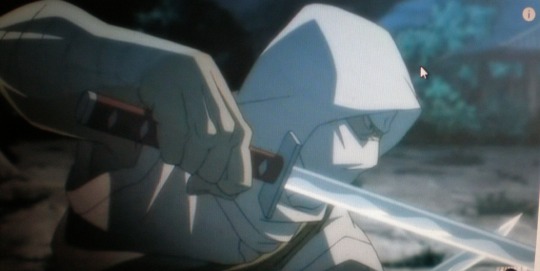
This version of Storm Shadow (Voiced by “every Beagle Boy on Ducktales” Eric Bauza) stands out amongst his post-2000 incarnations as an unrepentant psychopath, but still falls in line with the prominent view of Storm Shadow as a villain--one of the main villains with a special hatred for his GI Joe counterpart.
This is the version I grew up with. GI Joe vs Cobra through Sigma 6 were the prominent Joe adaptations when I was the target demographic and all throughout Storm Shadow was a bad guy to varying degrees.
I knew in the classic Hama stuff he eventually defected, but I was not prepared for just how much he’s a heroic character from the start. There’s no big sword dual with Snake Eyes, no Anakin and Obi Wan style “friend turned bitter enemy” dynamic. It’s made clear from jump that Tommy is undercover in Cobra and remains an honorable man in search of justice. He leaves Cobra quickly and is branded as a Joe in all his figures until 2000--when they started packing their characters in two-packs with one Joe and one Cobra. In all appearances, Storm Shadow is more a Joe than a Cobra. So what led to the the modern view of Storm Shadow as a bad guy, who, even when he gets his redemption, still has a mean streak and a cruel manner? How did a character in a toy driven franchise who had more toys as a hero than a villain end up as one of the franchise’s most consistent villains?
*(For simplicity’s sake, this is only going to cover film and television portrayals of the character).
*Spoilers for pretty much every GI Joe adaptation to follow.
The first portrayal of Storm Shadow as Cobra Commander’s loyal and competent hatchet man (one of the few) is not too much older than Hama’s original Marvel version. The Sunbow version of Storm Shadow (voiced by “guy you’ve heard in everything” Keone Young) remained a loyal cobra agent--with none of the Hama version’s depth.

He had what you might call “standard cartoon Ninja honor” where he clearly had some kind of code of ethics, but was primarily an arrogant killer (as much as he could be in a cartoon) who fought primarily with Spirit and Quick Kick (voiced by wonderfully talented “guy you’ve seen in everything” Francois Chau) as Snake Eyes was largely shunted to the side in the cartoon. The echoes of Sunbow Storm Shadow can be seen in pretty much every non-comic adaptation that followed.
Skipping right over the Dic continuation of the Sunbow cartoon because Storm Shadow actually is a Joe in that, as he was in the comics and figures of the time (and because I haven’t seen it) we come to the 2000′s era.

The Spy Troops and Valor vs. Venom DTV movies had a Storm Shadow (voiced by “guy who got his blood ripped out by Magneto in X2: X-Men United” Ty Olsson) who was essentially his Sunbow self with one major change. He actually had a history with Snake Eyes, and a bitter rivalry. The details are not gone into in either film (you get a little more in the figure file cards and mini-comics of the era) but Storm Shadow accuses Snake Eyes of betraying the Arashikage. The implication being that either Storm Shadow blames Snake Eyes for some crime or another or that there was a schism in clan.
The File cards of the time movie go from acknowledging Storm Shadow’s time as a Joe, and claiming he’s working with Cobra again for unknown reasons, to establishing their own canon that Snake Eyes and Storm Shadow were once best friends and “Sword Brothers” before Storm Shadow fell to the dark side and joined Cobra. Though Storm Shadow’s file card does end with the ominous implication that he’s got his own agenda in working with Cobra (just like his Hama incarnation) the DTV films imply that he’s a Cobra loyalist in addition to his feud with Snake Eyes.
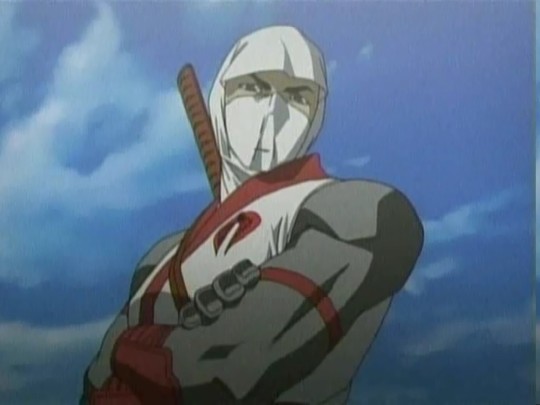
Spy Troops and Valor vs. Venom lead in a semi-canonical way to GI Joe Sigma 6 where Storm Shadow (voiced by “guy whose only other role I recognize is pulling double duty as Zeke Stane and Living Laser in the Iron Man 3 videogame” Tom Wayland) more or less continues the previous two iterations’ version of Storm Shadow. He once again accuses Snake Eyes of some great betrayal that broke their friendship. The GI Joe website at the time includes the detail that Storm Shadow was infiltrating Cobra when he was brainwashed into becoming a loyal Cobra agent. It’s another concession, like his 2001 file card, to Hama’s heroic double agent, while still portraying him in line with Sunbow’s villainous henchman.
GI Joe Resolute comes next, where we see a departure from any pretense of Storm Shadow being a good guy. Resolute, in many ways, comes off as a gritty direct continuation of the Sunbow series, and it takes Sunbow’s villainous Storm Shadow and strips him of even the token bits of honor and humanity he had. It also, as near as I can tell, begins the trend of Storm Shadow outright resenting Snake Eyes, rather than being his one time friend.

As an irrelevant aside, I have my problems with Resolute but I do love everyone’s character designs and Eric Bauza does a fantastic job as one fourth of the cast. His Sean Connery impression for Destro is particularly inspired.
This brings us to the big ones. GI Joe: RIse of Cobra and GI Joe: Retaliation where Storm Shadow is brought to the big screen by Lee Byung-Hun (who I don’t have a snarky/informative aside for because shamefully despite how prolific he is I’ve only seen him in these movies and The Magnificent 7 remake) and as a child by Brandon Soo Hoo (he’s also been in a lot of stuff, but I particularly liked his turn as Beast Boy in the animated New 52 DC movies).

Lee’s Storm Shadow in the first film falls in line with his portrayals up to this point, probably skewing most closely towards Sunbow. He has a code of ethics (he doesn’t kill women apparently) but he’s still a bad guy and he seems to quite like it. Lee brings a charm to the character that had not really existed up until that point. He also spends a lot of time maskless (and it’s hard to blame the production team for that one, he’s a very handsome dude) which was a shock for anyone who grew up with the 2001 era storm shadow where the thought of him without a mask was so insane that it was relegated to a mail in figure (As a kid I seriously thought he had some Mandalorian style code of not removing it)
His origin in this version takes bits of Hama and bits of Resolute (or Resolute took from this, Resolute came out first but this might have been in development). It is, as far as I can tell, the first version to have Storm Shadow and Snake Eyes train together as children and it portrays Storm Shadow, even as a child, as an arrogant and jealous person.
Now, at least in my opinion, it’s fairly obvious that the first movie fully intended Storm Shadow to be a baddie, full stop. There’s a little wiggle room given that we never see him stab The Hard Master in the flashback (the Hard Master in this version is Storm Shadow’s father rather than his uncle) but the way he taunts Snake Eyes about it during their final confrontation makes a pretty compelling case for his having committed patricide.
The sequel would bring back elements of the Hama backstory. Zartan killed The Hard Master and Storm Shadow had to infiltrate Cobra to discover that. Given Cobra Commander and Storm Shadow are of roughly the same age (Storm Shadow being a bit older I think) and this event occurred when they were both children it’s unclear on who’s orders Zartan did this but we do know it was done to turn the already volatile young man into the perfect angry ninja assassin (given this canon is pretty much over we’ll probably never know for sure, but my guess based on the IDW movie universe comics is that Zartan either did it at the behest of the Red Ninja Clan or just to have a tiny assassin of his own, probably the former since they seem to regard each other as unpleasant colleagues who sometimes work together).
What I particularly like about this version is that, because the first movie portrayed him as this charmingly sadistic Bond Villain henchman, even after he switches sides in the sequel he’s still kind of a belligerent dick. It’s a fun piece of characterization that even once he’s cleared his name, avenged his father, and made his peace with his family, it doesn’t change the fundamental fact that he’s not a very nice person.
This is something that would persist into the next (and for the moment last, but more on that later) onscreen version of Storm Shadow.

GI Joe Renegades (the best GI Joe Cartoon, fight me) saw Storm Shadow (voiced by “holy crap this guy originated the role of Saw Gerrera in Clone Wars” Andrew Kishino) as the leader of the Arashikage Clan (explicitly a crime syndicate, harkening back to implications in Hama’s version) who operates independent of Cobra except very briefly and only to fulfill his own ends (again bringing him closer to Hama’s version than any of his predecessors). Falling in line with the implications of the movie and Resolute, he and Snake Eyes were uneasy classmates more than friends and trained together as teenagers. An attempt to kill Snake Eyes went awry and resulted in the death of the Hard Master (who again, seemed to favor Snake Eyes over his own nephew). Storm Shadow believes Snake Eyes to have killed The Hard Master(somehow failing to connect the dots given his own murder plan failed the same night Snake Eyes allegedly murdered his uncle--or hell he’s probably just in denial until the truth slaps him in the face).
Also, irrelevant aside number 2, in contrast with Resolute I really don’t like this character design. Renegades had pretty good character design all around, neatly bringing together various versions in a way that felt coherent but I don’t like the little tufts of hair sticking out of the mask or the way it kinda hangs in front of his mouth. Is he hiding his face or not? It seems like he’s not so much wearing a mask as a bandana and an oversized turtleneck.
This version neatly ties together the “Snake Eyes betrayed us” of the early 2000′s, the “arrogant unfavorite” of the mid 2000s and the “out for justice assassin” of Hama’s run. He is, again, an arrogant prick from the start, but his genuine shame and resolve to abandon his quest for vengeance and his extremely short partnership with Cobra make his eventual redemption (or the start of what you assume would have been a longer redemption arc had the series continued) more believable than the live action movies--if a mite less fun.
And that’s where it ends, at least until the much delayed Snake Eyes live action movie is finally released, where Storm Shadow is set to be played by “guy from the best episode of American Gods Season 2″ Andrew Koji. I quite like the look of the cast of this movie, and I’m excited to see what Koji brings to the role. Will Storm Shadow be arrogant, murderous, honorable, charming, brooding, misunderstood, cruel, vengeful...some impossible combination of all of the above? We’ll have to wait and see.
*Including the various alternate comic book versions probably would have painted a more complete picture, but I’ve only read Hama’s run and the IDW reboot (where Storm Shadow is kind of a non-entity), besides this was more about tracing Storm Shadow through the adaptations I watched as a kid.
*None of the adaptations seem to go with Hama’s original detail that Storm Shadow and Jinx were from Northern California. On the one hand I see why you transplant them to Japan with the rest of their family (it’s a globetrotting element and makes the cast more cosmopolitan) but I always liked the idea of that they were children of immigrants.
*Adaptations have been touch and go about casting Japanese actors in the role but I was impressed to find out that Sunbow cast Japanese Americans as both Storm Shadow and Jinx, making them probably the most faithful casting in relation to their original backstories.
*Apologies for my complete inability to get screenshots of roughly the same size or resolution.
58 notes
·
View notes
Text
So, re: the Josh Duggar (fuck him to infinity and beyond) stuff: I don’t know if anyone else is following his arrest, but he had a bond hearing last week, and someone who was able to attend the hearing (via Zoom, of course) did a really great write-up of the details on Reddit and provided a lot of helpful links, so I was following that thread. The hearing of course went into more detail regarding his alleged crimes, and I’ll put that under a cut. Note that I’m not going into graphic detail, for one because it’s not necessary to do so to talk about how serious this is, and for two because I don’t know it. Based on the way people were tiptoeing around actual descriptions of the images he possessed, I knew that was a google rabbit hole even I couldn’t go down. I sincerely urge you not to google it; many people described reading the Wikipedia article about a notorious piece of child sexual abuse material that was on his computer and feeling nauseated, despite the fact that the article didn’t go into super explicit detail. Don’t do it for morbid curiosity; even I’M not that self-punishing.
He had an internet accountability program on his computer called Covenant Eyes which is a sort of family internet filter that monitors activity to keep your kids (or husband in this case) from seeing anything inappropriate. I would assume this was on Josh’s computer because if I remember correctly, either before or around the time of the Ashley Madison scandal, there was some Jesus kerfuffle over him viewing porn. A sex worker also came forward to say that he assaulted her during a paid sexual encounter, so I’m sure the family had Good Christian concerns about how his proclivities were tarnishing their reputation. (Not concerns about their daughters literally getting molested, of course; but that was their fault for being girls.) This was a personal work laptop that I’m sure their kids didn’t have access to, so this was probably specifically meant to monitor him.
He also had disc partitioning software on his computer, which enables you to run multiple operating systems at once. There are plenty of legit reasons to do this; you can use it for gaming or IT purposes, and I’m sure plenty of other things as well. In addition to this, however, he had a dark web browser, so any defense he tries to mount that argues these got on his computer accidentally while he was viewing regular porn isn’t going to fly; he very clearly went looking for this, and took steps to cover his tracks. Partitioning or accessing the dark web apparently do not require someone to have super advanced computer skills, but they DO require some research; neither is something that accidentally happens by clicking on the wrong link.
Investigators found over 200 images (and one video) of child sexual abuse media that were downloaded and deleted in just one day. Offenders often have loads and loads of images, so the speculation is that there are probably many more, but these are the images they have an airtight case for, i.e. they can prove absolutely that Josh himself was the one who downloaded and accessed these images, since digital crimes can be a bit trickier to prove since a lawyer can argue that a client’s computer may have been used, but it was not the client themselves engaging in the illegal activity. He also might have been extraordinarily unlucky and got caught his first time doing this, or (and what I unfortunately suspect), he’s been doing it for a while, deleting/moving the images elsewhere, and some activity caught the eyes of the Feds somehow or possibly someone turned him in. (There is some speculation that one of his brothers reported him; one of them worked at the same car lot that was raided, and reportedly came home very shaken one day not long before the raid. He also was very quiet on social media and didn’t defend Josh, nor comment on the raid, which some people are speculating is due to the fact that he’s involved in the investigation. This is, again, speculation, and I don’t know how accurate or likely any of it is.) It’s also possible that, due to the nature of some of the material he downloaded, which is apparently a piece of child sexual assault media notorious for being the worst of the worst, he was flagged by Feds monitoring that particular piece of media, and got caught that way.
I listen and watch quite a bit of true crime media, and I had never heard of this before, but apparently the video he downloaded was part of a series that was once considered an urban legend, because it was so over-the-top vile. People realized it was real when the man who produced it was arrested. I’m going to caution you again here: do NOT google this. I’ve seen lots of posters on reddit reporting that they felt sick just from reading fairly non-specific descriptions of what the video contains. It involved a 11-year-old, an 18-month-old, and a third child whose age I can’t recall. (And I’m not going to go looking for it, because in reading up on this case I started stumbling across people being a little free with their descriptions of the images, without any warning, so I’ve taken a break from looking at that to avoid running across knowledge I don’t want to have.)
One of the investigators who testified said it was one of the top five worst of the worst cases that he’s seen, and these investigators work lots of theses type of cases. The film mentioned above involves actual torture of the children involved; the 11-year-old was murdered. It’s a little unclear how much media he had relating to this film, but he had a two minute video clip which I believe was from the film; I don’t know if there were any still images. Regardless, as bad as ‘normal’ child sexual assault media is, he was in possession of some incredibly violent material against children that had seasoned special agents remarking on the severity of it.
He’s a dangerous sexual predator; this is beyond even pedophilia--this seems to be straight up sadism.
27 notes
·
View notes
Text
ABSOLUTELY EVERYTHING WE KNOW ABOUT THE UMBRELLA ACADEMY SEASON 2
Hello! This covers everything from trailers, promo pics, interviews, and articles. Pics and links will be included. The info is in vague chronological order (as much as it can be.)
Needless to say, this post contains SPOILERS and is LONG ^‿^
If you’d like a non-spoilery version with just the basic facts please check out my Umbrella Academy Timeline.
***********************************************************************
According to Steve Blackman, season 2 is about second chances and the endgame is still to stop the 2019 apocalypse (X).
The opening scene of season 2:
youtube
The siblings arrive in the past at different times, but all in the same spot - an alleyway with some dumpsters which leads out onto a high-street.
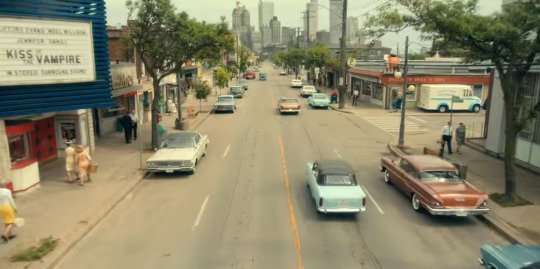
Noticeable locations on the high-street include a beauty salon for black people, and an electronics shop which later on closes down and becomes a base for the group.
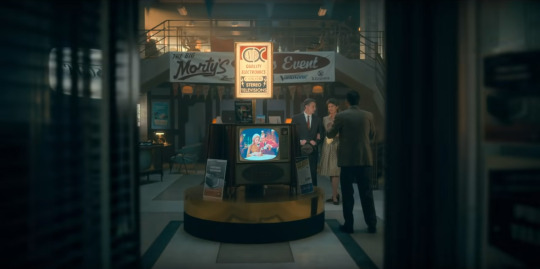
The order they arrive in is the order the promo pictures were released: Ben & Klaus, Allison, Luther, Diego, Vanya, Five.
It will likely take a while before the whole team is reunited, and possibly longer before the siblings begin to meet the new characters: “It was several episodes before we all started to interact with each other” (X).
Ben & Klaus land in February 1960 (X). As Klaus is sober, his powers continue to develop and he uses them to impresses some people. (X)

"Klaus effectively starts the hippie movement off early by founding a cult whose philosophy is based on the lyrics of pop songs that have yet to be written. “Don’t go chasing waterfalls. Please stick to the rivers and the lakes that you’re used to,” he tells one awed follower." (X)
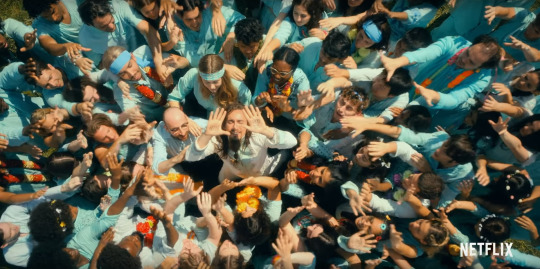

"Destiny's Children! Let us commune with music." *starts whistling*
But Klaus isn’t as happy as he seems in this new life of cult stardom. “He can’t deal with the praise; it’s just become strangulating.” (X)
There’s also tension between Klaus and Ben, but its unknown whether this is because of the cult, because Klaus is "trying to rekindle his relationship with Dave" (X), or because Klaus’ evolved powers mean Ben can now possess him (X). Either way, Ben’s “determined not to be invisible to the ones he loves, willing to go further than ever before to make his presence known.” (X)
As Klaus is wearing the same outfit as the promo pics (and has a long beard which he later loses), its likely the following scene takes place early on.
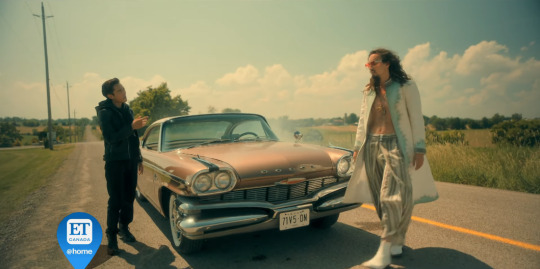
Klaus: Now what?
Ben: Remember when I told you the engine was overheating?
Klaus: Yeah, well, being smart doesn't make you interesting.
Ben: Neither does your beard.
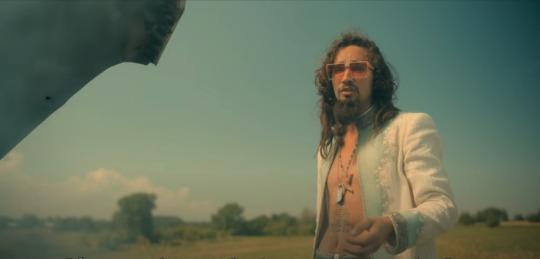
Ben: You think I’m just going to keep following you everywhere for another three years?
Klaus: Yeah, you are my ghost-bitch, remember?
*************************
Klaus: My skin was on fire!
Ben: Good! I’ve got to get to San Francisco, I have unfinished business.
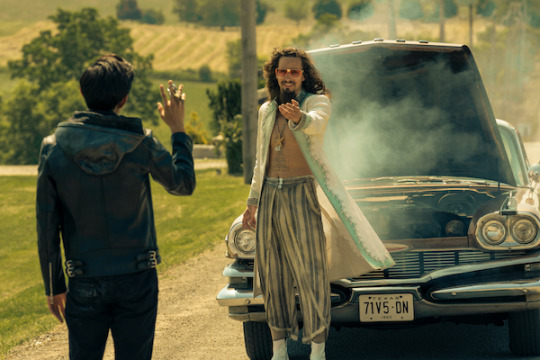

Allison is second to appear in 1961 (X). "Confused and looking for help, Allison walks into a diner and is greeted by a “Whites Only” sign, then chased across town by a group of white men until she finds sanctuary in a beauty parlour for Black women that doubles as a meeting place for civil-rights activists." (X)
Its been confirmed that the below image is from ep 1. (X)
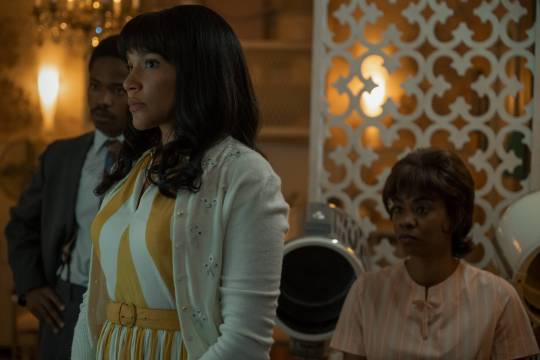

Have you experienced discrimination by your employer?
She meets a man named Raymond Chestnut who is a “born leader with the smarts, gravitas, and confidence to never have to prove it to anyone. He has the innate ability to disarm you with a look, and is a devoted husband.” (X)

Luther appears on April 10th 1962 and lands on a dumpster.
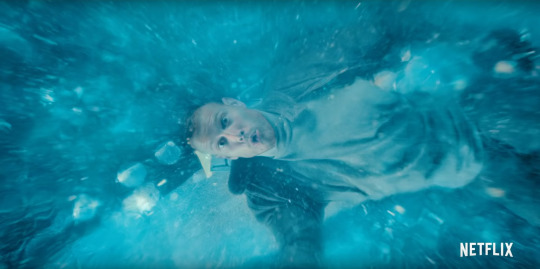
He ends up working for Jack Ruby (X), a mysterious man who owns a nightclub (and who fatally shot Lee Harvey Oswald after Oswald was in custody for JFK's assassination). Luther’s job involves being a driver, bouncer, and underground fighter.
Its been confirmed that the following scene is from ep 1. (X)
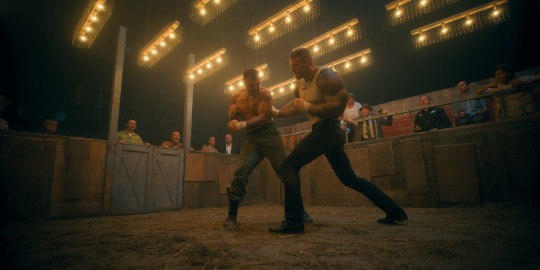
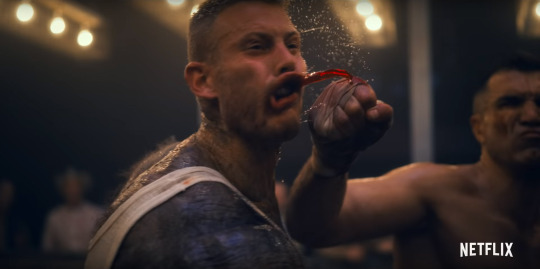

Diego appears on Sep 17th 1963. One of the first things he sees is a televised address from President JFK.
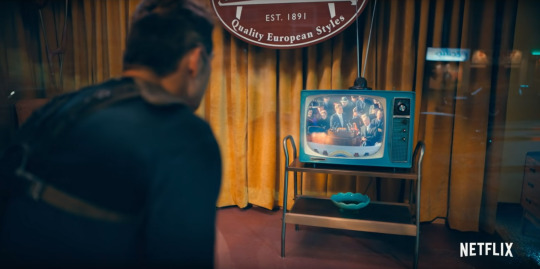
He ends up in an insane asylum for stalking Lee Harvey Oswald and spouting “delusional claims” about JFK’s assassination (X). Its here he meets Lila Pitts, “a chameleon who can be as brilliant or as clinically insane as the situation requires”. She’s also "unpredictable, mischievous" and "sarcastic" with a "twisted sense of humour." (X)

Vanya appears on Oct 12th 1963 (X). “She arrives and gets hit by a car, driven by a woman (Sissy). She smashes her head on the cement... She remembers her name, but nothing else.” (X)
She gets a job on a ranch as a live-in-nanny for Sissy, a "fearless, no nonsense Texas Mom" who "married young for all the wrong reasons" and is "eager to rediscover what love has to offer." (X)

Because she has forgotten her past traumas, Vanya is “much more confident and more in touch with her emotional self” (X). She forms a unique bond with Sissy’s son, Harlan, who is non-verbal (X). Its been confirmed that the following photos are from ep 1. (X)

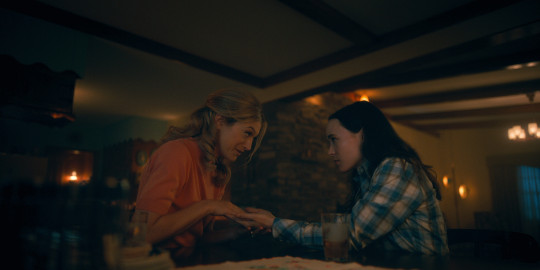
Vanya: I wish I remembered something.
Sissy: The doctor said it would take time. Don’t push yourself.
Vanya is also slowly discovering her powers on her own.
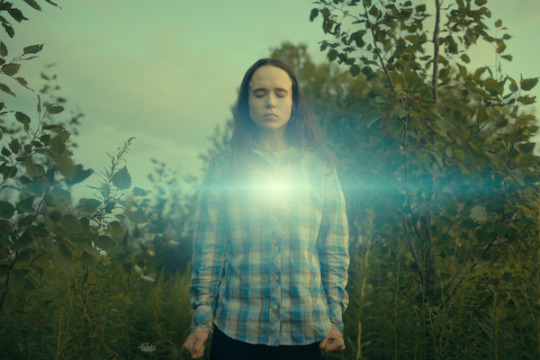
Five appears with Hazel on Nov 15th after witnessing the world going down in nuclear explosions.
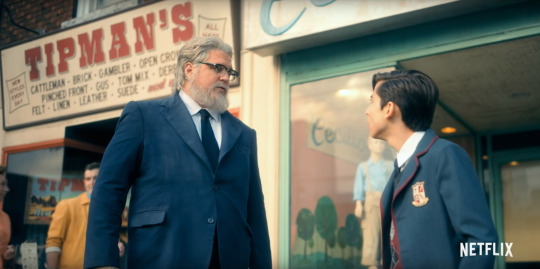
Five: What was that?
Hazel: The end of the world, November 25th 1963.
Five: And where am I now?
Hazel: Dallas, ten days earlier.
Five: ...I need to find my family.
But of course its not going to be that easy, the Commission is still out there and “will hunt us down wherever and whenever we go.”

In the trailer we are introduced to the head of The Commission, a fish named Carmichael. He sends three Swedish assassins, Oscar, Axel, and Otto, to hunt down Five and the others.

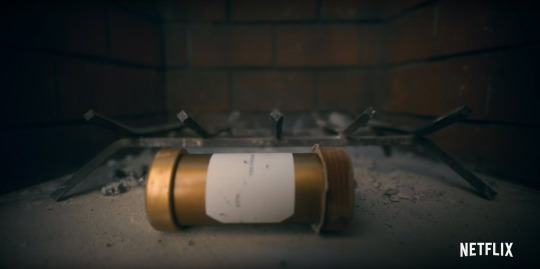

At some point they acquire a milk-truck and one of them dresses as a milkman. On a location shoot, the Swedes were seen in their truck outside a house in an urban area. They check a map and one of them pumps a shotgun (X).
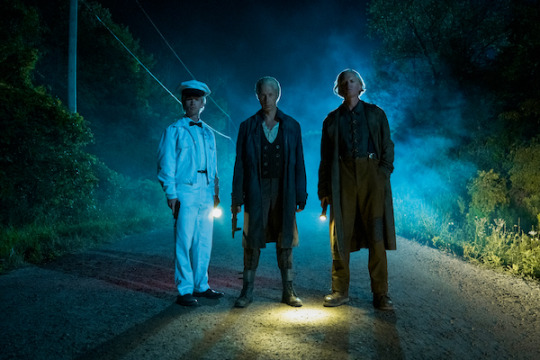
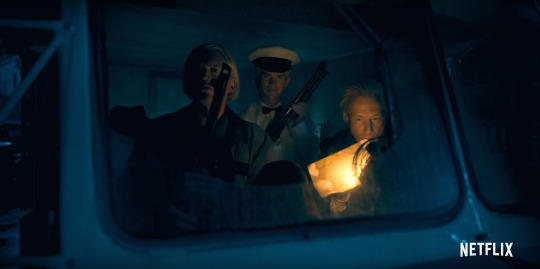
Whilst searching for his siblings Five encounters a man named Elliot, an "alien obsessive (who) witnesses The Umbrella Academy's separate arrivals." He agrees to help Five find the others. (X)
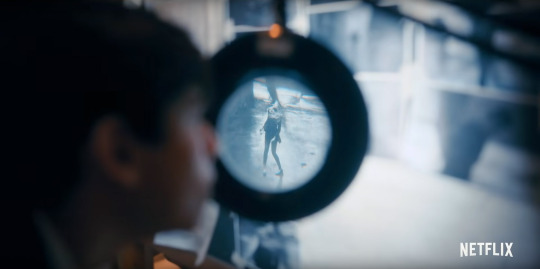
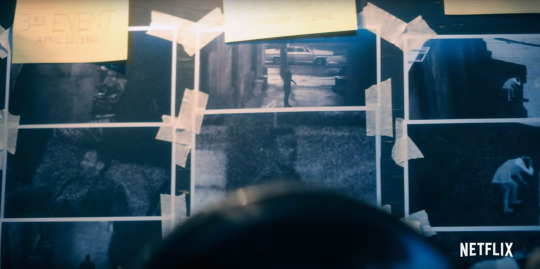
“3rd EVENT, April 10th 1962″ is above photos of Luther arriving, “September 17th 1963″ is above photos of Diego arriving, and the right column are photos of Vanya arriving still in her White Violin outfit.
Five manages to find Diego in the asylum and they have a conversation.
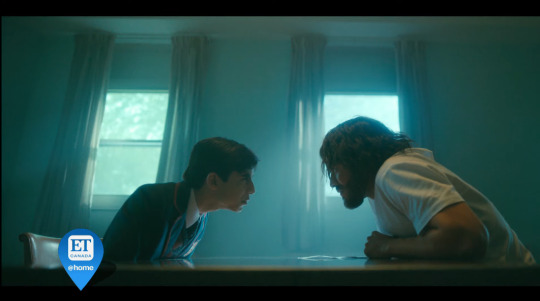
Five: Listen to me very closely, you gibbering moron. You are not going to do a goddamned thing.
Diego: Why not?
Five: Because we have to stop the apocalypse.
Diego: But that doesn't happen for another 60 years.
Five: Not that apocalypse, this is a... new one. It followed us.
Diego: *begins laughing*
At some point after this the Swedes storm the asylum.
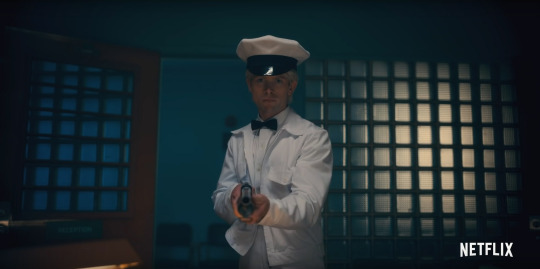
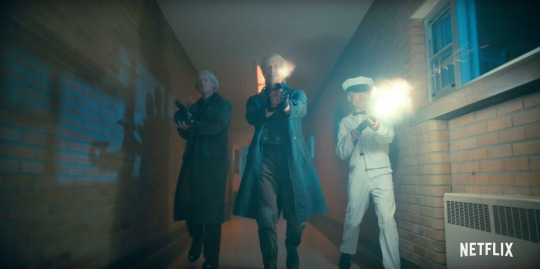
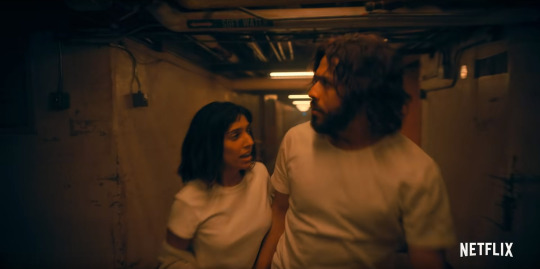
“Who are those guys?!”
Diego and Lila seem to make their escape from the Swedes and the asylum pretty quickly however. Its been confirmed that the below pic is from ep 2. (X)
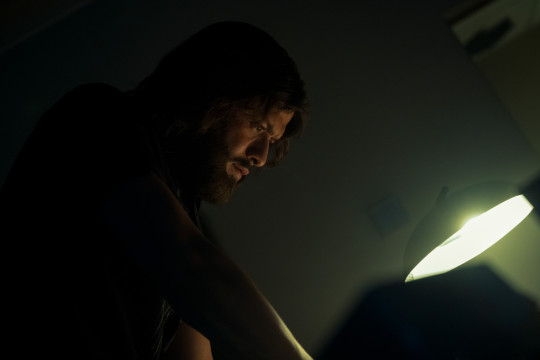
Based on Diego’s outfit and length of beard, the following two scenes take place around the same time. First, a heated car conversation which Five crashes.
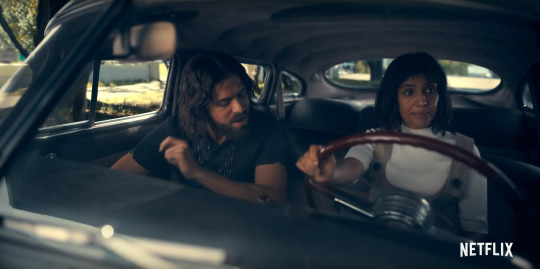

Diego: You don’t know anything about me!
Lila: I know everything. You are an open book written for very dumb children.
Diego: I am n-not trying to b-be a hero, okay?
Lila: Then why are you doing this?
Five: *appears in the backseat* Because he is an idiot.
Lila: Who the hell are you?
Five: Hi, I’m his loving brother.
Diego: Who left me to rot in the nut-house.
Five: To protect you from yourself.
Lila: Thats quite sweet.
Diego: Okay. Both of you. Out.
And second, a dark encounter with a familiar figure...
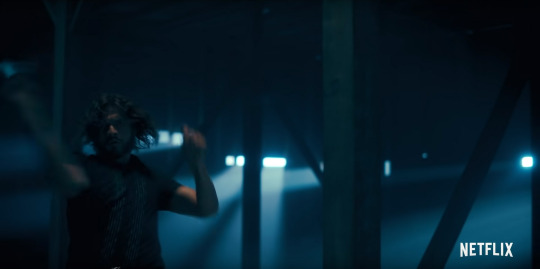
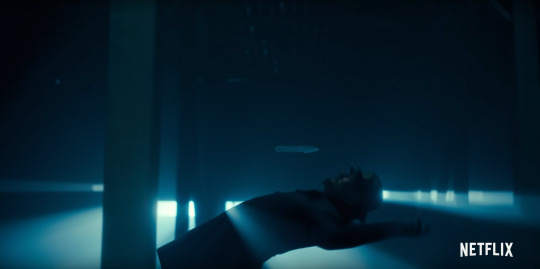
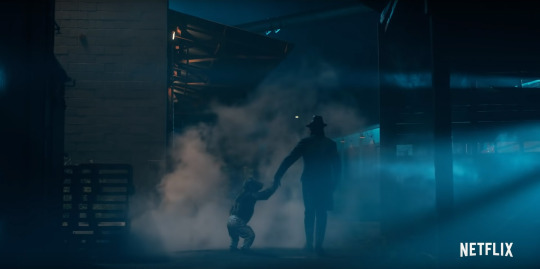
Reginald Hargreeves & Pogo
The summary for episode 2 also mentions that “an incident at the bar leads Luther to Vanya,” and “Five finds an unsettling surprise in the film Hazel left behind,” which likely links to this image:

Its been confirmed that the following scene is from ep3 (X). Klaus is seen emerging from a river - now confirmed to be the River Ganges in India/Bangladesh which is considered sacred and purifying (X). Considering the series spans 10 days and is set in Dallas, this scene is very likely a flashback.
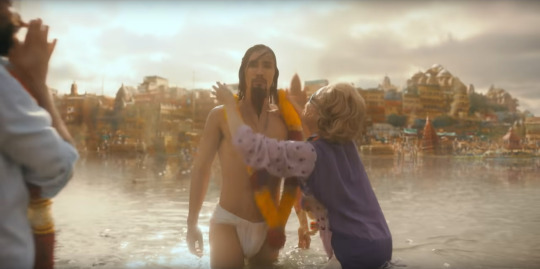

Note Ben in the background.
Klaus is also seen in similar attire in a wealthy looking house, which is potentially part of the commune where the cult operates.

Note Klaus no longer has his long beard.
And here’s Ben in what looks like a room in the same house. It's interesting to note that Ben (or the actor) is looking straight into the camera, implying its a first person point-of-view.

Apparently also in ep3 we have this delightful gem of Klaus being Klaus. (presumably theres a pool at the commune?).

Episode 3 also sees the Swedes chasing Vanya in a cornfield until she uses her powers to defend herself.
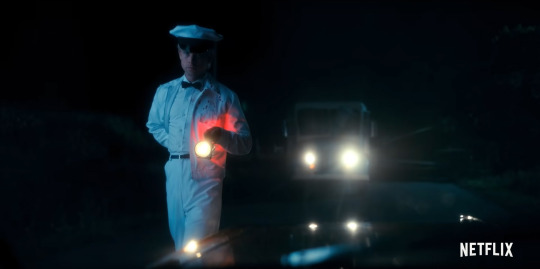
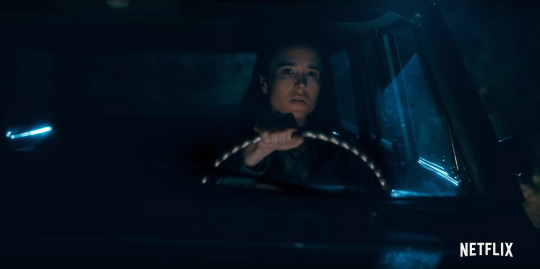
youtube
Thanks to this, Five is able to track Vanya down (X). It's been confirmed that the following pic is from episode 3. (X)

And based on Vanya's clothes, Five then takes her to a cafe to explain a few things.
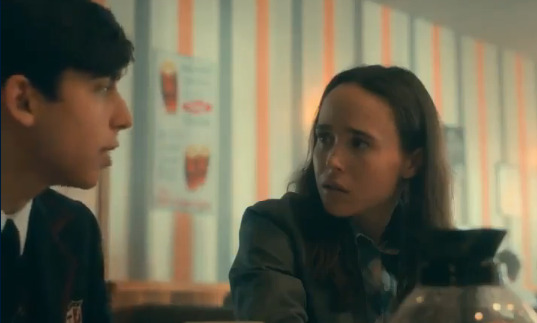
Vanya: Are you gonna tell me what the hell's going on?
Five: When you were a baby you were bought by an eccentric billionaire. He raised you in an elite academy with six other siblings with extrodinary powers, but in the year 2019 in order to avoid the apocalypse we jumped into a vortex and ended up being scattered throughout the timeline in Dallas, Texas.
Vanya: ...
Five: Any questions?
Vanya: ... what do you mean the apocalypse?
At some point ollowing on from this (but unknown which ep) Luther and Vanya have this conversation:

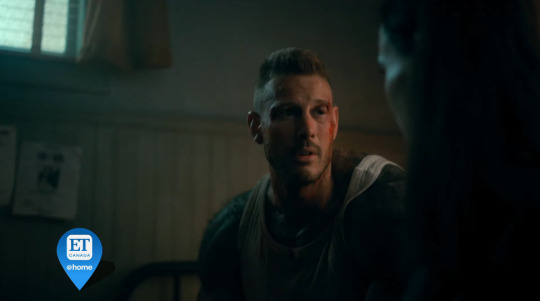
Vanya: What caused the apocalypse?
Luther: ... You did... but not alone. I was part of it, we all-
Vanya: How?
Luther: You got angry. Lost control, you... blew up the moon. It slammed into Earth wiping out everything.
In ep3 we see both Allison and Raymond actively involved in the protests against the segregation by taking part in a sit-in (X).
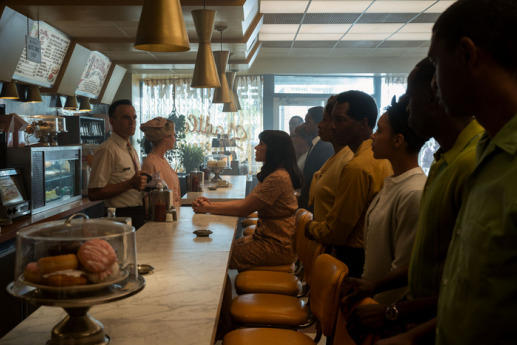
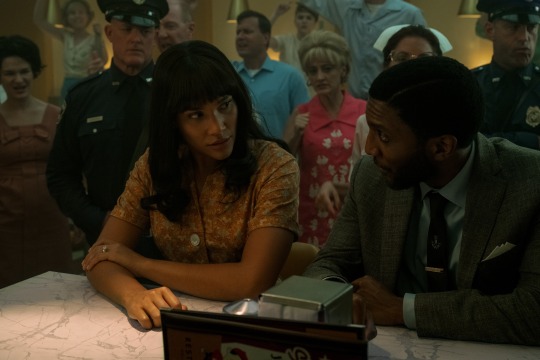
Allison: I’d like to be served, please.
Waitress: *pointing to a Whites Only sign* Can’t you read, girl?
Allison: Seven languages.
Customer: Oh, you smart one, huh?
*The door opens and many other blank protesters enter.*
Allison: We’d like to be served, please.
However, it goes badly as "police brutally attack (the) peaceful protestors." (X).
The summary for ep3 says that “Allison reconnects with Klaus,” and in ep4 she is “searching frantically for Ray.” It seems, based on the following pics, that she finds Ray in jail and Klaus & Ben have a hand in getting him out.


Note the word "buearu" on the window and Ray in the background.
Based on Klaus' outfit, its sometime around this point he goes on a massive bender. We see him running with a bottle of whiskey, his gleeful cult following him, and dancing in a drinks aisle.
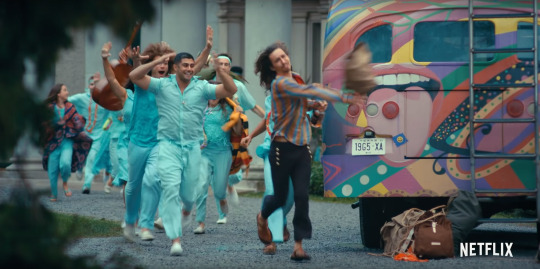

Note that Klaus is bleeding from his lip.
Following on from this, Klaus wakes up on Allisons floor, feeling worse for wear.


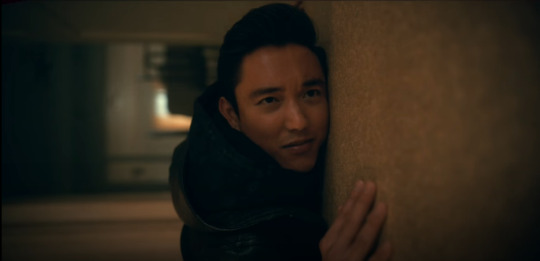
Ben: And how are we feeling this morning?
Klaus: Ugh, peaches and cream, how are you?
Ben: Curious. How many more rock bottoms are you going to have to hit before you start taking care of yourself?
In episode 4 “Vanya contends with a crisis at the farm.” Could this link to her developing romance as, despite Sissy still being with her husband (X), she and Vanya begin exploring a relationship?


The summary confirms that in ep4, “Five, Diego, and Lila crash a party at the Mexican consulate.” But the Swedes are still hot on their tail.
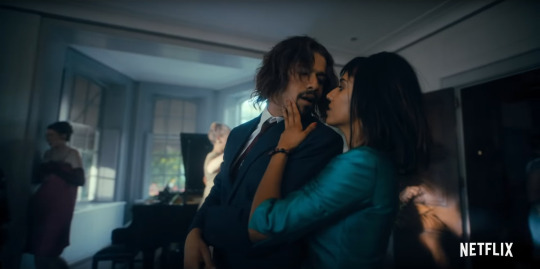
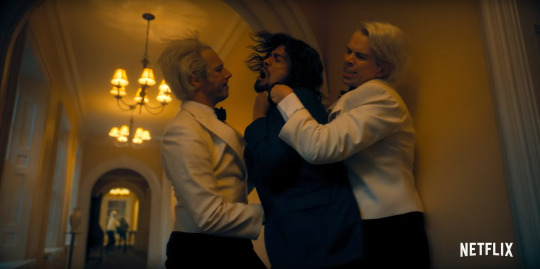
Note the third Swede in the background, chasing Five?
After surviving this, they return to their base. The following pic has been confirmed as happening in ep4 (X).
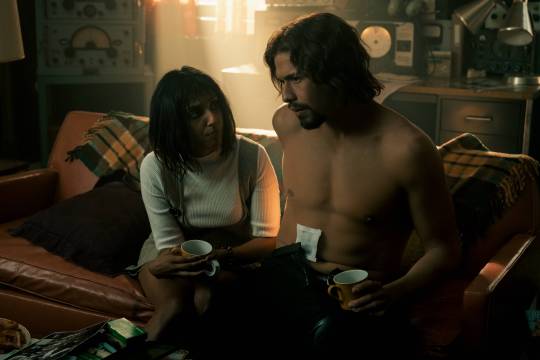
At some unknown point the Swedes (or two of them) also go after Allison, though it appears she fights back (and kills one of them?).
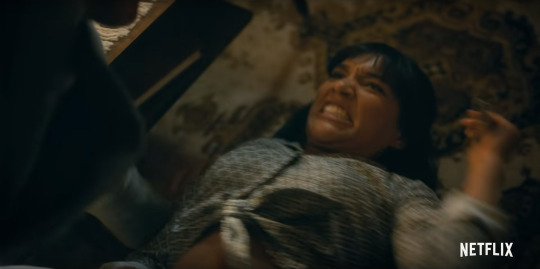
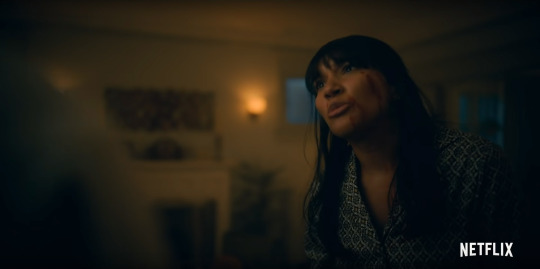
"They weren't here to sell vacuums!"
Also at some unknown point, Allison and Luther have a catch up. Based on Luthers partially healed face, this is after his conversation with Vanya in ep2.


Luther: We did it again… apparently.
Allison: Did what again?
Luther: Ended the world.
Also at some unknown point Vanya and Diego reconcile: “I don’t remember what I did, but I’m sorry, if that means anything,” Vanya tells Diego as he threateningly juggles a knife. “It does,” he responds, before accepting her as a confidant he can turn to for advice on how to handle his feelings for Lila. (X)
It appears that ep5 is when the whole family finally reunites. The episode summary explains how “summoned to an emergency meeting, the siblings hatch very different plans for how to spend their last 6 days on Earth.” (I have no idea what order the conversation goes in as each bit is a snippet from a different promo vid).
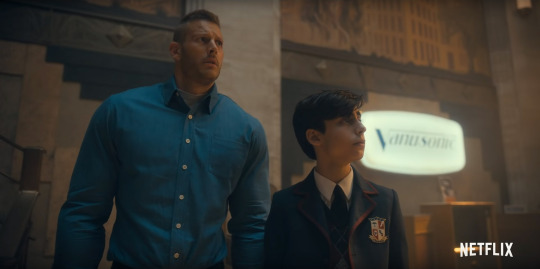
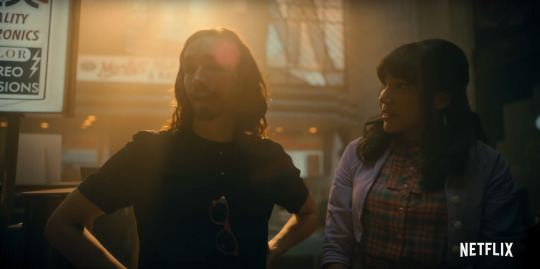
Five: Klaus, is Ben here?
Klaus: No, unfortunately ghosts can’t time-travel.
Ben: Are you kidding me?

Five: (I/We) really screwed the pooch on this one, the whole going back in time and getting stuck thing. But the real kick in the pants here is… we brought the end of the world back here with us.
Klaus: Oh my god, again? My cult is gonna be so pissed. I told them we had until 2019.
Five: We have until Monday.
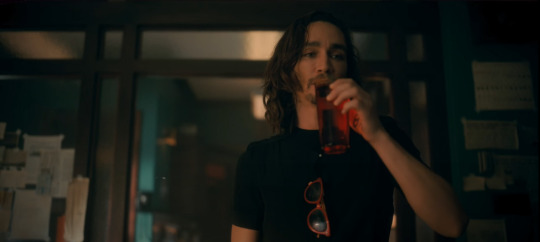
Klaus: Is it Vanya?
Allison: Klaus!
Klaus: What? Its usually Vanya.

Vanya: None of us are supposed to be here, right? I mean, what if its us?

Luther: Diego's been stalking Lee Harvey Oswald.
Diego: Hey, you're working for Jack Ruby!
Klaus: Allison has been very involved in local politics.
Allison: Okay, you started a cult!
Ben: Thank you!
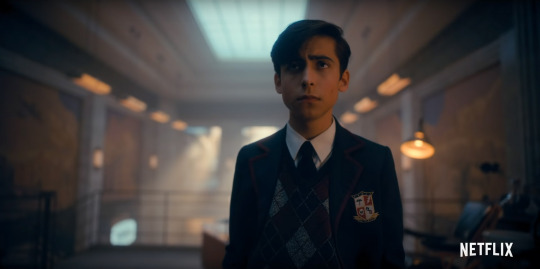
“We have to make it right again, before everyone and everything we know is dead.”
Following on from this, Klaus, Vanya and Allison have some bonding time in the beauty parlour.
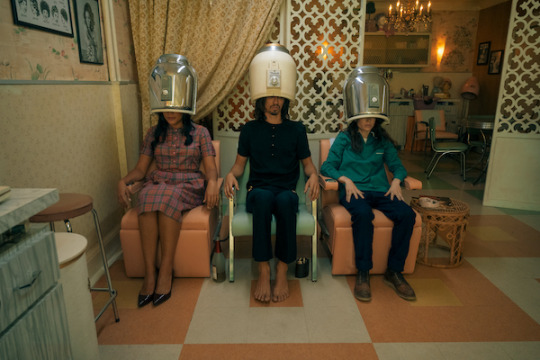
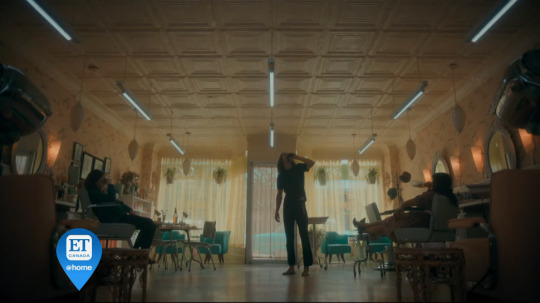
Vanya: How do you guys deal with this?
Allison: What?
Vanya: I mean all of it. Time travel. Seeing the dead...?
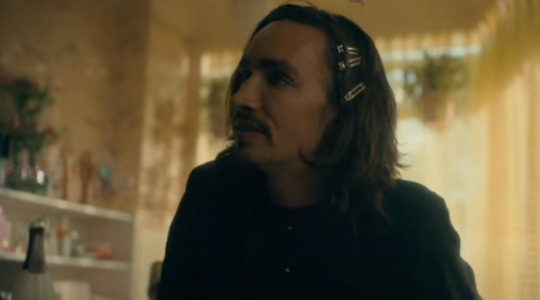
Vanya: I’m gunna tell Sissy that I love her… I don’t want any secrets.
Klaus: Yeah?
Allison: Yeah! Yeah, yeah, you’re right. Yes. Cos, y’know, if, if its all going to go tits up the least I could do is be honest with my husband.
Klaus: Oh… does that mean I have to face my cult? I just hate group breakups, thats why I stopped dating twins.
“Klaus, Vanya, and Allison end a moping session by dancing together to Twistin’ the Night Away.” (X). Its been confirmed that the following pic is from ep 5. (X)

In episode 6, “Dave visits Klaus’ compound” and “the siblings meet their father for dinner” in a Tiki bar. Its been confirmed that the following pic is from ep 6 (X).
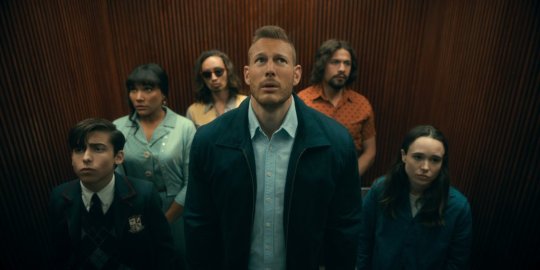
An interview with the cast has them talking about ‘the elevator scene’ and how hard it was to shoot because everyone kept cracking up. (X)
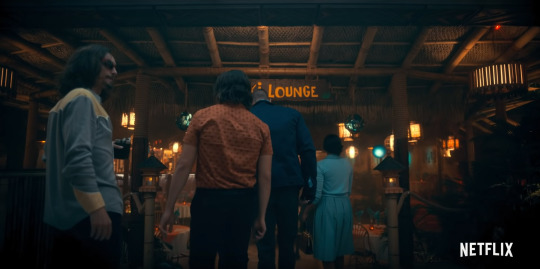
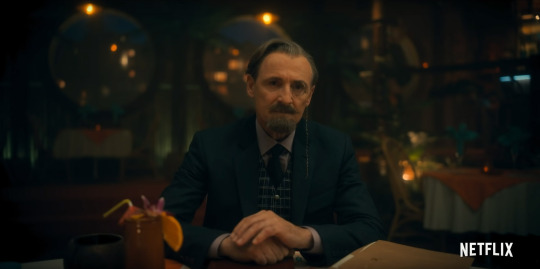
Five: All right, quick run down. Luther; super strength, Klaus can commune with the dead, Allison can rumour anyone to do anything-
Diego: Yeah except she never uses it.
Allison: I heard a rumour you punched yourself in the face.
*Diego punches himself in the face.*
Reginald: *looking at Vanya* And you?
Luther: Uh, maybe we don’t… take Vanya for a test drive.
Klaus: Oh yeah thats probably not a good idea…
Vanya: What, I think I can handle it.
*Despite everyones protests, Vanya explodes a fruit bowl.*
Based on Luther and Klaus’ outfits, the following scenes also take place sometime around the same time (ep6/7).
First, Luther pulls up to a house in an urban area, he gets out the car and has a conversation with a man (X). This is the same house where the three Swedes were seen in their milk-truck at night.

Note the gun and flask on the seat.
Next, Allison and Raymond deal with a body (of a Swede?) while Klaus & Ben don’t help. The summary of ep6 also mentions that Allison gives Ray a peek at her powers, which is maybe why he’s on board to deal with a body.
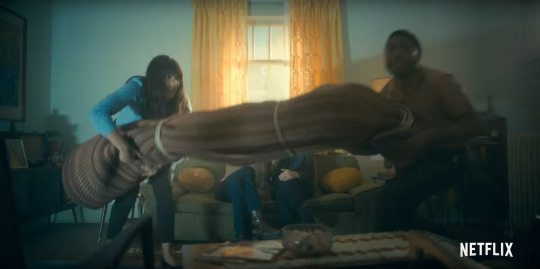
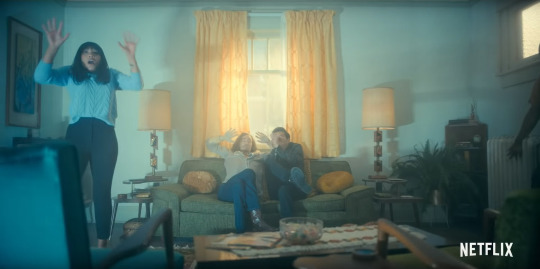
But what's the big flash that startles them? Well it may have something to do with all this craziness:
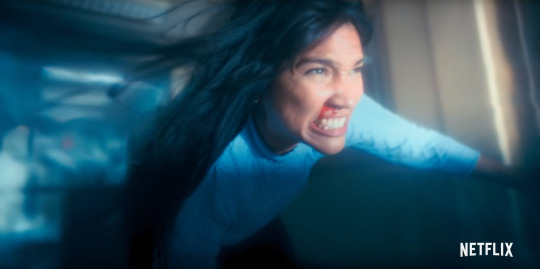
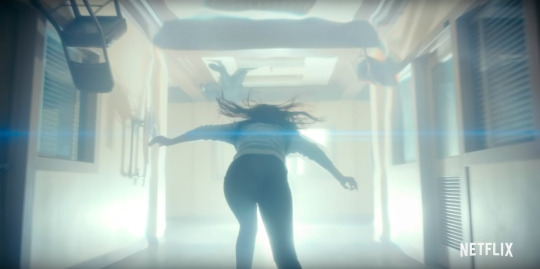

Note the chairs and people on the ceiling.
It’s hard to tell but since Ben is there, this could be Klaus being thrown backwards? The outfit certainly looks similar.

In an interview, the cast talk about how the room had to be painted completely white (then returned to normal), and how nice it was for the character of Ben to be able to share a moment with Vanya (X). This implies Vanya looses control and Ben is able to talk her down.
At some unknown point, it looks like the siblings all return to the academy.

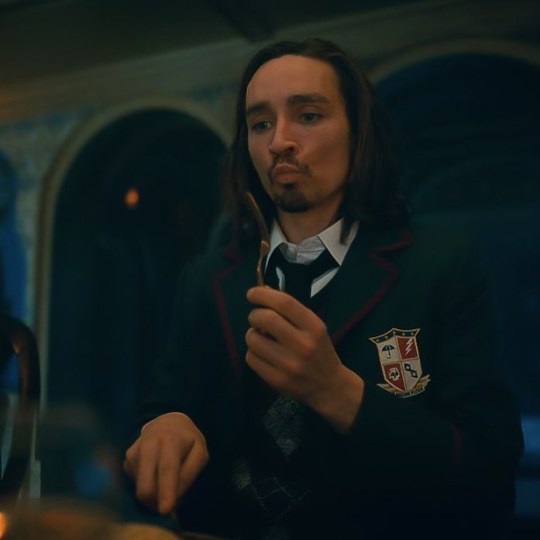
Note that the background behind Klaus implies he’s sat in the same seat that he did as a child.
An interview asked the question "You all eat 'brain' at a family dinner..." (X) and in a different interview the cast talk about the brain acid trip (X). Could this be when that happens?
Either way, things likely don’t run smoothy. “Reginald still proves just as capable of preying on their deepest insecurities, while somehow leaving them attacking each other instead of him.” (X)
The summary for ep7 mentions someone named Carl issuing a warning to Vanya, and in ep8 it states that the FBI torture her, so its most likely the following images are from this time:
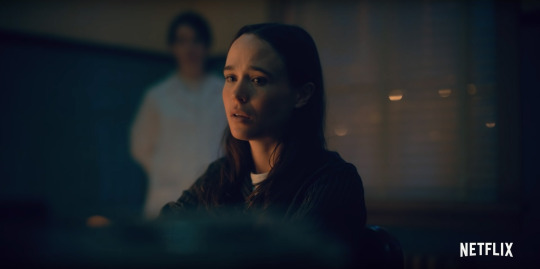
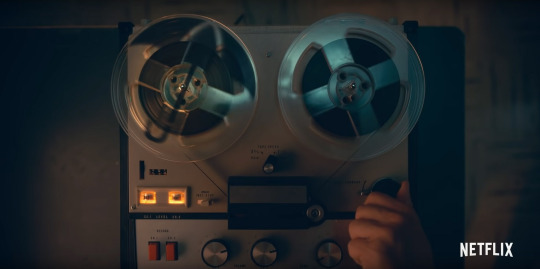
The tape recorder is turned off...

The figure from behind slaps a cloth over Vanya’s face as she takes on the appearance of The White Violin.
“A dimly lit room... Vanya is strapped to a chair. The floor is soaked with water. At the moment she is being tortured for information... After an electric shock the lights on the ceiling begin to flicker.
“‘Is she doing that?’ asks a fearful FBI agent.” (X)
Also in ep7, “Five travels to 1982 to carry out his new mission”. Theres a possibility that Luther is also involved in this as a promo pic has snow surrounding the house, which I don’t think would happen in November in Dallas?
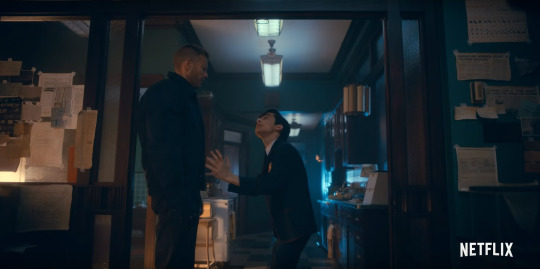
Five: I need a spotter.
Luther: What is that? Like a wingman?
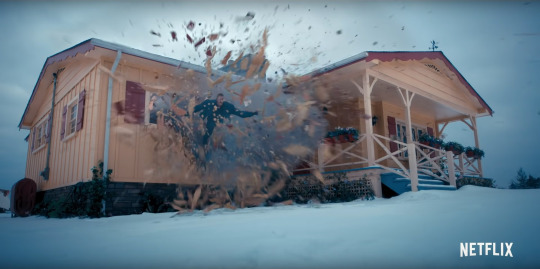
The summary for ep8 includes the fact that “Diego discovers what causes the apocalypse.”

“Everything in our new lives is connected to the plot to assassinate the president. That can’t be a coincidence.”
The fact we see the gun Five was going to use to assassinate JFK, implies this scene takes place on Nov 22nd, 3 days before the apocalypse. And we know from the summaries that in ep8 “Five concocts a risky plan to intercept another version of himself.”
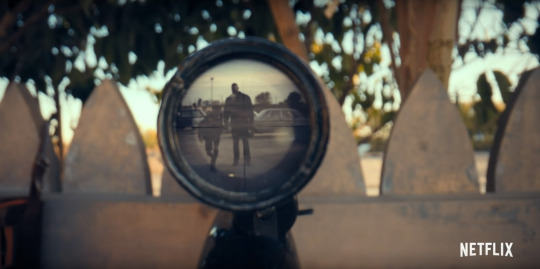
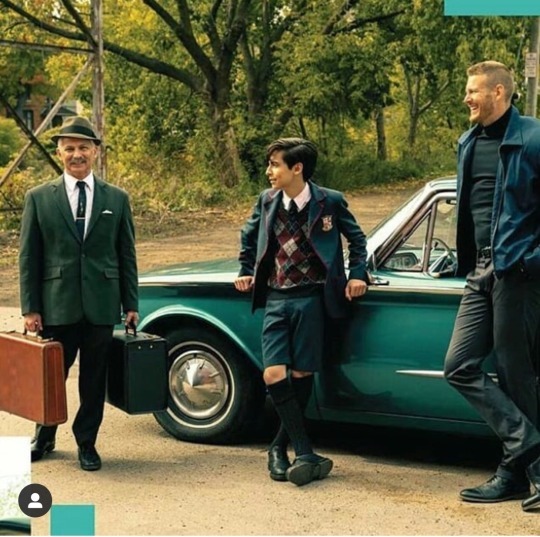
Old Five, young Five (who’s still really old Five), and Luther.
However this may not go to plan as the summary for ep9 says, “the Fives plot against each other.”
And the summary for episode 10 is: “reeling from the events at the Dealey Plaza, the siblings head to the farm to help save Harlan.”
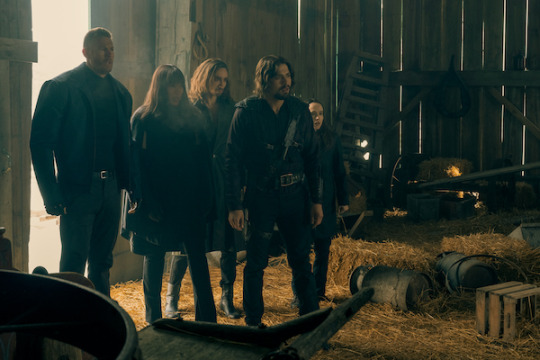
MOMENTS I CAN’T PLACE:
Someone flips over a table in what looks like it could be a distillery. Based on outfit and hair this could possibly be Lila, Klaus, or (less likely) Diego. Five is also there.

A similar (the same?) person flips over while avoiding gunfire. There are targets and what looks like training equipment, and the person shooting is standing under a large umbrella.

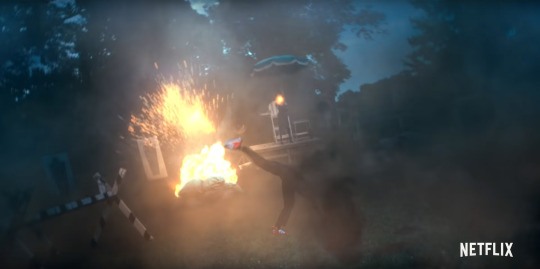
If the flipping person is Lila, then this may link to what the summaries reveal about her arc: In ep5 she confronts her mother, in ep6 the Handler is mentioned (albeit talking to Five), and in ep9 she learns the truth about her parents…
Five sneaks through a room with a camera and lights. On the blackboard the word “Pogo” is written, implying this could be Reggies house and this room is where he is teaching and studying young Pogo.
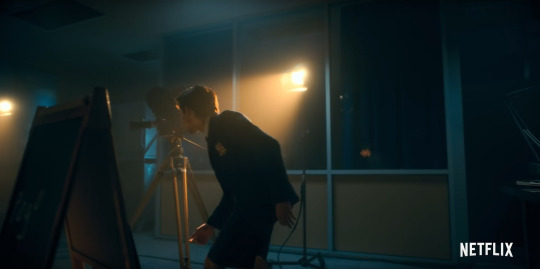
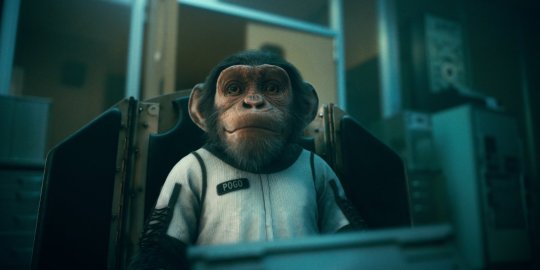
Diego walks into a control room. It looks like there might be 2-way glass. Could this link to ep8 when Diego discovers what cases the apocalypse?
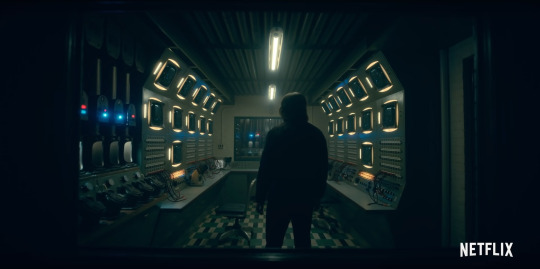
Five is seen in a building with wooden panels on the walls.


Based on the background of this shot of Carmichael, the building could be part of The Commission.
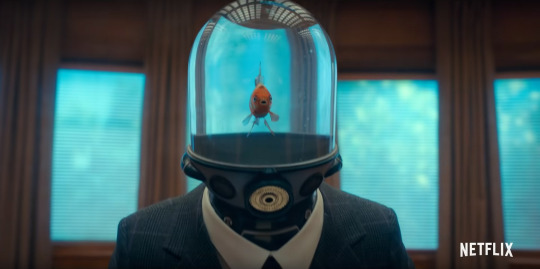
“You...”
Five gets buried in rubble. Aidan looks chill about it though.
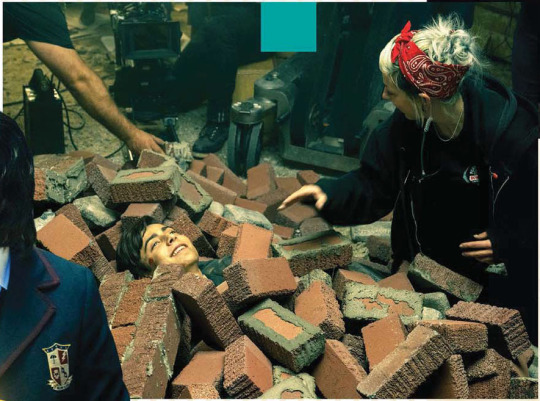
***********************************************************************
Well done for making it all the way!
I’ve tried to avoid speculation as much as possible and keep the language suggestive. I don’t know all the facts, I WILL have made errors, probably many! So please take all this with a suggestive grain of salt, I am just a hooman trying to use her squishy brain.
Please let me know if you spot any errors, think of anything else I can add, or if you want more info about any specific event ^‿^
#the umbrella academy#tua#tua s2#klaus hargreeves#five hargreeves#ben hargreeves#vanya hargreeves#diego hargreeves#allison hargreeves#luther hargreeves#reginald hargreeves#pogo
255 notes
·
View notes
Text
The Hargrove-Mayfield House
I’ve been working on drafting this floorplan for ages, but now that I’ve got quarantine amounts of free-time I’ve come back to it with extra focus and determination to get this thing right, so here you go!
reference photos with explanation will be below the cut, because there are some weird-ass bits to this house that I feel need explanation/clarification/general screaming, and that in some case are very variable depending on what canon you want to go with.
anyway! with the front of the house down there at the bottom, and keeping in mind this house is on a corner lot (streets on both sides that have exterior doors), here ya go!

(also just a heads-up that the exact proportions of everything was difficult to figure off based on a lot of these photos, and this house very much resisted attempts to be sketched out on graph paper, so while this is as close as I could get it without losing my mind, it’s definitely got some little issues here and there still.)
OK! so starting from the front, we’re all familiar with the view from the street, the long, thin porch along the front. but did y’all know the front of the house isn’t as flat as the porch makes it seem?

this is supported by the inside of the house, where we have Billy’s room in that pushed-out bit, and the front door visible through his door, leading into a living room in the pushed-back bit. (if any of that makes sense.) not the best screenshot but you can at least kind of see the corner behind Billy’s door and how it’s clearly not level with the front door

now, I’m not gonna spend much time on Billy’s room because @gothyringwald has already done the work of the gods with that one (IN THREE PARTS, MY HERO), except to briefly say yes, there is a fireplace in here, it’s the back-end of a slightly bigger one in the front room. also, not that it’s at all important cause I won’t be using s3 screencaps for his room, but his room was very clearly not filmed in the same house for s3. the view out Billy’s door changes from the front door to a hallway from s2 to s3 (and there are no hallways in this house, as you’ll see), and the view out his front-facing window changes from porch to bushes. it drove me crazy the whole time so I just had to throw that out there.
anyway, for now I want to turn your attention towards Max’s room while we’re still in here because...

first of all, yes there is a door straight into Max’s room from Billy’s, and no, I have not included it on my layout. That’s because in the show they use a bookcase on both sides of the door to hide it, so you could canonically say that there is no door. to be fair, though, they use this inset shelf thing that looks like in actual fact it wouldn’t work if both of them had one. so, use the door if it suits you, use the bookshelves if they suit you. canon is putty in your hands.
also I wanna point out that in the very bottom right corner of this shot you can see the corner of some wall trim. that’s the edge of Billy’s closet. and yes, it does stick out from the wall like that. at a guess I’d say about half of that wall is closet, and half of it is pushed back by exactly the closet’s depth, giving us this corner look.
moving on to the view into Max’s room, we can see the tiny closet space that her room has. it doesn’t appear much wider than the door to it is wide, though it is deeper than it appears from this angle, probably by about a foot. we can also see her door to the living room from here.
moving into Max’s room...
in season 2 you can feel the camera operators doing their damn best to show as little of this room as possible because it’s so weird and got so many doors, but in s3 we do get a little bit of a better feel and the screenshots I got from there do seem consistent enough with real-estate photos and s2 that I’m like 99% sure they shot Max’s bedroom scenes in the same house as in s2.
so, firstly we have a shot of that inset bookcase I mentioned hiding the door to Billy’s room, and Max’s lil closet to the right. it takes a stupid about of staring at the bottom right corner, but you can just barely see the shadow of what must be the closet’s outer corner there.

panning left, we can see Max’s windows, prime for sneaking out to do nerd shit. in the show they put a lil firewood storage thing directly under her windows for extra sneaking out potential, but I can only put so many pictures in here before tumblr makes me split this thing into two posts so I’ll refrain from adding a cap of that.

note also that that’s Billy’s window closer to us, and Susan & Neil’s at the back of the house. Billy’s would seem ideal for climbing out of as well, but some asshole put his sound system and vanity right under that window so idk how he’d manage it if he did. I’d love to see the elaborate shifting-stuff-around/gymnastics that goes into Billy’s regular sneaking out, though, if anybody wants to get on that.
ok, back into Max’s room cause we’re not done with it yet. we’ve accounted for a door that may or may not be between hers and Billy’s room, one to a lil closet space, and the one into the living room, but this girl has two more fuckin doors in her room.
unfortunately these two doors are never photographed together, so I didn’t figure out that there are two on this last wall until literally this morning while editing this post, but hopefully I can take you along my thought process on why it has to be two different doors.

essentially the thought process is, (L) no wall at all between darkened/blocked-off door and corner, (R) at least a foot of flat wall to the left of door. going back to all of my screencaps with this knowledge makes a whole lot of stuff make more sense, but again I can’t put everything here. If there’s demand for more detailed screencaps and stuff maybe I’ll make a part 2, but for now I’m trying to be as succinct as possible. (lol)
so anyway, that door on the right clearly goes into the third bedroom of the house, because why the hell not have all the bedrooms connected, and that one Susan’s standing in front of in the screencap, I believe, leads to a bathroom. (to be clear, there are two doors in that screencap. one on the left that leads to the living room as mentioned before, and the one I’m talking about, behind her, which set designers have understandably tried to disguise as a closet.)
this is purely process of elimination, since the real estate photo I have of the bathroom does not show the door, does not have any windows, and doesn’t even remotely resemble the bathroom used in s3, but the only other bathroom space I was able to find in this house was off the dining room, which is definitely not big enough to hold a bath or shower. I may throw out all the reference photos of bathrooms I have if anyone is desperately curious, but for now in my head it’s just a general haze of ~a bathroom exists here~
anyway, from that right door let’s walk on into Neil and Susan’s tiny-ass bedroom.

this room is so comically small I’m amazed Billy didn’t get saddled with it, honestly, but if you want some headcanons about why he might not have, my go-to is that Neil /or Susan realized this bedroom was the best for any teen with a mind for mischief. while the windows are definitely not as ideal for climbing out of as Max and Billy’s are, if we take that door on the left we’re in the pantry (yes, the pantry. stay with me), and it’s a straight trip from there out the side door, and out to your smokin’ hot Camaro.
idk how sound that logic is, but it’s what I’ve got lol
But anyway, now we’ve reached the end of the house on one side, so I’m gonna take us back to the front living room and work our way back from there. here we’ve a quick glance at the other end of that fireplace, and another angle of how the front door and Billy’s door relate to each other:

the two parts of the living room are separated by this wide arch, and that further bit is where we see Billy’s weights and weight bench in s2. one could say that this is just normally where he keeps it, but my own personal hc is that they’re only there in s2 because the family just moved in, and that they later get moved to his room and the basement, leaving the living room more usable.

It’s hard to be 100% sure, but looking at these photos, particularly at the floor, I believe the second living room area is narrower (as shown in the floorplan sketch). It makes Max’s room make a little more sense size- and shape-wise, and it seems like all the pictures I have of this space confirm it.
anyway, the open door on the right of the second living room bit leads back into Max’s room, and through another arch we can see into the kitchen, and beyond that the dining room.
for some reason the only shots of the kitchen are taken from the back of the house looking forward, so try not to get dizzy as we spin around here.
as you can see we’re now pointed towards the living room, and on our left (towards the bedrooms) we see the doors to that pantry I mentioned earlier. I don’t have any photos of the inside of the pantry, alas. those would solve probably every question I have about the ground floor of this house. if you look closely they look like bi-fold doors to me, but they could just open inward.

we can also definitely tell that the wall on the left side of that arch is much shallower(?) than it is on the living room side, if that makes sense. essentially, these rooms on the left side of the house are getting narrower as they go on.
until the dining room! this room narrows a little on the right side, which you can see from exterior shots, but the pantry/bathroom weirdness in the middle of the house has definitely cleared out of the way to make room for dining here. we’ve also got two big-ass windows (comparatively), since going by the direction of the wood floors, the window on the left is not the same window as the one on the right.

and going by the existence of a window in that bathroom, we know this part of the house has three external-facing walls -- or however a professional would say that. (essentially, Susan and Neil’s bedroom can’t be overlapping the other side of the bathroom.)
we’ve been pretty low on storage space here so far, so that + the fact that the door in the corner looks nothing like a door to the outside + the fact that there’s a door to the outside literally on the other side of the room, gives me the conviction that this door is just into closet space. it could be a door to the basement, but we’ve seen the back of the house before and it doesn’t look like there’s enough space there for a whole other room full of staircase. observe:
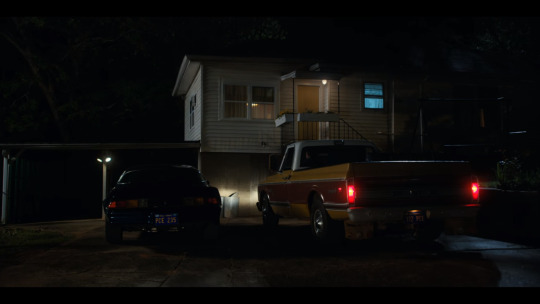
not to mention Neil’s headlights are illuminating a perfectly good door to the basement right there, although idk shit about houses with basements. do they usually have two ways down if they’re built like this? I wouldn’t know, I live on a fault-line. we don’t do that shit here.
ANYWAY, that’s the house. somehow I feel like I’ve covered like way too much, and also not nearly enough, so do let me know if anything isn’t clear and I’ll try to fix it/do an additional post and link that. cause even if most of us are writing Billy living outside of Old Cherry Road/Cherry Lane at this point, this kind of shit is always handy to have around, at least imo?
325 notes
·
View notes
Text
A Matter of Jurisdiction
A lovely anon asked if I had anything to add regarding one of my recent tags, the gist of which was “In DMC, do you realize how much trouble Governor Swann’s letter would have caused (for the EITC) if it made it to England? Because Beckett did and he was not taking any chances.”
Because I am terrible at being succinct and because I love talking about this, I’m going to expand more generally on what I said in my tags on the post in question and approach some other questions about Lord Beckett’s authority later posed by the op of the original post. [Links to the relevant posts can be found in the replies, as Tumblr hates links.]
I will, fairly, preface this by saying that skimming Beckett’s PotC fandom Wiki does answer all of the questions regarding the EITC’s actions, and, to put the TL;DR at the beginning, that answer is often just “Lord Beckett had royal authority (and enough money) to do whatever he wanted.”
Nonetheless, if you’re curious how I’d nerd out over analyze the situation, please read on!
[A further note: I am not a historian, nor am I an expert on the alternate universe in which PotC is set. If I am, at any point, wrong, please let me know.]
While the main focus of the original PotC trilogy is the conflict between pirates (representing freedom) and the British Crown (representing, among other things, constraint, control, and exploitation), there exists within the British “side” a kind of internal conflict and this is what we see at play between Cutler Beckett and Weatherby Swann.
If you understand Beckett to be a merchant of sorts and the East India Trading Company to be just what it says on the tin -- a trading company -- then it might seem entirely out of order that Beckett invades Port Royal, crashes the governor’s daughter’s wedding, and disrespects (indeed, arrests) Swann the way he does. However, so far as legality goes, Beckett doesn’t cross as many lines as one would think (or, perhaps, the lines are not quite so clear). This is because Lord Beckett has the same royal authority that Governor Swann does and because the EITC is no mere trading company.
The EITC is a deeply politically invested entity. The Company operates with a royal charter, which means that it was granted certain rights by the monarchy. Specifically, the EITC has extensive military and administrative capabilities built into it. (I’ve even seen it referred to as part trade organization, part nation state.) When operating in the Indian Ocean and other areas outside of the jurisdiction of the British Crown, as it was originally intended to, the Company acts as an arm of British imperial power. This becomes a problem when the EITC attempts to exert said power where British Crown authority is already established, such as in the British Caribbean.
Swann is, of course, the king’s governor of Port Royal; his authority derives directly from the Crown as well. In fact, Weatherby Swann is said to be close friends with the king. However, the fact that Swann has personal ties to the aristocracy and Beckett does not doesn’t make their powers as unequal as one might think. The structures that each is part of are just about parallel.
The situation is not: Crown → Aristocracy → Merchants
But rather: Crown → Aristocracy & → EITC
While Beckett has been granted the title of lord by DMC, there is still a difference between those born into such a status and those who were not. (It’s sort of a big deal, especially for Beckett. His family had been wealthy merchants, but none of them had ever held a title.)
Because the two men have fairly equal standing in terms of pure authority, their being at odds become a tricky matter of jurisdiction. In other words, who has the right to exercise his power where? This question vexes both Swann and Beckett, and they’re both keenly aware of it from the moment they come face to face. Neither can claim absolute authority outright, but both have unique cards they can play to shift the situation in their favor.
A few scenes in DMC highlight the chess game that Swann and Beckett are playing, though I’m afraid it was never a game that Beckett intended to play fairly.
In the opening of DMC, the EITC invades Port Royal as Beckett arrives to arrest Elizabeth Swann, William Turner, and James Norrington. Some key things to understand here:
The invasion is not solely to make the arrests, but rather to establish Port Royal as the EITC’s new base. Beckett clearly has that intention (and royal approval for it) before showing up. That said, was invading the place entirely necessary? No, but it is a shock tactic.
Some of the first things said to Lord Beckett are, by Governor Swann, “Lord or not, you have no reason and no authority to arrest this man.” and, by Elizabeth, “We are under the jurisdiction of the king’s governor of Port Royal and you will tell us what we are charged with.” The Swanns are obviously under the impression that Beckett is out of line, but he isn’t.
Regarding the arrests themselves, all of the warrants are legally valid. Elizabeth, Turner, and Norrington did, as the warrants say, conspire “to set free a man convicted of crimes against the Crown and Empire and condemned to death.” Beckett’s decision to use the prisoners rather than simply execute them is, on the other hand, entirely his own abuse of power.
Another important scene, of course, is when Governor Swann attempts to save Elizabeth by having her sent to England.
Swann’s lines in this scene very clearly show his particular type of power: that based on personal, aristocratic ties. For example, “Our name still has some standing with the king.” Even the captain he makes arrangements with is “a friend” -- the only kind of person Swann can trust given Beckett’s new authority in Port Royal.
When Swann tells Elizabeth, “Perhaps I can ensure a fair trial for Will.” we especially see where his power ends. His authority in Port Royal, and regarding those who are not his family, is now weak. His best hope there is to enforce existing standards (i.e. a fair trial).
The entire premise of Swann’s decision here is that he knows that he can’t contest the warrants. However, there is a possibility that he can leverage his ties with the aristocracy to get his daughter off the hook. That personal power is only certain to work in England, out of the reach of Lord Beckett’s power in the Caribbean. Swann is very smart to use his personal ties this way though anyone would have to admit that it’s not exactly legal.
A line that was cut from the film reinforces all of the above (which is likely why it was cut): “There are still men loyal to me here, and Beckett is still wary of my ties to the Crown.” Swann, due to his position as governor and personal connections with the British aristocracy, has power that -- while not necessarily a threat -- could conceivably challenge Beckett’s actions. Lord Beckett knows this, but there isn’t anything he can do about it at this point in the film.
Now, considering that (earlier) Swann openly discusses helping Elizabeth escape in front of one of the EITC soldiers when he visits her in prison, it’s no surprise that Beckett suspects something is amiss and sends Mercer to investigate.
The scene in which Mercer kills Swann’s hired captain and arrests the governor is, perhaps, the most high-stakes political moment in DMC. Mercer not only catches Swann breaking the law, but he intercepts Swann’s letter to the king. When confronted, Swann knows that his gamble has gone horribly wrong.
Swann is arrested on the same grounds that his daughter was, conspiring to free a convicted criminal, which effectively strips him of his authority and, worse, puts him at Beckett’s mercy. More than that, his letter to the king is Beckett’s first real proof that Swann is a threat on a larger playing field. Before intercepting the letter, Beckett only had suspicions to go off of, and any move against someone you’re not sure is an enemy could create an enemy. With the escape attempt and the letter, Beckett has both legal and personal grounds to arrest the governor and, later, blackmail him.
While we never discover the exact contents of the letter, it’s likely that Swann wrote more than a plea for his daughter’s pardon. Elizabeth is his main concern, but it would be unlike Swann -- a man with an admirable moral center -- to not mention the way he feels about the EITC and Beckett’s conduct in Port Royal. If such a letter did reach the king, there is no way that the king could ignore it outright. There would be repercussions of some kind, and a royal inquiry into the EITC’s dealings at the very least. It’s important to remember that, while the Crown pays little attention to the EITC so long as it’s making money, the Crown very much can tell the EITC what to do if it sees fit -- which is the last thing Beckett wants. That said, I’m not certain if Swann’s letter would have meaningfully shut down the EITC in the Caribbean, and it almost certainly wouldn’t have gotten Beckett arrested. In any case, Beckett avoids the whole problem by ensuring that Swann’s concerns -- whatever they are -- never reach ears that are able to do anything.
In the following scene, in which Elizabeth steals the letters of marque, it’s interesting to note that Beckett’s line about how “loyalty is no longer the currency of the realm” is both ironic and bold. The only reason it’s even remotely true is because Beckett makes it true. He is more than aware of the power that loyalty can have, and he goes out of his way to keep that power from being a threat. Loyalty is still very much a currency of the realm, but it isn’t of much use if there are no transactions being made (i.e. Swann’s letter never reaches the king).
A final scene in DMC that is worthy of note is that in which Lord Beckett blackmails Governor Swann.
The scene opens with Beckett saying, “There’s something to knowing the exact shape of the world and one’s place in it, don’t you agree?” This is, obviously, a thinly veiled threat -- a reminder to take note of one’s place in the current situation.
Beckett effectively threatens Elizabeth, who is currently a criminal among criminals and being hunted as such, and uses Swann’s concern for his daughter to force the governor to work for the EITC.
Even here, we explicitly see the jurisdiction matter playing out. When Swann asks what Beckett wants in exchange for Elizabeth’s safety, Beckett is more than clear: “Your authority as governor, your influence in London, and your loyalty to the East India Trading Company.” Beckett uses this opportunity to appropriate the governor’s power. While Beckett now technically has the highest authority in Port Royal, he nonetheless ensures that his only possible competitor is working for him, bolstering his power rather than being able to challenge it. Like we see in every case, Beckett will not kill someone that can be more useful to him alive.
We can also revisit the conflict between Beckett and Swann in the terms Beckett uses: currency versus loyalty. Again, the irony is immaculate. While Beckett’s every move is made on the premise that currency is more valuable than loyalty, he himself values loyalty enough to buy it -- the very thing he says Swann “hoped never to sell.”
If you’ve reached the end of this post, dear reader, I commend you. That said, there are a few caveats to consider. Namely, much of Beckett’s PotC Wiki seems to imply that he had the king’s support and, no conniving required, would have been able to exercise authority over Governor Swann. In that case, things like Swann’s letter are less important (beyond the matter of Elizabeth’s safety, of course). I’m assuming that much of what “actually” happened rests on the details of the EITC’s expansion into the Caribbean -- which Disney handwaved in the films for the most part and only later expanded on (somewhat) in things like the novelizations, which I have not yet read.
#potc#pirates of the caribbean#cutler beckett#weatherby swann#filodox!#filodox!wri#this got way too long#and I took too long to write it#but I don't often get asked about the socioeconomic underpinnings of potc so#<3
24 notes
·
View notes
Text
25 more movies (and one miniseries) you can watch on youtube
I posted 11 movies that are on youtube yesterday (Part 1) but since things are really starting to get shut down here’s more worthwhile movies and a miniseries you can watch for free on youtube right now
Leave Her To Heaven (1945): Gene Tierney is Ellen, a woman whose only crime is “loving too much,” and also all the other crimes she commits to make sure there are no competitors for husband Cornel Wilde’s affections in John M. Stahl’s incredibly lurid and entertaining technicolor melodrama.
M (1931): Fritz Lang’s masterpiece is the basis for every subsequent movie about hunting a serial killer and it’s still the best one.
The Naked Kiss (1964): Here’s the jacket copy from Criterion: “The setup is pure pulp: A former prostitute (a crackerjack Constance Towers) relocates to a buttoned-down suburb, determined to fit in with mainstream society. But in the strange, hallucinatory territory of writer-director-producer Samuel Fuller, perverse secrets simmer beneath the wholesome surface. Featuring radical visual touches, full-throttle performances, brilliant cinematography by Stanley Cortez, and one bizarrely beautiful musical number, The Naked Kiss is among Fuller’s greatest, boldest entertainments.”
Underworld USA (1961): Dave Kehr on the film: “Sam Fuller's harsh, obsessional 1960 crime drama is narrated in the style of a comic book gone berserk. Cliff Robertson is the neurotic hero, bent on avenging his father's death by infiltrating and destroying a crime syndicate that operates under the redolent name “National Projects.” Corruption is all-pervasive in this vision of America, and Fuller disturbingly suggests that only a madman can make a difference. One image from Underworld—of a heavy striking straight at the camera—prompted Jean-Luc Godard to describe Fuller's films as “cinema-fist.” There is no more apt phrase.”
Pickup on South Street (1953): Another Sam Fuller. Here’s Georgia Hubley of Yo La Tengo on the film: “Richard Widmark manages to portray himself as twisted, conniving, pathological, sleazy, tragic, vulnerable, and handsome all at once in most of the movies I’ve seen him in, and never more exquisitely than in this, one of my favorite film noirs.“
Journey to Italy (1954): Richard Brody on the film: “One of the most quietly revolutionary works in the history of cinema, Roberto Rossellini’s third feature starring Ingrid Bergman (his wife at the time), from 1953, turns romantic melodrama into intellectual adventure. [...] From Rossellini’s example, the young French New Wave critics learned to fuse studio style with documentary methods, and to make high-relief drama on a low budget.”
The Spook Who Sat By The Door (1973): A satirical thriller based on the Sam Greenlee novel about the CIA recruiting a token black agent who quickly realizes they have no intention of letting him advance to a meaningful position and decides to head back to Chicago to teach the black revolutionaries all the latest guerrilla warfare tactics. Despite playing to packed houses the film was quickly pulled from theaters with little explanation and remained out of circulation until a DVD was issued in 2004.
The Big Combo (1955): Dave Kehr’s capsule: “This 1955 film noir borders on total abstraction for most of its length and then achieves it in an astonishing final scene—a shoot-out in the fog that suggests an armed and dangerous Michelangelo Antonioni. Where the usual noir takes place in a nightmare world, this one seems to inhabit a dream: there's no longer fear in the images, but rather a distanced, idealized beauty. With Cornel Wilde, Jean Wallace, Brian Donlevy, and Richard Conte; the director is Joseph H. Lewis (Gun Crazy).”
The Stranger (1946): Orson Welles’s film concerns an FBI agent (Edward G. Robinson) tracking Nazi war criminals whose search takes him to a small Connecticut town where the local schoolteacher (Orson Welles) is not what he seems. It’s the most conventional Welles film, reportedly intended to prove he could turn in a movie on time and on budget, but it’s still plenty entertaining.
F For Fake (1973): Orson Welles documentary/essay/whatsit about forgers and frauds, specifically Elmyr de Hory, who became famous as an art forger because instead of forging existing paintings he painted new ones in the style of famous artists, and Clifford Irving, who wrote a best-selling book on Elmyr and then was busted for a fraud of his own, the fake Howard Hughes autobiography. A wildly enjoyable, incredibly edited, one of a kind mindbender.
Citizen Kane (1941): It’s Citizen Kane. You just have to put up with hardcoded Korean subs.
Detour (1945): Roger Ebert on the film: “Detour is a movie so filled with imperfections that it would not earn the director a passing grade in film school. This movie from Hollywood's poverty row, shot in six days, filled with technical errors and ham-handed narrative, starring a man who can only pout and a woman who can only sneer, should have faded from sight soon after it was released in 1945. And yet it lives on, haunting and creepy, an embodiment of the guilty soul of film noir. No one who has seen it has easily forgotten it.”
A Woman Under The Influence (1974): Dave Kehr: “John Cassavetes's 1974 masterpiece, and one of the best films of its decade. Cassavetes stretches the limits of his narrative—it's the story of a married couple, with the wife hedging into madness—to the point where it obliterates the narrator: it's one of those extremely rare movies that seem found rather than made, in which the internal dynamics of the drama are completely allowed to dictate the shape and structure of the film. The lurching, probing camera finds the same fascination in moments of high drama and utter triviality alike—and all of those moments are suspended painfully, endlessly. Still, Cassavetes makes the viewer's frustration work as part of the film's expressiveness; it has an emotional rhythm unlike anything else I've ever seen.”
Opening Night (1977): Another Cassavetes masterpiece, again starring the great Gena Rowlands, with Gena as an actress mentally disintegrating as she tries to prepare for an upcoming play. Easier to start with this one than A Woman Under The Influence. Richard Brody on the film: “Though there isn’t a movie camera anywhere to be seen—and Cassavetes, with his tightly sculpted, uninhibitedly intimate images, is a master of the camera—Opening Night captures with astonishment and boundless admiration the uninhibited ferocity of the art that brings life onto the screen. (In fact, Cassavetes had originally planned to take the role of the play’s director.) It’s one of the greatest tributes ever paid by a director to an actress.“
Magnificent Obsession (1954): It’s not necessarily Douglas Sirk’s best technicolor melodrama but this adaptation of Lloyd C. Douglas’s ridiculous bestseller is the most melodramatic one. From Cine-File: “Produced in the wake of Henry Koster's CinemaScope adaptation of Douglas' THE ROBE, Sirk's 1954 remake of MAGNIFICENT OBSESSION is, by any standard, an absolutely batshit movie. (It's the kind of film where a lecture about the radical power of kindness compares the crucifixion of Christ to the act of turning on a light bulb.) It's not so much an adaptation of Douglas as a third-hand amplification of his aura. "Ross Hunter gave me the book," Sirk recalled, "and I tried to read it, but I just couldn't. It is the most confused book you can imagine.” As Geoffrey O'Brien asserts in his essay for the film's Criterion release, Sirk earnestly examines that which he admits to finding absurd, forcing such questions as, "What if this weren't crazy? What if it were real? What sort of a world would that be, and how different would it be from the one we inhabit?" Therein lies the genius of Sirk's glorious melodrama, one certainly worth seeing in all its Technicolor magnificence.
All That Heaven Allows (1955): Geoff Andrew on the film: “On the surface a glossy tearjerker about the problems besetting a love affair between an attractive middle class widow and her younger, 'bohemian' gardener, Sirk's film is in fact a scathing attack on all those facets of the American Dream widely held dear. Wealth produces snobbery and intolerance; family togetherness creates xenophobia and the cult of the dead; cosy kindness can be stultifyingly patronising; and materialism results in alienation from natural feelings. Beneath the stunningly lovely visuals - all expressionist colours, reflections, and frames-within-frames, used to produce a precise symbolism - lies a kernel of terrifying despair created by lives dedicated to respectability and security, given its most harrowing expression when Wyman, having given up her affair with Hudson in order to protect her children from gossip, is presented with a television set as a replacement companion. Hardly surprising that Fassbinder chose to remake the film as Fear Eats the Soul.“
Written on the Wind (1956): Dave Kehr: “One of the most remarkable and unaccountable films ever made in Hollywood, Douglas Sirk's 1957 masterpiece turns a lurid, melodramatic script into a screaming Brechtian essay on the shared impotence of American family and business life. Sirk's highly imaginative use of color—to accent, undermine, and sometimes even nullify the drama—remains years ahead of contemporary technique. The degree of stylization is high and impeccable: one is made to understand the characters as icons as well as psychologically complex creations.“
His Girl Friday (1940): Geoff Andrew’s capsule: “Charles Lederer’s frantic script needs to be heard at least a dozen times for all the gags to be caught; Russell’s Hildy more than equals Burns in cunning and speed; and Hawks transcends the piece’s stage origins effortlessly, framing with brilliance, conducting numerous conversations simultaneously, and even allowing the film’s political and emotional thrust to remain upfront alongside the laughs. Quite simply a masterpiece.“
Bringing Up Baby (1938): Ignatiy Vishnevetsky on the film: “Possessed by an overwhelming sense of comic energy, Howard Hawks’ screwball masterpiece heaps on misunderstandings, misadventures, perfectly timed jokes, and patter to the point that it’s easy to overlook how rich and fluid it is a piece of filmmaking, effortlessly transitioning from one thing into the next.”
Underworld (1927): Dave Kehr: “The first full-fledged gangster movie and still an effective mood piece, this 1927 milestone was directed by the master of delirious melodrama, Josef von Sternberg. George Bancroft is the hard-boiled hero, granted tragic status in his final sacrifice. Ben Hecht wrote the script, and many of the same ideas turn up, in a very different moral context, in his screenplay for Howard Hawks's 1932 masterpiece, Scarface.“
Q - The Winged Serpent (1982): In Larry Cohen’s cheapo classic, Quetzelcoatl terrorizes New York. Michael Moriarty plays a bumbling, unlucky small time crook (the robbery he participates in goes hilariously wrong; losing the keys to the getaway car is just the start) who accidentally discovers the monster’s nest and realizes he’s stumbled into the opportunity of a lifetime. He’s willing to help the authorities, including cops played by David Carradine and Richard Roundtree, but they’re gonna have to pay for it. Very goofy and very fun.
Stalag 17 (1953): Billy Wilder’s classic mixes POW drama with comedy as a group of prisoners in a German POW camp try to figure out who in their barracks is a rat while they plan their escape.
Hellzapoppin (1941): Ignatiy Vishnevetsky: “The opening reel may be the most manic stretch of go-for-broke gonzo comedy to come out of studio-era Hollywood, with the zoot-suited duo of Olsen and Johnson introduced tumbling out of a New York taxi into the bowels of hell (“That’s the first taxi driver that ever went straight where I told him to!”) in the midst of a musical number about how “Anything can happen / And it probably will.” Dozens of throwaway gags—including the first Citizen Kane reference in film history—and an argument with the projectionist (once and future Stooge Shemp Howard) follow, before the movie snaps into something vaguely resembling sanity. From there, Hellzapoppin’ finds Olsen and Johnson wandering in and out of a musical comedy that’s seems to be on the verge of falling apart and tussling with such comedy ringers as Martha Raye and Mischa Auer, the latter cast as a real Russian nobleman who’s trying to pass as a fake Russian nobleman. It’s like a Marx Brothers movie playing at triple speed; it eludes easy summary—it’s a real “you have to see it to believe it” kind of movie—and often stretches the limits of the Production Code. True to its absurdist sensibility, Hellzapoppin’ ended up getting nominated for an Oscar by mistake, for a song that doesn’t appear in the movie.”
Outrage (1950): Directed and cowritten by Ida Lupino, this was one of the first Hollywood movies after the implementation of the production code to deal with rape and one of the first to tackle its psychological aftermath (the censor office actually made them take the word “rape” out of the script so it’s never uttered in the film). Richard Broday on the film: “Outrage is a special artistic achievement. Lupino approaches the subject of rape with a wide view of the societal tributaries that it involves. She integrates an inward, deeply compassionate depiction of a woman who is the victim of rape with an incisive view of the many societal failures that contribute to the crime, including legal failure to face the prevalence of rape, and the over-all prudishness and sexual censoriousness that make the crime unspeakable in the literal sense and end up shaming the victim. Above all, she reveals a profound understanding of the widespread and unquestioned male aggression that women face in ordinary and ostensibly non-violent and consensual courtship.“
The Hitch-Hiker (1953): Another Ida Lupino joint, this one a lean and mean film noir. J. Hoberman on the film: “The “Hitch-Hiker” script, written (uncredited) by the socially conscious journalist Daniel Mainwaring, was inspired by an actual case: Two buddies (Frank Lovejoy and Edmond O’Brien) pick up a murderous psychopath (William Talman) who forces them to drive him to Mexico. It’s a brutal story handled by Ms. Lupino, one of Hollywood’s very few female directors, with the same steely determination and emotional sensitivity found in her strongest performances.”
And the miniseries:
The Singing Detective (1986): Here’s the entry from the BBC’s list of the top 100 British television programs, where it placed number 20: “For many Potter's masterpiece, this extended six-part filmed drama series mixes flashback and fantasy to create a psychological profile of a writer of detective fiction hospitalised by a crippling skin disease. Though not, the writer stressed, autobiographical, the drama features many elements from both Potter's own life (the disease, the childhood setting) and his body of work (particularly the use of popular music from the war years). As usual with Potter, it also caused controversy at the time for the frankness of its sex scenes, though its position as one of the most challenging and inventive of all TV dramas is secure.“
181 notes
·
View notes
Text
Tomorrow Should Have Died
So i was planning on reviewing The Tomorrow War because it’s a new film and i like new films i can watch without having to brave the plague. I saw a preview for this thing a while back and had real low expectations for it, figured it’d be dumb fun like Independence Day. Imagine my abject horror when it turned out to be so much worse. Okay, first things first, the good stuff. Chris Pratt is good and so is J.K. Simmons. Betty Gilpin and Yvonne Strahovski work miracles with what little they have. The sound design is exceptional, probably the best thing about this sh*t flick, and the actual effects are on point. The problem with the movie is the script. It’s f*cking terrible. Oh my god, so much dumb! Here’s a list of sh*t that made me irrationally angry, in order of plot progression.
Eleven minutes in and i hate it. How are you losing a war to anything if you have mastered the ability to traverse space-time? How the f*ck is your technology so advanced, that you have found a way to exceed the light speed limit and literally break physics, but lose to a bunch of rabid, interstellar, komodo dragons? This is the dumbest f*cking contradiction I have seen all year and i am offended that whoever decided to make this film, is asking this of their audience. Sh*t is patently absurd. These f*cking things don't even have written language, man, and you really expect me to believe they have pushed a human race that has harnessed the power of time, to the brink of extinction?
Eleven minutes, bro. Eleven f*cking minutes.
Seriously, you can create a time machine, you should conceivably have the ability to harness gravity or one of the other fundamental interactions. Why the f*ck haven't you designed a miniaturized rail gun that uses modern tech or materials to build? You have worked out the science in the future, go back to the past and build miniature or handheld doomsday devices for use in the field. Why isn’t everyone running around with f*cking Megatron fusion cannons on their arms? Why the f*ck am i fighting aliens with ARs and Glocks?? The fact that there is an active time machine built from tech on hand from thirty years into the future, means cats could have spent their time building actual weapons to kill these f*cking things instead of betting the literal human race on a time displaced draft. This movie is dumb as rocks.
The way they describe how their time travel works is dumb. I mean, it isn’t, but i can guarantee this sh*t is going to be a problem later. I can feel it in my bones. They are definitely going to contradict this sh*t because multiverse theory is the only way to make movie time travel work and they are trying their damnedest to not do that.
This f*cking thing is over two hours long and the first drags. I hate when cats attempt to develop characters and they just fail at it. I'm sitting here trying to figure out why I should care about any of these people and i still don't have an answer after half the goddamn movie is over. Like, why should i care about Chris Pratt? He’s the main character and the writing has done nothing to endear him to the audience in a whole ass hour.
Also, the reason he’s so mad at his dad is stupid. Dude did right by his kid by bailing because he would have been a terrible father. Pratt’s character would have known that as a father himself. He didn’t have to like it and, of course there’s animosity there, but you’re an adult. Your dad knew he was lousy. He did you a favor by walking out. It wasn’t like he didn’t help support you or make sure you went without. As far as i can tell, dude was there in every way by physically. Because he couldn’t. Because he was f*cking shell-shocked from fighting in Vietnam. Where they raped innocent women and set babies on fire. Holy sh*t, this cat is an unlikable protagonist after this one scene. Which brings me to my next thing...
Pratt f*cking abandons his family?? Word? After that entire scene with his dad and the very obvious trauma he has suffered, he turns around and abandons his own kid because he lost his job?? Word? Like, for real? You expect me to believe that the Chris Pratt who cussed out his pops, was willing to go on the run from his future conscription, abandoned his own family because he lost a teaching job?? What the f*ck, movie? Do you want me to like this asshole or not? More than that, how the f*ck you mess up your character so bad in what i imagine is just five pages of actual script? Nothing we know about this character would ever even hint at him doing this to his family, to his daughter, so why the f*ck would he? Why the f*ck would you, as a write, believe we, as the audience, would just accept that sh*t as a forgone conclusion?
You got ropes on a Queen and you don't kill it? How the f*ck you make it that deep into the hive to even do-si-do the b*tch to the surface? We just watched these things tear through Miami to the point that they needed a whole ass bombardment just to survive and you not only go into their hive, their home, with no heavy ammo, but you somehow lasso a queen and drag her to the surface. Alive. If you can do all of that why not just drop a nuke down there and blow them the f*ck up? Why do you need a live Queen for your science? Shoot the b*tch, take the juice of her corpse, and end this sh*t! Why is all of this stupid recklessness necessary??
Okay. Okay... F*ck everything i just said, right? Why the f*k did you bring this Queen b*tch back to your base? You don’t have a different offsite lab to do this sh*t? You gotta bring her to your stronghold? Isn’t this a military operation? Why aren't their security protocols and sh*t in place to stop this stupidity? You don’t bring the enemy home. You take them to black sites for sh*t like this, not to the goddamn Pentagon!
All of a sudden, the aliens understand science? We spent this entire movie establishing that they are mindless beasts with teeth, eating the human race into extinction but now, because the plot demands it, the Queen one understands what the people are doing? That the green sh*t they made is plague that can murder them all? How the f*ck she even know what science is? They don’t even have language, dude! How the hell she know they made a death plague for her people?! F*ck it, whatever, bro. Next you're going to tell me she let them capture her just to get inside the lab or some sh*t because these rabid f*cking animals, who have demonstrated no military command abilities or even the barest of higher cognitive functions, are tactical geniuses.
Okay, so the Queen b*tch is a tactical genius. So, in the initial future drop, the team was murdered by a bunch of these things because they were sent to a lab where they were trying to make the death plague. Now, hat i am about to say is all assumption on my part because none of this, and i men NONE of it, is ever confirmed by the movie. So, they get to the lab and everyone is dead but the green per-plague is still there. That mean they had a Queen there. It’s established after this that Queens can call for backup and the Males will lemming their way to her. I deduce that’s how this lab got overrun; Queen got loose, called for her boys, and they ate everyone. That happened. That was the first thing we see in the future. This b*tch does the same f*cking thing on the home base lab so now the males are overrunning The Pentagon. You motherf*ckers knew this was a thing because it literally already happens. Why the f*ck would you do it again? AND it gets worse...
Home base, The Pentagon, is the f*cking rig where they house the goddamn time machine! You brought a hostile enemy leader, still alive and coherent, to the heart of your resistance operation, to the core of your time travel operation, knowing that at any time this b*tch can scream and have your whole ass base overrun with teeth and poison darts? Look, if the future is this stupid, they deserve to die, okay?
At least they commit to multiverse theory, even if it contradicts the entirety of their already established time travel rules.
Okay. Okay... So they create this toxin to kill all the monster things and send it back in time to be mass produced Put that sh*t in bullets and send it back to the future or whatever. But, because of the aforementioned stupid, that plan is bunk. Time machine go kablooey. And now we are at the "all is lost" moment at the end of the second act." Solution to the problem in hand, no way to save the future because the only way back to the future was a casualty of idiocy. Right. So... just wait. F*cking just wait. You know when these assholes show up, you know how to kill them all, you even have a plague ready to be mass produced right now. You have thirty f*cking years to refine that formula, to make it cheaper to mass produced and develop variants just in case immunities start to crop up or something. There are people from the future, stuck in the past, because of the egregious future error. They have all of that intel and they are just alive. The second this dude got back to the past with that antidote, the future was saved. The war is over. Like, even if you don’t know where the ship is, you have a sure thing that will murder these white f*cks and three decades to produce, weaponize, and store that sh*t. The war is won. The Prime timeline is absolutely safe at this point. Because that's how time travel works. You have the nuclear option, right now, to averting the end of the human race, ready to be mass produced. Yo have the knowledge from the future on where these things will first appear. You still have all the future tech brought over from the beta timeline ripe for reverse engineering in order to improve the weapons of the present. There is no scenarios where we lose this war, the second Chris Pratt plops back into the present with that plague. None.
Why is everyone so dejected?? Why are there f*cking riots all over the world?? None of this makes sense. How can you assume the world ends and the war is lost just because the communication with that version of the past is cut? Wouldn’t you expect that sh*t? You just altered the entire timeline by sending Pratt back with the antidote. That future is effectively gone. How can you communicate with a place in space-time that doesn’t exist anymore? Hell, even if it’s because the time machine broke and everyone over there is dead, you have the f*cking antidote now! Multiverse theory, bud. The fact that those time displaced assholes didn’t disappear, means multiverse theory is real and you have the opportunity to Future Trunks this sh*t so why panic? Why are there no leaders n television assuring their people that this is a thing? Why are there no scientists publishing papers about how sh*t is going to be fine? Bro, I'm just so tired...
How these cats just fly into Russia on a big ass cargo plane and not get shot down? This is 2022. Putin still hates us. This sh*t would cause a World War.
So you find this ship and you don’t tell anyone where it is? You decide to just kill them all yourself? Motherf*cker, what happens if you die? Did you back up the enzyme formula somewhere or did you bring all of it with you on this stupid f*cking mission? Did you leave notes or even text your location to anyone in authority, just in case haphazard attempt goes sideways so someone else can make a more organized attempt? Or just drop a nuke on the site from orbit? If one asshole denied you funding for your mission, why didn’t you ask someone else? Why didn’t you ask f*cking Putin? Because governments are bloated down with bureaucracy? My dude, people from the future came back and interrupted the world cup to tell you that aliens are going to exterminate the human race in three decades. If you tell anyone in a position of power that you know where these little sh*ts are, they’re going to listen. Especially since everyone decided to riot because the future changed/we lost the time war/ the timeline imploded.
Why would a terrestrial saw work on an intergalactic star ship? That doesn't make any sense. This f*cking thing survived a crash landing into earth intact and a goddamn circular saw cuts it open? Fine, whatever. On to the next stupid thing.
Bro. Bro, they just blow the f*cking thing up. Motherf*cker spent the entire movie, time jumping form the past to to the future and back to the past, just to get this plague to kill them all, and a bunch of C4 just blows them all up while they sleep. Why the f*ck was everything even f*cking necessary? At this point, when the dude comes back with that claw the first time, the future is saved. Analysis on that one claw gave up the location of the hidden spaceship where these things had been in stasis for millennia. Which was blown up with C4. No plague needed. No goddamn time draft needed. No casualties needed after that first wave. The second that dude brought back that claw, it should have been under a forensic microscope so actual f*cking scientists could figure out what a high school kid id in a matter of minutes. I hate this movie so goddamn much.
I hated this goddamn movie so much. It’s f*cking boring and the dumbest thing I've seen all year and i watched Army of the Dead. It’s pretty and the performances are decent, but there is absolutely no substance to any of this sh*t. It wants to be Independence Day and Edge of Tomorrow and The Great Wall. all in one, while infusing time travel family drama but it’s so f*cking confused trying to juggle all of that, it drops the ball on the most important part; The script. This thing must read like a fever dream induced by peyote because, in execution, it’s a wet fart. This f*cking thing is all over the place with no regard for any insular universe logic. It contradicts itself from one scene to the next and it’s goddamn offensive. I’m sure there is someone saying that i am overthinking this sh*t and that it’s just supposed to be dumb popcorn fun. I get that. However, i can’t just turn my f*cking brain off and mindlessly drool over sh*t that insults my intelligence the way this movie does. It’s dumb as f*cking rocks, man, and i want those two hours of my life back!

5 notes
·
View notes
Photo

RIP Blue Sky Studios...
Established in February 1987... Iconic commercials, early innovation in CGI, packed to the brim with top talent, a rare East Coast-based house, and one of the first studios in a post-Don Bluth age to really challenge Disney and Pixar in the feature animation field...
Gone.
Once a subsidiary of 20th Century Fox, The Walt Disney Company had them since early 2019 after the acquisition of their parent company. It looked as if Disney was going to keep them around, despite already having two powerhouse animation studios making family features for them. I wondered back in the day if Disney could rebrand Blue Sky as a sort-of outre little studio that did more experimental, quirky fare as opposed to the more digestible works of Disney Animation and Pixar.
Even before the COVID-19 pandemic hit, signs were rather troubling. Despite a management change, you had the rather ho-hum marketing for SPIES IN DISGUISE. To me, Disney sort-of let that one disappear between FROZEN II and STAR WARS: THE RISE OF SKYWALKER. I found SPIES IN DISGUISE to be a fun little movie, with a timely pacifist message and memorable gags. Sadly, it did not make its money back. Even more troubling was the constant delaying of NIMONA, an adaptation of Noelle Stevenson’s webcomic of the same name from FEAST and PEARL director Patrick Osborne. From the rumblings I’ve heard, it looked to be an innovative CG film and a next-level family film in general. Like a next SPIDER-VERSE. It was to be released January 14, 2022. 70% of the film was completed by this point... It is no longer a reality, Blue Sky is done...
450+ animators and staffers out of a job during an awful worldwide crisis...
Why couldn’t The Walt Disney Company just sell off Blue Sky Studios to a distributor looking for more animation to stock up on? If they didn’t need more than two animation studios (see the shuttering of their own Disneytoon Studios in early 2018), why shutter them and wait so long to do so? I know that absorbing competition and killing it is nothing new, but this is **expletive** for a multitude of reasons. Multiple talent out of a job, more movies and work squashed, a nearly-completed film likely dead. (It would be great if it was instead on the market, so that someone could snatch it up and complete it, but we shall see...)
Blue Sky Studios were no slouches. ICE AGE established them, big time. In fact, I’d say they helped show the industry that the features world wasn’t just Disney’s game anymore. Disney had seen rivals in feature animation in the past, notably Don Bluth and Ralph Bakshi, but they continued through the decades while Bluth and Bakshi’s feature opportunities waned. Blue Sky, alongside DreamWorks and a fledgling Sony Pictures Animation, changed that, and they were here to stay. And it’s quite sad that Disney had to acquire this notable studio and shut them down, they would’ve thrived elsewhere because of the success of their previous work and the amount of talent they have/had over the years.
They have a pretty distinct body of work, too. ROBOTS, HORTON HEARS A WHO!, RIO, EPIC, THE PEANUTS MOVIE, FERDINAND, SPIES IN DISGUISE. Some of them, I’d argue, were quite innovative. ICE AGE stabbed at cartoony, Looney Tunes-esque humor and visual design. The work in that movie rung more Warner Bros. than it did Disney or something more naturalistic in design. Their later work embraced that kind of outlook as well, but you started seeing other studios doing this as well: DreamWorks with MADAGASCAR, Sony Animation with OPEN SEASON and CLOUDY WITH A CHANCE OF MEATBALLS, and so on. The antithesis to the ever-more-realistic Pixar styles. Then Blue Sky just straight up redefined the computer animated feature with THE PEANUTS MOVIE, which not only kept the comic strip aesthetic of Charles Schulz’s iconic characters and world, but adapted them to a computer animated world while doing something new in the process. PEANUTS MOVIE, along with similar pictures like THE BOOK OF LIFE and CAPTAIN UNDERPANTS, are indeed stepping stones to SPIDER-MAN: INTO THE SPIDER-VERSE and what lies beyond that feature. In short, Blue Sky played a big part in computer animation showing that it didn’t just have to look like Pixar movies, or most other computer animated works that were out at the time of ICE AGE’s early 2002 release.
Who knows where that could’ve all gone. NIMONA looked to be something new and exciting, something to really push things forward and widen the computer animation canvas. A musical called FOSTER also sounded like it had potential. When TWDC acquired 20th Century Fox (now 20th Century Studios), Fox Animation in general had several animated films in development, hoping to branch out beyond their one studio... All of that seemingly died after the Disney acquisition, with only Blue Sky and a couple of Fox primetime TV-showed based movies (i.e. THE BOB’S BURGERS MOVIE, another - and inevitable - SIMPSONS picture) left. Now Blue Sky is gone. More animation, gutted. And for what? Disney didn’t have to do this...
It’s even more egregious when you consider where Disney was in 1991... As opposed to now, 2021...
Think of this... Under the controversial Michael Eisner, The Walt Disney Company was willing to sink a massive amount of money into a project that had already been cancelled. Said project was given to blockbuster king Steven Spielberg, hit director Robert Zemeckis, and animation mastermind Richard Williams. This was not even a few years after Disney was a quiet establishment being circled by corporate raiders that could’ve ended them for good... And what came of it. WHO FRAMED ROGER RABBIT. An innovative animation-live action hybrid movie for a more adult audience. One of the biggest films of 1988, a bonafide blockbuster that Disney hadn’t seen in years, and more than lit the fuse of animation’s 2nd Golden Age.
Then, in 1990, a former animator of theirs turned big-time director realizes that a short story he wrote while at the company was still owned by them. That man was Tim Burton, and he expressed interest in revisiting that poem. A studio was set up, with similarly outre director and former Disney animator Henry Selick taking the helm. The result was an innovative stop-motion film that leaned more towards horror and German expressionism than something like BEAUTY AND THE BEAST did. The result was THE NIGHTMARE BEFORE CHRISTMAS in 1993. A respectable hit then, an iconic classic today. Without NIGHTMARE, would have ever gotten future stop-motion efforts like CHICKEN RUN and everything Laika has made?
Finally, in 1991, Disney makes a three-picture deal with a small computer graphics studio based out of Marin County. One of their main guys was a former Disney animator as well, similarly outed for being too ambitious. Their plan? Make the world’s first all computer-animated movie. That studio was Pixar, their first movie was TOY STORY. Need I say more?
The Disney of today would’ve never in these three instances. Blue Sky could’ve been their chance to really make some kind of a splash in a post-SPIDER-VERSE world. Various shorts made at Disney Animation (including Osborne’s own FEAST) suggested this, and some Pixar shorts as well... But nothing really came of this. In terms of features being put out by Disney Animation and Pixar, only parts of MOANA, INSIDE OUT, and SOUL put this kind of thing in a long-form format. Blue Sky, who operated on smaller budgets, could’ve been their arm for more experimental feature animation. I say this because while Disney doesn’t need to hog up animation, Blue Sky was owned by them, and I felt the best way to go about this was to re-establish them as a more experimental studio. Make the most of it, you know? But no, they had to shut it all down.
When a studio shuts down, I feel a chunk of the animation world is just broken right off... While some of the artists are apparently being welcomed into various Disney houses, it sucks to see a studio with its own identity and output gone. Of course, my hope is that everyone employed there will have somewhere to go by April (when the studio shuts down completely) and that maybe, just maybe a new studio could be formed up from the remains. (Think Don Bluth setting up shop upon his departure from Disney in 1979.) Somebody has to get their happy ending, right? I know it’s moot asking for such a thing in this hellscape business of massive octopus conglomerates engulfing everything into their eight tentacles, but...
I wish everyone involved well, and that they’ll prosper afterwards. I certainly hope the 3/4 completed NIMONA doesn’t remain unfinished. (Netflix? Someone?) I hope to see some good come out of this...
11 notes
·
View notes
Text
9 years later and we have at last got a new Eva film and the end of the Rebuild project.
Much was made at the start of Rebuild of the desire to introduce Eva to a new audience. 1.0 more or less leant into its original goal and restaged episodes 1 to 6 of the TV series with a bigger budget, CGI, some more blunt and early reveals and a few weird alterations for the existing fan base. The Angel numbering was off; everyone knows Lilith is stuck in the basement, Seele just default to their monoliths. Kaworu is actively introduced at the tail-end rather than alluded to in the opening titles.
As an intro, its fine (though most would agree the equivalent stage of the TV series isn’t really a struggle to cope with either), though a few stylistic and environmental changes lead many to conclude this was a direct sequel to End of Evangelion.
2.0 seemed content to build off of the intro but steer away from the relevant section of episodes – roughly 8 to 17. Recognisable moments like the falling Angel, the corrupted Unit 03 and the ribbon angel and Unit 01’s impossible reactivation share the screen with altered relationship dynamics. Now we get Mari one of the few wholly new characters who gets to open the second film in a wildly dramatic fashion.
The key of Nebuchadnezzar (which does at least re-enter proceedings in the final film, but I am even shakier on what it is or used for – even fandom seem to have struggle to explain this as anything other than a blunt drop-in replacement for the Adam embryo in the TV series). And come the end its time for Third Impact already, Shinji altering the world around him to rescue Rei from the depths of an Angel. Kaworu uses an unfamiliar spear to incapacitate Shinji and the preview hints at a story further from the rails than ever.
3.0 is as promised more or less completely divorced from anything Eva had done before. Just not the off-the rails version 2.0 advertised.
Some will be quick to note that none of the Rebuild previews have entirely accurately advertised their subsequent instalment; 1.0’s features at least one key scene that never happened (Mistao slapping Ristuko in a seeming allusion to the Sea of Dirac Angel) while even the sequences of animation that did make it look nothing alike. Which is fair, but even then 2.0’s bears absolutely no resemblance to 3.0 and even 3.0’s very strange preview doesn’t really jibe with 3.0+1.0 ultimately.
3.0 is post-post-apocalypse and with a whole 14 years just evaporated between films. There’s a distinct last third of Nadia feel to it. About the only part similar to a former incarnation is Kaworu and Shinji’s relationship which while not even roughly mapping to episode 24 serves the same function; to make Shinji distraught before the climax of this story.
But 3.0 is also the point where that initial premise of the series slams headlong into the drift from familiar territory. Where the film is a quantum leap away from the mystery terms and slow reveals. The oddities and confusions pile up given the glimpsed state of the world, the strange gridded moon, the sea of Eva corpses, the strange state of Lilith in the depths of Nerv.
An awful lot happened while Shinji was (for reasons no one has explained or seems to care about except me) IN SPACE and the film only ever alludes to the sequence of events occurring between these two films in the broadest of strokes. Which if done a certain way can be compelling though I did not find it to be the case here in the slightest. It’s a huge struggle to build up even a vague idea of what went down and that’s with heavy deferral back to the TV series again.
If you’re new, none of this means much of anything.
Even mixed media doesn’t help. The reveal there was a limited run manga of events prior to 3.0 had a potential for answers, but upon reading a synopsis... Nope. Helps not even a tiny amount. Also this mixed media attitude is never to be encouraged.
So, I didn’t like film 3 much at all. Film 4 does little to not be based on where it left off. Which is a small mercy that it doesn’t effectively toss everything out again and skip further ahead in time. And 3.0+1.0 does at least make use of some of what 2.0 revealed and setup in the spirit of trying to get this into something cohesive. It fails, but it tried. Maybe the points it touches on were the intended direction of the films. Maybe Anno changed his mind on this one.
It’s not like Rebuild’s failure to cohere should be a surprise – the title of the film is simply confusing in sequence. Titled neither 4.0 nor 4.44, instead we have the pretty inexplicable 3.0+1.0 which is just annoying to type. Even thematically this doesn’t feel right given its more like 2.0 mushed into 3.0 but I suppose that’s technically film 5 so... Unless, 1.0 here is supposed to mean the original TV series or EoE, which... End of Evangelion figures unexpectedly largely in the film.
Could be that its meant to infer some collection of the Eva cast (the original pilots + Mari? The Ikari family + Mari? The pilots from 1.0 (Shinji and Rei) plus the pilots from 3.0 (Asuka and Mari)?).
The other part of course, is that the three prior films had titles in the form of [Thing](Not)]Thing]. 3.0+1.0 decides to dispense with this entirely and instead is titled “Thrice Upon a Time”. Nothing like confusing matters (and instead media library ordering) by not only giving the film a title that puts it before the 3rd film (since prior to this cinema releases are .0 and the home media (excepting the first release of 1.0) are triple digits of their instalment number) but also has another reference to three within it.
It might be some kind of holy trinity allusion, some play on Third Impact, or an acknowledgement that this is theoretically the third version of events surrounding the end of the world (if you take TV series as 1, EoE as 2, and Rebuild as 3).
Also potentially a literary reference about cyclical time and messages from the future which is all well and good and fits into a whole other essay about how Rebuild and FFVII Remake are operating on the same basis and making many of the same mistakes by both trying to be fan-service for the new fans and draw in new ones and do the big fan-moments similarly but diverge wildly off in others.
Good start!
The final film starts with bombast as per 2 and 3 (and thus focused on Mari) though the setup and point of the action is possibly more confused and less explicable (which is saying something given 3.0 opened with retrieving Unit 01 from space. No, I will continue to complain about not getting this. Yes it was very exciting but why was Unit 01 in space? In a strange crucifix coffin. Anyone at all?) – and only vaguely connected to anything resembling the plot. At least 2.0 and 3.0 had some immediate and long term stakes with a cover for Kaji stealing something and bringing Shinji into the plot.
This film opens with a scrounge for spare parts in a red Paris that the tertiary cast make no longer red while Mari fights off a massed horde of Evas while battleships are puppeteered from orbit. It’s all terrible cool and everything, but given at no point do we even begin to understand what is going on or what the stakes even are. Which is a problem with the latter half of the sequence.
2.0 might have started with an Eva vs Angel fight but while there was ambiguity over the situation it at least seemed to lead into the eventual plot. Here we’re getting Eva spare parts for later and a whole dose of new terminology the film has no interest in explaining. Which is par for the course for prior Eva incarnations but again, I feel there was more explanation setting the weirdness up. Here we are reduced to keywords that sound important.
The film proper opens with our familiar trio of Eva pilots winding up at a village with their old classmates (which of course, to follow the proliferations of 3 all the way down and also match to Tokyo-3, is in fact, Village 3. The far future sequel to Resident Evil 8 presumably). Who are necessarily now 14 years older than them. Asuka is naked (in a sequence to contrast to 1.0 and 2.0) or in her underwear for far too much of this sequence (and just as creepy as 2.0 got with this) as Shinji struggles in the aftermath of Kaworu’s death, Ayanami (critically not the Rei of 2.0) learns about life (and visits a library with – I’m not kidding – a poster for Sugar Sugar Rune on display. I like to think not many in the audience caught this slightly odd reference).
30 minutes of the film are taken up with Rei being happy and contented with her life while Shinji slowly recovers and re-enters polite society (sulks, throws up at the sight of the DSS collar, is insulted and force-fed). There’s a good case for this section just being an unnecessary time filler, though you don’t need to fill time in a film that is 2 ½ hours.
But if it was cut down, perhaps it would have the same strange feeling as 1.0 had where the aftermath of Shinji’s second Angel fight lead was mostly skipped and left that part of 1.0 feeling strangely hasty and actively (and badly) abridged. Maybe that’s just my familiarity with the source material again.
There’s still an edge of weirdness in the air on the film hits the 45 minute mark; even prior to this gigantic sections of the land are missing, and some things just float around now (apparently because). Past this mark is where weirdness creeps in; the barriers keeping the village from suffering the fate of Paris – the structures a curious match to the Cocytus facility at the start of 2.0.
There are headless Eva copies who roam the landscape. An indicator on Ayanami’s suit runs down. Shinji is advised to talk to his father before he loses the opportunity forever. This one made me laugh, and even Asuka comments that given who Shinji’s father is and what he’s done don’t really make this plausible (or sensible).
Ayanami concludes her pastoral life and this stage of the film by transforming back to her original white plug-suit; her AT Field then dissipates and she bursts in a familiar spill of LCL. For such a previously central character, Rei or Ayanami or Lilith will have exceptionally little bearing on the remainder of the film.
The plot now kicks in properly as Gendo decides enough is enough and he’s going to be doing some world ending. Our Eva pilots are ready but not the same; we have Asuka, Mari and Shinji. And standing orders for Shinji to be shot if he tries to pilot anything (but given we’re at the end of the world and basically the original plan fails to stop Nerv bringing about the end of the world, that people still try to shoot him is... a little weird and an almost pointless resolution of factors the quaternary cast brought up in 3.0).
The entire rest of the film is even more impenetrable and confusing than Kaworu’s sweeping explanations of what happened between films 2 and 3. If 3.0 fumbled the ball on being newcomer friendly 3.0+1.0 actively doesn’t care. Not that familiarity with series helps since so much new terminology is thrown at the audience.
The entire cast – literally the entire cast – are not only caught up on but also understand the varying levels of psychological, biological and religious nonsense that Eva has formerly wielded as something almost coherent. You, as audience member, are not privy to a fraction of this understanding and thus left to flail for the remainder of the film making what you can of the maddening breadcrumb trail of exclamations and partial explanations.
Shinji is no help here and infuriatingly asks barely a single question about what is going on (thankfully he does prompt Gendo to explain a few things – presumably where even the staff had gotten lost on what was supposedly going on). For existing fans, you might get a sense of it by application of known quantities from the previous incarnations (I pity newcomers struggling to make sense of this). What the Lance of Cassius is a thing introduced abruptly into the series – and contrasted with the Lance of Longinus you can muddle through to get some idea of what was going on.
3.0+1.0 however, decides that even that grip on its story is too much and adds a bunch more unnamed spears. Some of them formed from Lilith. This is a thing of some import apparently, though ultimately is effectively buzzword name-checking. We know who Lilith is in context from both 1.0 and the TV series but how that relates to spear formation is beyond me.
And then there’s the part where one of the flying ships (there were four made according to Seele’s plan. Seele, the former sinister puppet-masters, who died in film 3, and if the flying ships were their idea or this stated at all, I had totally forgotten it in the last 9 years (checking wikia seems to indicate no one else knew this either so I feel vindicated).
Seele feel an artefact of the old Eva Anno has no time for – EoE had what equated to three groups vying for control of the process of human instrumentality. Seele are adhering to a prophecy of sorts, Gendo is trying to subvert that process for his own ends, and Misato is trying to stop it.
In terms of economical story-telling, the distinction between Seele and Gendo’s goals in causing Third Impact are so slim as to be basically zero (few critical differences though), I suspect Seele were deemed unnecessary and shuffled out of proceedings hastily despite their continued name-checking at this late stage) is turned into another spear because if all the spears are used up, the end of the world can’t be averted.
You will have to forgive me for failing to notice how and where most of these spears (save three) wound up or what most of that means or why or how or anything.
But we have a budget to squander and why not channel the Gurren Lagann energy for action one last time?
And there is some action, this presumably part of what a good section of the audience have waited for with baited breath, that thing the TV series so rapidly lost interest in; that EoE staged for narrative cruelty. Smashy giant robot action time! So we get billions of Eva enemies for Asuka and Mari to cut through without problem.
They explode and fall away despite exhaustively overwhelming numbers. There is a palpable lack of threat here. A few hitches but nothing the pilots can’t cope with. It’s just empty fan-service, a boast about how much can be rendered into a single frame.
We get Asuka, unable to stab critically important Unit 13 (looking distinctly Unit 01-like just with four arms), and then hooking into an odd leftover thread from 2.0. Her accident in the activation test of Unit 03 has left her with a part of herself now more correctly classified as an Angel.
And like 2.0 for surprise value, her Eva has special Angel blood injectors to again overcharge her Eva (which seems to be a thing in the latter three films – turn the Eva safety off and go beserk. As if Unit 01 didn’t do that all on its own in the first and second film). And this too fails.
But this too is just another moment of important and pretention. Where the audience is meant to gasp at Eva/Angel hybridisation (not that the dividing line between Angles and Evas is ever completely clear (not least Unit 03)), at Asuka revealing herself to be part Angel (as if Kaworu and Rei weren’t established examples).
So her Eva bloated and animalistic is... just another moment. We saw this in 2.0 with Mari releasing her limiters. We saw it in 3.0 in almost the same way. The distinction isn’t meaningfully different to the last few times the Evas were let off the leash and became more brutal.
And just like the prior times this escalation of Eva body horror, ferocity, blood and over-indulged violence doesn’t actually help the situation. Asuka fails in her task as the Unit 13 counter-attacks. She’s saved by getting pulled out of reality moments before her end.
Of course this being narrative, this being Eva; Gendo, the architect of this situation, is three steps ahead. Misato’s flying ship is badly and perhaps critically damaged so Gendo can retrieve the limbless body of Unit 01 formerly powering the flying ship. Shooting Gendo doesn’t work thanks to the key of Nebuchadnezzar (which did... Uh. Something?
Kaji noted it as the lost number kept as a spare in 2.0 which implied Angel or Eva or... No I don’t know nor can I make sense of what it’s done to Gendo. Wikia informs me that while it’s never seen on-screen past the one time, its case is in some shots of 3.0. How amazing) and he leaves. And thus, of course, Shinji must get in the f-ing robot once more. But we’re back to the confident, more certain Shinji who 2.0 birthed as we enter the last (but still very long) final stage of the film – and restage End of Evangelion.
Curious of course; EoE by turns can feel like a legitimate replacement for the final two TV series episodes or a bleakly, darkly, disturbing and flippant retort to the low-budget metaphysic version of the TV apocalypse. EoE to some has been not so much the intended ending (though buying a complete set of the old Eva in Japan will always net you the 26 original TV episodes, the four amended episodes and EoE), but more a poisoned chalice for the people who wanted a less introspective version of the end of the world and the process of human instrumentality.
Anno was free to do what he wanted and veer off the tracks here – he can’t get away from the end of the world – this is integral to Eva’s base concept.
2.0’s glimpse of Second and the starts of Third Impact depict a process completely unfamiliar from the TV series’s version (reading Wikia explains some of 2.0’s imagery but is still bewildering with reference to 3.0+1.0’s reveals). In Rebuild, the end of the world is staged in the space below the strange aftermath of Second Impact, in an anti-universe where humans cannot venture. And yet, we are still clearly revisiting End of Evangelion. Not exactly the same, but a lot of imagery (the symbols in the sky, the gigantic form of Lilith at multiple points, the crucifix explosions across Earth’s surface) – to say nothing of some actual sections of animation – are taken straight from the 1997 film.
Those moments and images were haunting and disturbing (the more overtly sexualised imagery has been completely removed). Clearly no matter what was said at the time or in the interim, EoE is in fact how the ending must play out; this is, or has become, what happens externally and internally when these characters attempt to force a next stage of evolution. The End of Evangelion will always be the end.
...just not quite the same.
Not least it is missing most of the infamous moments (Shinji in Asuka’s hospital room is notably completely absent). There’s no moment where Shinji strangles Asuka, Komm Susser Tod is missing entire (in favour of something similar sounding but in Japanese), the live-action sequences of the empty cinema or the world without Evas aren’t utilised (though some live action footage is included), Rei betraying Gendo and beginning Third Impact outside his control etc.
It's actively absurd to type this, but Lilith – Lilith! – has less character here. Which is so astonishingly absurd given the only depiction of Lilith we get is effectively Rei/Rei was Lilith the entire time, but those introspective sequences hinting at something more involved with Rei or the points Lilith does talk directly to Shinji are gone too. This shouldn’t be a surprise – we are after all missing a Rei character at the climax. Mostly.
3.0+1.0 almost expects you to remember the last time you saw Eva end the world and contrast it to this new version. The EoE imagery, the footage of Lilith descending from the crucifix, the looming figure of Lilith rising as humanity ends. Even something like the sequence of the backsides of cels running backward is reused – this footage also cribbed from EoE and played out on a wall between two characters. The animation breaks down into scratchy storyboards and later degenerates from finished footage down to outlines, animatics, and storyboard.
The end of the world is this time around is more heavily meta. Both EoE and the TV episodes “staged” the process of Instrumentality (or parts of it) for Shinji. It occurs in filming spaces and on sets, there’s lighting equipment and dolls as stand-ins. The strange artificiality of pulling back the curtain on the TV or film production, or else the effect of setting the camera back further than you should for filming a theatrical experience. But even that’s a false layer given a true pull-back would be to people in front of computers or previously drawing key-frames.
Here the staging is more blunt still. It begins with an Eva vs Eva fight between Gendo and Shinji in the anti-universe where their brains make sense of the impossible space with artificially staged areas of familiar locations. A fight in a city has a huge sheet as a backdrop and carboard buildings the Evas kick around. They fight in front of Nerv headquarters and in Misato’s kitchen. A blow knocks over a section of scenery and sprawls Shinji in the studio space surrounding the set. A crossroads of sort where Shinji will move on from Gendo to meet with Rei, Kaworu and Asuka.
The major difference to EoE is that the end here is much more concerned with Gendo; we dive into his psyche and his past. His isolation and desire for it. This feels extremely confessional for Anno all things considered given Gendo was always previously kept at arm’s length. This feels revealing about the man behind it all, a reflection of the director. He has admitted during production that at his stage of life he is far closer to Gendo than Shinji – I think this is barely obfuscated here.
The flashback is more about understanding Gendo and how Yui changed him than anything about Evas or the end of the world. Gendo’s motivation is revealed to be the same as always; this is how he gets to be with Yui again. Odd details catch as this past plays out. And is that Mari in his memories? Mari, who Fuyustuki calls Mary Iscariot upon meeting her and has prepared something for her. Which feels much more like religious buzz words; there’s an obvious implication coached in that selection of a name, but how it actually relates to the story or the circumstances is really unclear. Nor am I clear on what Fuyutsuki prepared. He explodes into LCL like last time too.
The process is so close to EoE but the mood is lighter and the reasoning behind the cast a little different. Asuka is part of a clone series – same as Rei. Just without the physical signifiers that Kaworu and Rei exhibit and the prior short-hand for clones in this universe (as noted, their design is intended to invoke lab rats). Nice consistency there.
The beach ending from EoE is re-done under a blue sky; Asuka is saved thanks to Shinji and Mari working in concert. Kaworu’s beach meeting with Shinji is restaged, the newer, confident Shinji discussing the circular system that delivers Kaworu into his place at the end of the world. So Eva has happened before, meta-wise or time-wise or dimensionally. Take it as you will, no interpretation is more valid than another. Only that Kaworu remembers them all. It’s happened before and it’s expected to happen again. But Shinji’s different now, so the end of the world is different. Now it’s time to move on; Kaworu is left with Kaji to tend the earth assured the cycle of Eva productions is at an end – both have been dead all this time.
Anno’s attitude to his seeming forever association with this one franchise his and his desire to set it down and move on?
EoE finished in space; 3.0+1.0 finishes beneath the Antarctic. The idea of Unit 01 living forever as a testament to humanity is no factor at all Shinji intending (and his parents possibly driving) the final riddance of the Evas from reality – none can be allowed to remain.
But now, the film takes an odd turn, and as with EoE, there’s the coda. In EoE this was the beach scene. For Rebuild:
The sun shines, the sky is blue. An adult Shinji sits in a train station and meets with Mari. She’s older too now; the pair share a kiss and run from the station hand in hand.
So.
Uh.
Yeah.
That happened. There’s Kaworu and Rei seemingly alive and well as adults. And Asuka of course. But Shinji winds up with Mari. Mari who knew everything the whole time and might somehow have been part of Gendo’s group at university and known Yui and no, we are not getting any insight into those peculiarities! (or more plausibly it could be Mari’s mother who looks near identical to Mari but... What are we meant to take from this, really?). Mari who met Shinji in a handful of brief moments and has never spent any actual time with him. Mari won the love-triangle!
But this is not some simple alternate reality, a different better take world where the cast existed in something resembling our reality; Shinji still wears the exploding DSS collar given to him before rejoining the giant robot fray. Mari effortlessly removes it from his neck.
The film ends with a live-action sequence – this is reportedly Anno’s hometown. The world without Evas; we passed the relevant date while 3.0+1.0 was stalled. Shinji made it to 2014, or more plausibly past it in a world without Second Impact. And he’s happy, well-adjusted, and... Not really recognisable as Shinji. Shinji now exists in the present, not the future as he had for so long in pop-culture. But he’s in a different 2021; a world without the pandemic.
And that was Rebuild; a project intended as a new introduction to Evangelion that blatantly had its entire core conceit revised at least twice (the 4th film delayed because of Shin Godzilla and then a struggle to write at all) that increasingly and confusingly leant more and more on its famed initial incarnation even as it veered increasingly and erratically away from the familiar sequences.
I liked 3.0+1.0 more than 3.0, but can’t help but still bemoan whatever 3.0 was going to be when 2.0 happened. The alternate other sequence.
And despite it all, despite the allusions to a repetition of Eva and of this being the break in the chain, even those working on and involved with the film see even this as a definitive end. Even Anno’s not convinced that’s the last word. Eva will come back all over again; naturally – there’s money to be made here, and what’s yet another alternate take to add to the TV series, the manga, the games, the other manga, EoE, Rebuild and so on.
Kaworu apparently is indeed doomed to revisit this forever alongside everyone else and also remember that for once he was gifted a true end. An impossible conclusion for modern pop-culture it feels.
1 note
·
View note